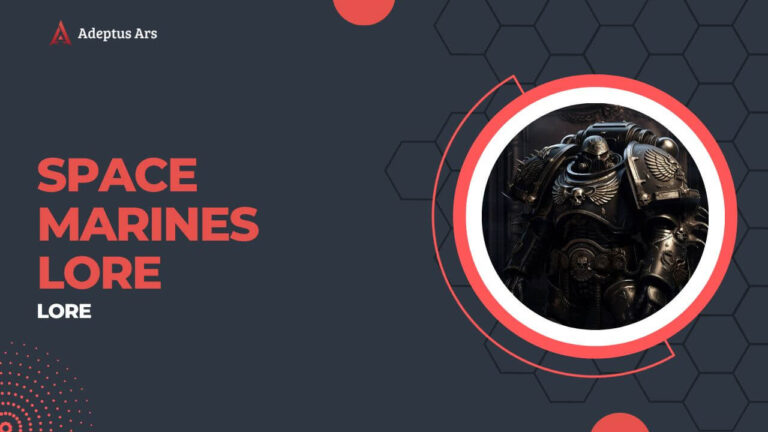Embark on a journey through the annals of the most formidable warriors of the Imperium, the Adeptus Astartes.
This guide is a beacon in the grim darkness of the far future, illuminating the history, traditions, and battles of the Emperor’s chosen protectors.
Prepare to immerse yourself in the comprehensive lore of the Space Marines.
Space Marines Lore: Table of Contents
Origins of the Adeptus Astartes
In the grim darkness of the far future, where war is eternal and peace a forgotten dream, the origins of the Adeptus Astartes, or Space Marines, stand as a monument to the Emperor of Mankind’s vision for a galaxy-spanning Imperium.
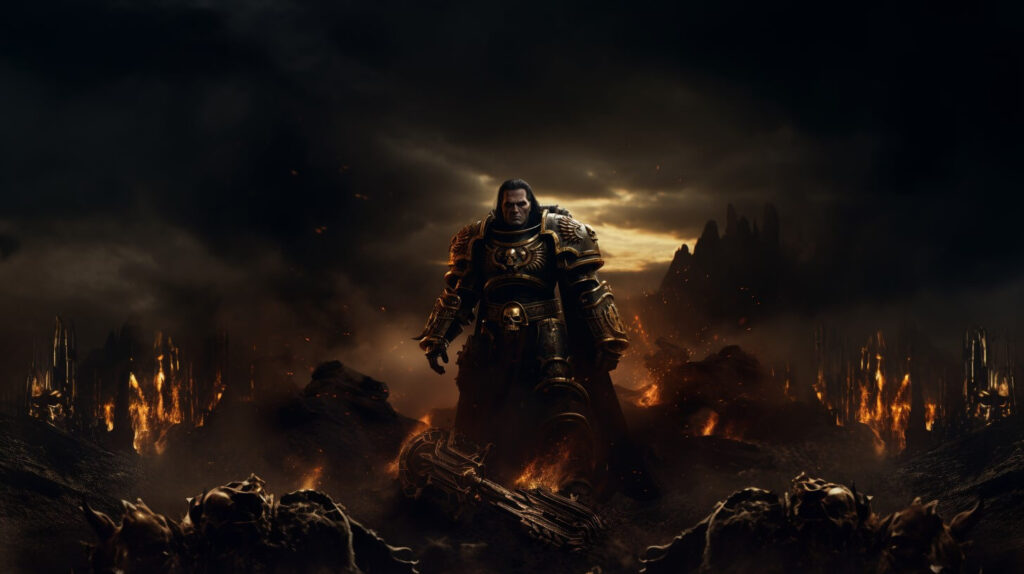
The inception of these superhuman warriors dates back to the late 30th Millennium during the Unification Wars on Terra, the cradle of humanity. The Emperor, a being of unfathomable power and wisdom, sought to create an elite fighting force capable of reclaiming the stars from the grip of darkness and barbarity.
To this end, He engineered the Primarchs, twenty peerless beings designed to be His generals and the genetic forebears of the Space Marines. However, a warp storm scattered the Primarchs across the galaxy, compelling the Emperor to initiate the next phase of His grand design: the creation of the Space Marines.
Utilizing the genetic template derived from the Primarchs, the Emperor crafted the gene-seed, the foundation of all Astartes physiology. From this gene-seed were born the Legiones Astartes, legions of genetically enhanced soldiers, each legion reflecting the traits of its Primarch progenitor.
These legions would go on to conquer the galaxy in the name of their undying Emperor, becoming legends in their own right. Yet, this golden age was not to last, as the greatest of the Emperor’s creations, Horus, fell to the corruption of Chaos, leading half the legions into the infamous betrayal known as the Horus Heresy.
This schism would forever alter the destiny of the Space Marines and the Imperium they fought to expand and protect, setting the stage for an eternal war that would rage across millennia.
The origins of the Adeptus Astartes are thus a saga of ambition, loyalty, and treachery, a narrative that underpins the very existence of the Imperium of Man and its ceaseless struggle against the encroaching darkness.
The Emperor’s Vision
The Emperor’s Vision was a bold and singular dream that sought to unify the scattered and war-torn human worlds under one banner, the Imperium of Man. It was a vision of order, progress, and ultimate supremacy in a universe rife with alien threats and the insidious taint of Chaos.
The Emperor, a being of ancient origin and immense psychic power, saw a future where humanity would not only survive but also dominate as the preeminent force in the galaxy.
His plan was to establish a realm governed by logic and empirical knowledge, eradicating the superstitions that had led mankind astray and plunged the galaxy into the Age of Strife.
This vision was to be realized through a monumental endeavor known as the Great Crusade, which would require warriors of unparalleled skill and loyalty: the Space Marines, the genetic sons of the Emperor himself.
Each Space Marine was an embodiment of the Emperor’s ideal, a perfect soldier in a crusade not just of conquest, but of enlightenment, where the lost technologies of the past would be reclaimed, and the psykers among humanity would be trained to serve the Imperium’s needs.
The Emperor’s vision was not merely the conquest of space, but the uplifting of the human condition, creating a galaxy-spanning civilization that would be a beacon of light and reason in a dark and hostile universe.
The Primarchs: Demigods of War
The Primarchs were the linchpins of the Emperor’s grand strategy, twenty superhuman beings engineered to be peerless in warfare, leadership, and statesmanship.
Each was a demigod of war, crafted from the Emperor’s own genetic material, representing the pinnacle of human potential and the embodiment of a particular aspect of the Emperor’s personality and prowess.
They were designed not only to be commanders of the Space Marine Legions but also to serve as the Emperor’s regents across the galaxy, each ruling over a segment of space and acting as a living symbol of the Emperor’s will and authority.
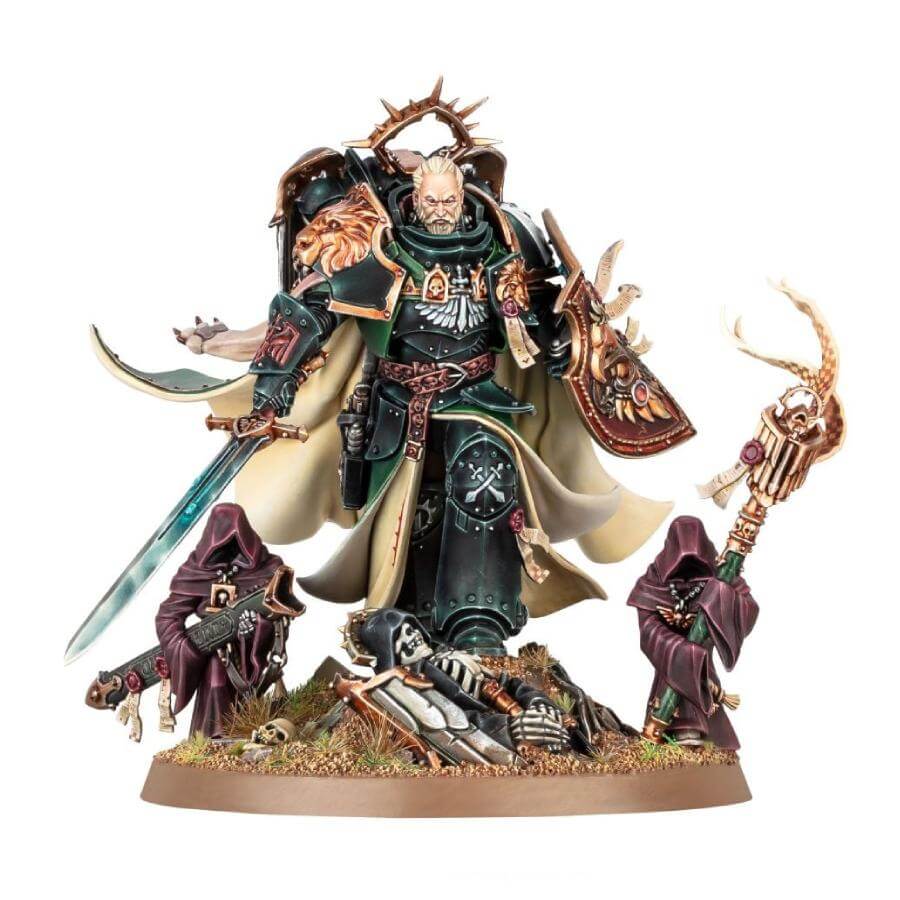
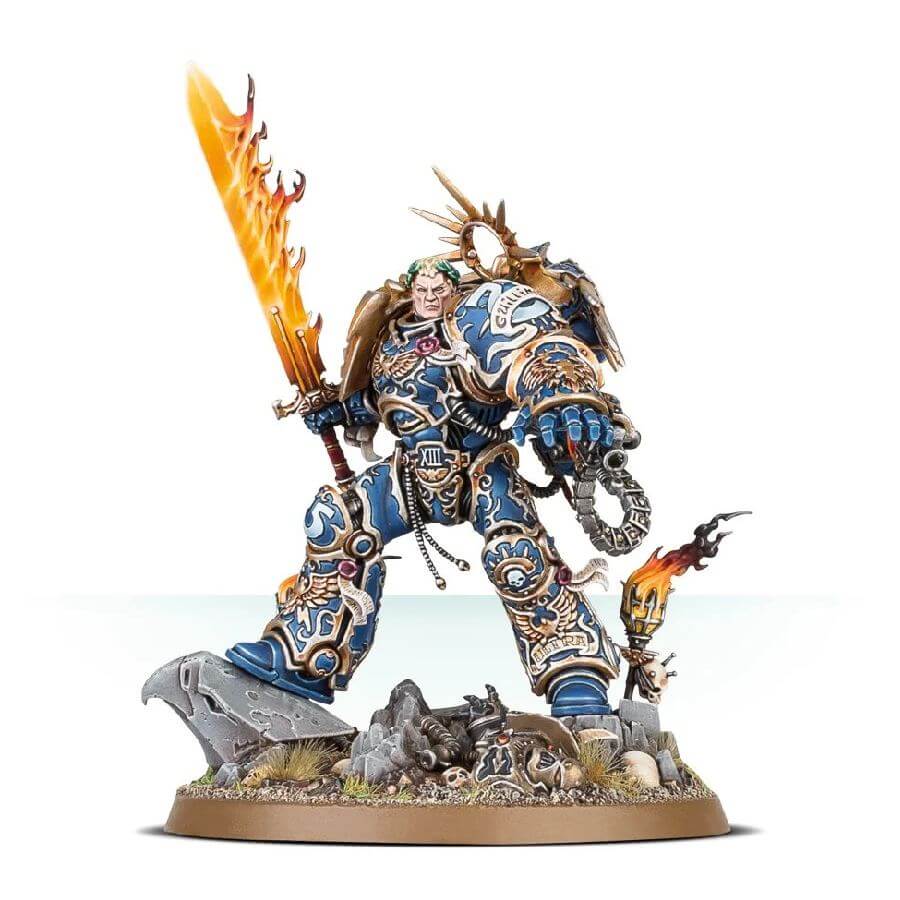
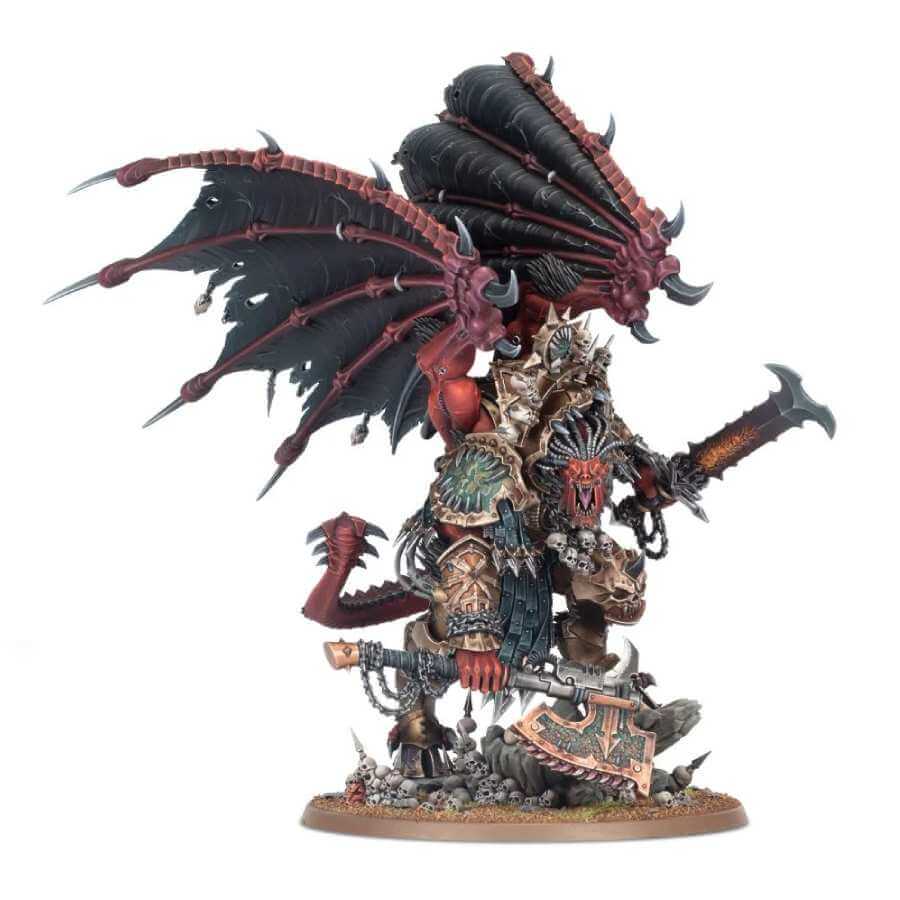
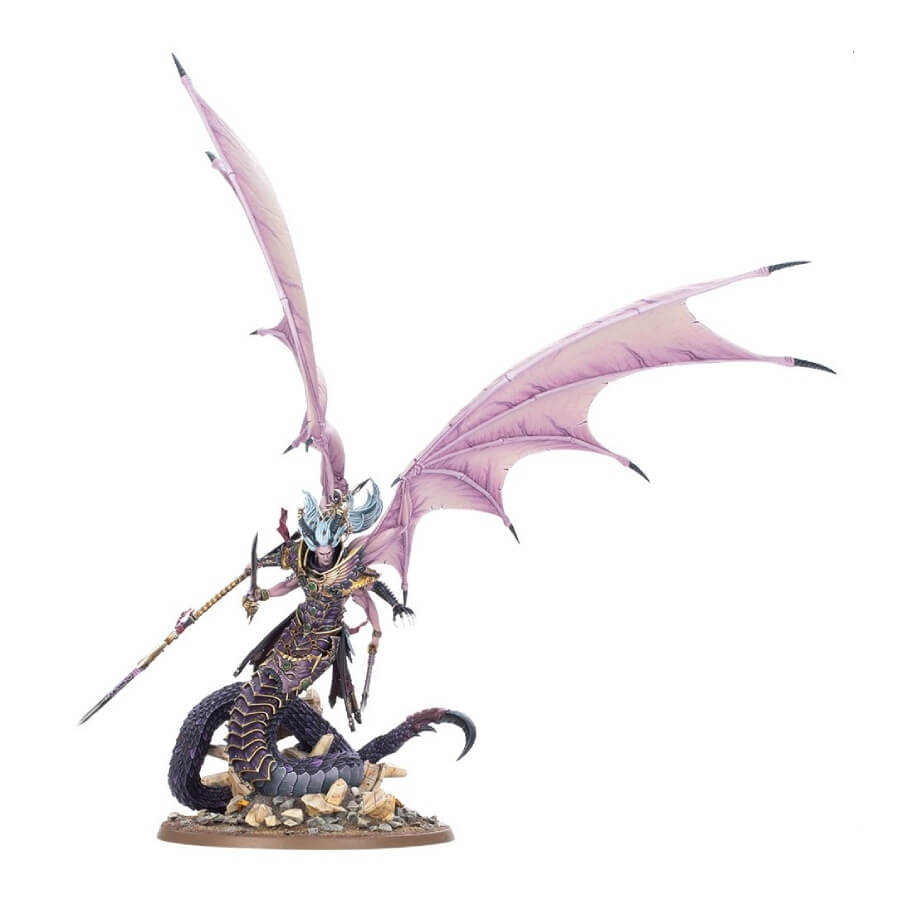
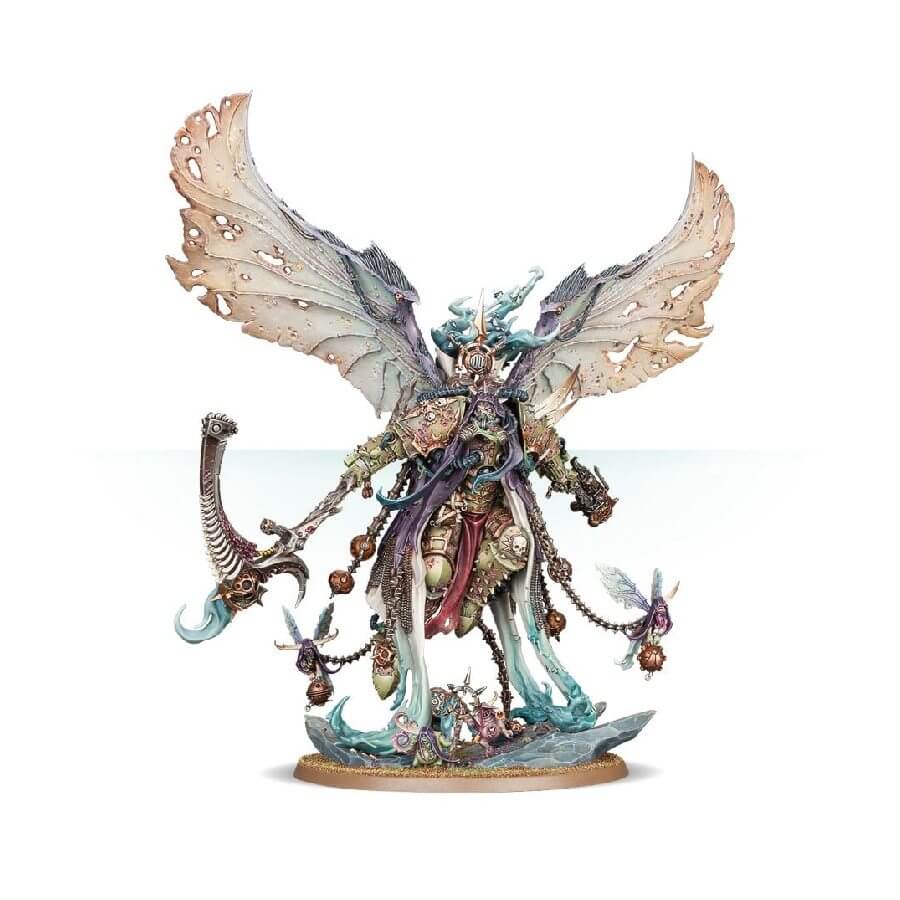
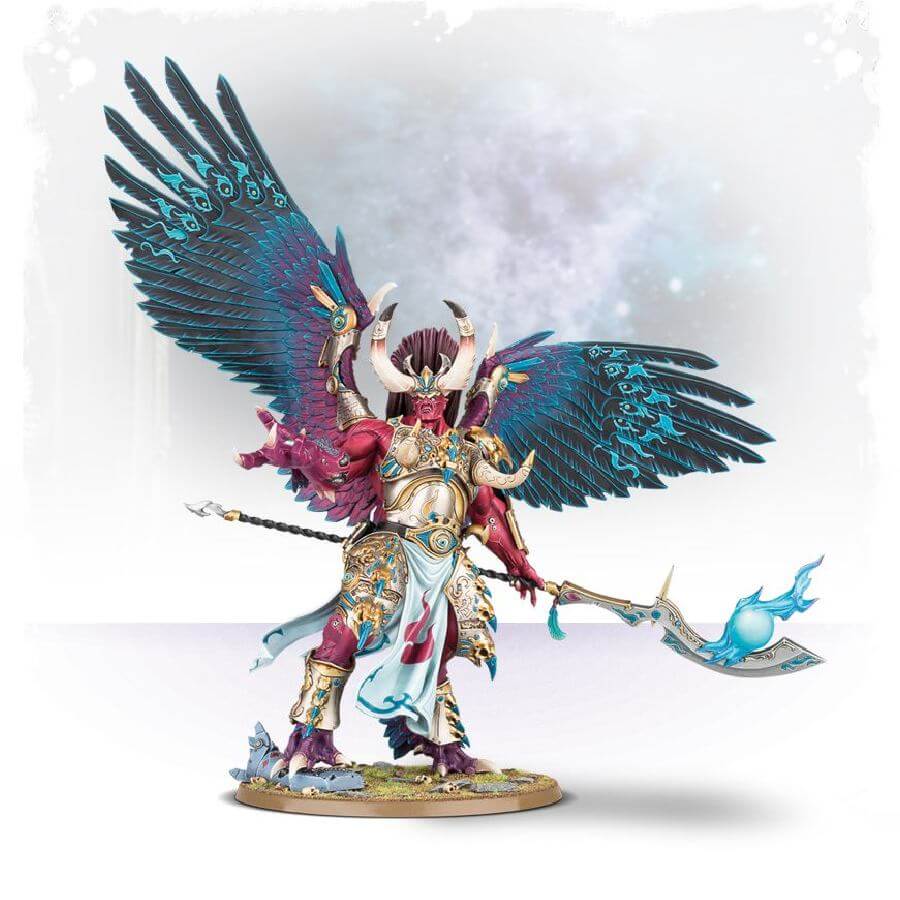
The creation of the Primarchs was a feat of bio-engineering without parallel, involving arcane science and warp-based technology. They were beings of immense physical strength, intellectual capacity, and psychic ability, each uniquely suited to their destined roles.
The Primarchs were to be the Emperor’s greatest triumph, the heralds of a new age for humanity. However, their fates were as varied as their personalities, with some becoming the greatest champions of the Imperium, while others would succumb to the temptations of Chaos, becoming its most ardent adversaries.
The tales of the Primarchs are sagas of heroism, tragedy, and the eternal struggle between predestination and free will. They were the Emperor’s sons, the princes of the universe, and their actions would forever shape the destiny of the Imperium, for better or for worse.
Their very existence was a testament to the Emperor’s vision, and their legacies would be written in the annals of the Imperium as both its saviors and its most profound betrayers.
The Gene-Seed: Creation of the Space Marines
The Gene-Seed represents the cornerstone of the Space Marines’ creation, a miraculous synthesis of genetic material that underpins their superhuman abilities. It is the genetic foundation that transforms a selected few into the Emperor’s Angels of Death.
Each Gene-Seed is unique, containing the genetic blueprint of one of the Emperor’s Primarchs, and by extension, a fragment of the Emperor’s own genetic code.
This arcane technology is the culmination of ancient science and genetic manipulation, enabling the replication of the Primarchs’ superior traits in their Space Marine progeny.
The creation of the Gene-Seed was a process shrouded in mystery and wonder, a secret art known only to the Emperor and his closest adepts. It involved isolating and cultivating the distinct genetic markers that defined each Primarch, then implanting them into human aspirants.
This process is not without its risks, as the Gene-Seed can mutate or become corrupted, leading to physical and psychological aberrations within a Chapter.
The Gene-Seed does more than just create warriors; it forges a spiritual and biological lineage that links the Space Marines to their Primarch and through him, to the Emperor.
Each Space Marine Chapter guards its Gene-Seed with utmost reverence, for it is not only the means of their creation but also the key to their future.
The Gene-Seed is carefully harvested from the progenoid glands of fallen Astartes, ensuring the continuity of the Chapter. It is a sacred trust, embodying the legacy and future of a Chapter, making it one of the most closely guarded treasures in the Imperium.
The First Founding: Birth of the Legions
The First Founding marks the genesis of the Space Marine Legions, the original twenty legions created by the Emperor of Mankind from the gene-seed of their respective Primarchs.
This historic event occurred during the final stages of the Unification Wars on Terra, the Emperor’s campaign to bring all of humanity under one rule.
Each Legion was crafted with a specific purpose in mind, embodying the traits and characteristics of its Primarch, and by extension, a facet of the Emperor’s own vision for humanity’s guardians.
The birth of the Legions was not merely a military expansion but a cultural and symbolic revolution. They were the Emperor’s wrath, his ambition, and his hope for the future made manifest in legions of superhuman warriors. They were to be the spearhead of the Great Crusade, the vast interstellar campaign to reunite the scattered remnants of humanity under a `single, enlightened government.
The First Founding Legions varied greatly in their tactics, culture, and approach to warfare and governance, reflecting the diverse natures of their Primarch progenitors.
From the stoic and relentless Ultramarines to the secretive and enigmatic Alpha Legion, each was a unique instrument in the Emperor’s grand orchestra of war.
They built upon the martial traditions of Terra, incorporating the genetic heritage of their Primarchs and the cultural idiosyncrasies of the worlds they would conquer and bring into the Imperium.
This founding was not only a military undertaking but also a grand experiment in engineered evolution, with each Legion destined to leave an indelible mark on the Imperium’s history.
Their deeds would be the stuff of legend, their names etched into the annals of the Imperium, and their legacy would endure through the Chapters that would later stem from their lines. The First Founding was the dawn of a new age for humanity, an age of heroes and conquests, hope and, ultimately, of tragic fallibility.
The Horus Heresy: Betrayal and Schism
The Horus Heresy stands as the most catastrophic and defining event in the history of the Imperium, a galaxy-spanning civil war that nearly tore humanity’s fledgling empire asunder.
It was a period marked by unprecedented betrayal and schism, where fully half of the Emperor’s Space Marine Legions turned against Him, led by Horus, the Warmaster and once the most trusted of all the Primarchs.
The Heresy was not just a rebellion but a fundamental questioning of the Emperor’s vision, a conflict that pitted brother against brother in a war that threatened to extinguish the light of the Imperium before it had fully dawned.
The seeds of the Heresy were sown long before the actual conflict erupted, rooted in the complex relationships between the Primarchs, the Emperor, and the nascent political structures of the Imperium.
Horus, elevated to the position of Warmaster and given command of the Great Crusade, was corrupted by the insidious powers of Chaos, which preyed upon his pride, ambition, and fears. His fall from grace was a tragedy that resonated across the stars, leading to a brutal and protracted conflict that would see untold billions dead, entire worlds burned, and the Imperium’s very foundations shaken.
The Horus Heresy reshaped the political, military, and spiritual landscape of the Imperium. It forced the Space Marine Legions to take sides, testing their loyalties and martial codes to the breaking point.
The Heresy saw the ruination of many of the Emperor’s greatest works and the loss of countless heroes and legends. It culminated in a siege of Terra itself, where Horus was finally slain, but at a grievous cost—the Emperor was mortally wounded and entombed within the Golden Throne, a life-sustaining device that now serves as His eternal prison and the Imperium’s beacon through the warp.
The aftermath of the Heresy led to the restructuring of the Imperium and the Space Marine Legions. The surviving loyalist Legions were broken down into smaller Chapters during the Second Founding, a move designed to prevent any one individual from commanding as much power as Horus had.
The Horus Heresy remains the darkest chapter in the Imperium’s history, a tale of heroism, hubris, and the perilous nature of power. It is a schism that continues to define the galaxy, its echoes felt in the endless wars that rage across the stars, a grim reminder of the eternal vigilance required to guard against the darkness within and without.
Anatomy of a Space Marine
The anatomy of a Space Marine is a marvel of bio-engineering, a fusion of human physiology and superhuman enhancements that create the ultimate warrior.
At the core of their being is the gene-seed, which imparts the genetic traits of the Primarchs and initiates the transformation of a selected human into a Space Marine. This process begins with the implantation of gene-seed organs, each designed to grant the Astartes their superhuman abilities.
- A Space Marine’s skeletal structure is reinforced with ceramite, making their bones nearly unbreakable. Their muscles are augmented with synthetic fibers that multiply their strength far beyond that of a normal human. The Black Carapace, a toughened layer of skin implanted into their torso, acts as a natural armor and serves as a neural interface with their Power Armour, allowing for seamless integration and enhanced battlefield responsiveness.
- The enhancements do not end with the physical appearance. Space Marines possess one additional heart, a third lung, and an organ called the Ossmodula, which allows their bones to knit together with incredible speed.
- Their Lyman’s Ear grants them resistance to disorientation and their Occulobe enhances their vision, allowing them to see in near-total darkness. The Betcher’s Gland enables them to spit a corrosive acid, which can be used to mark their armor or aid in digestion of inedible materials. The Progenoid Glands house the gene-seed itself, ensuring the legacy of the Astartes can continue as these glands are harvested from the fallen to create future generations of Space Marines.
- The Space Marine’s immune system is also enhanced; the Catalepsean Node allows them to enter a state of suspended animation, and the Haemastamen organ ensures their blood carries oxygen more efficiently, turning their skin a shade of pale blue. The Omophagea, known as the Remembrancer, allows a Space Marine to gain information, in the form of memories or skills, from consuming the flesh of a creature.
This combination of genetic modification, surgical enhancement, and psycho-conditioning creates a being who is not only a peerless warrior but also a symbol of the Emperor’s vision for a post-human defender of humanity.
The Space Marines Recruitment Process
The recruitment process for Space Marines is a rigorous and often lethal gauntlet, designed to select the finest human candidates for the arduous transformation into Astartes.
It is a journey that starts with the selection of aspirants, typically young males, though there are rare instances of female aspirants in certain non-canon depictions, from the feral, feudal, or hive worlds that the Chapters oversee. These aspirants are often chosen for their exceptional qualities, such as strength, intelligence, and above all, the capacity for loyalty and courage.
The process begins with a series of trials, which can vary greatly from Chapter to Chapter, reflecting the cultural and combat philosophies of each. These trials are not only physical but also psychological and spiritual.
They may include tests of combat, endurance, and the ability to survive in hostile environments. For some Chapters, the trials are steeped in the traditions and rituals of the world from which they recruit, while for others, they are standardized procedures honed over millennia.
Those who survive the trials are then subjected to a battery of genetic, psychological, and spiritual examinations to ensure their suitability. The compatibility with the gene-seed is paramount, as is the mental resilience to endure the subsequent implantation process and psycho-indoctrination. The aspirants are often pitted against one another, with only the strongest, smartest, and most resilient surviving to the next stage.
Upon passing these initial tests, the aspirants become neophytes, entering into the first phase of their transformation. They undergo the implantation of the gene-seed organs, a process that occurs in stages and can take many years.
During this time, they are constantly monitored for signs of mutation or psychological instability, which can result in the neophyte’s termination or, in rare cases, assignment to the Chapter’s serfdom.
Throughout this period, the neophytes are trained in the arts of war, indoctrinated in the culture and history of their Chapter, and taught the values of the Imperium.
They learn to fight, to obey without hesitation, and to kill without remorse. The training is as much about breaking down the individual and rebuilding them as a part of the Chapter as it is about enhancing their combat abilities.
The final stage of recruitment is the Scout Company, where the neophytes serve in combat alongside fully-fledged Space Marines. Here they prove their worth on the battlefield, applying their training and enhancements in real-world conditions.
Those who survive and prove their mettle are eventually granted the title of Battle-Brother, fully initiated Space Marines, and given their Power Armour, marking their ascension and their readiness to serve as the Emperor’s angels of death.
The recruitment process is a crucible that forges the most elite warriors of the Imperium. It is a system designed to ensure that only the most capable and dedicated of humanity’s sons are given the honor and the burden of the Astartes mantle.
The List of Gene-Seed Implants
The gene-seed implants are the core of the Space Marine creation process, a series of 19 genetic enhancements that, when implanted into a human adolescent, will eventually transform them into a superhuman Astartes.
Each implant corresponds to an organ or system within the body and serves a specific function in the development of the Space Marine. The process is delicate and dangerous, requiring surgical precision, a deep understanding of gene-seed science, and a neophyte’s body that is strong enough to endure the changes.
- Secondary Heart (The Maintainer): This is often the first implant, acting as a backup heart and boosting blood supply — essential for supporting the other implants.
- Ossmodula (The Ironheart): This implant strengthens the skeleton by inducing bone growth and fusing the ribcage into a solid, bulletproof plate.
- Biscopea (The Forge of Strength): Situated in the chest cavity, it massively enhances muscle growth throughout the body.
- Haemastamen (The Blood Maker): This implant works with the second heart, enhancing the oxygen-carrying capacity of the blood.
- Larraman’s Organ (The Healer): It releases cells that clot blood instantly and promote rapid healing, reducing the chances of death by blood loss.
- Catalepsean Node (The Unsleeping): Implanted into the brain, it allows a Space Marine to go without sleep, or to remain alert while in a sleep-like state.
- Preomnor (The Neutralizer): This is essentially a pre-stomach that can neutralize otherwise harmful substances before they enter the true stomach.
- Omophagea (The Remembrancer): This organ allows a Space Marine to gain information, such as memories or genetic traits, by consuming an enemy’s flesh.
- Multi-lung (The Imbiber): A third lung that allows a Space Marine to breathe in toxic environments and directly absorb oxygen from water.
- Occulobe (The Eye of Vengeance): Enhances vision, allowing a Space Marine to see in low light conditions and improving their aim.
- Lyman’s Ear (The Sentinel): This organ grants a Space Marine resistance to disorientation and the ability to consciously filter out or enhance certain sounds.
- Sus-an Membrane (The Hibernator): Allows a Space Marine to enter a state of suspended animation, particularly useful if they suffer from a grievous wound.
- Melanochrome (The Skinshield): Linked to the pigment cells of the skin, it can protect the Space Marine from harmful radiation and other environmental hazards.
- Oolitic Kidney (The Purifier): This organ can detoxify the Space Marine’s blood and is activated when the Multi-lung detects toxins.
- Neuroglottis (The Devourer): Enhances taste to the point where a Space Marine can track his quarry by taste alone and detect poisons or other chemicals.
- Mucranoid (The Weaver): Allows a Space Marine to sweat a substance that can temporarily seal his skin against vacuum.
- Betcher’s Gland (The Poison Bite): Enables a Space Marine to spit a blinding, corrosive acid.
- Progenoid Glands (The Gene-seed): These two glands (one in the neck, one in the chest) mature the gene-seed for later harvesting, to create new Space Marines.
- Black Carapace (The Interface): The last implant, it hardens the skin and serves as a port for interfacing directly with Space Marine power armor.
The Black Carapace: Interface of War
The Black Carapace, known also as the Interface, is the final and one of the most significant gene-seed implants received by a neophyte in the process of becoming a Space Marine.
It is the ultimate fusion of flesh and machine, a bio-engineered organ that lies beneath the skin, typically grafted onto the torso during the last stages of a neophyte’s transformation into a full Astartes.
This implant is unique in that it serves as a direct neural link between the Space Marine and his Power Armour. The Black Carapace hardens upon implantation, integrating with the nervous system so that the armour becomes a seamless extension of the Space Marine’s body. Electro-conductive nerve bundles are woven into the hardened, chitinous material, which then interfaces with the suit’s systems.
When a Space Marine dons his armour, connection ports in the armour align with corresponding nodules on the Black Carapace, allowing for direct control.
This connection is so profound that a Space Marine can sense through his armour almost as if it were his natural skin, feeling the ground under his boots, the tension in his gauntlets, and even the proximity of enemy fire.
The reaction times of a Space Marine are thus greatly enhanced, and their ability to maneuver in their bulky armour appears effortless and fluid, despite the heavy protection it offers.
The Black Carapace is what sets a fully initiated Space Marine apart from a neophyte or a mere human soldier. It is the culmination of the long and painful process of becoming an Astartes, symbolizing the warrior’s readiness to serve as one of the Emperor’s chosen. Without it, Power Armour cannot be used to its full potential, and the superhuman abilities of a Space Marine would be notably diminished.
The implantation of the Black Carapace is a rite of passage, marking the moment when a neophyte truly becomes a Space Marine. It is a time-honored tradition that is as much a part of the Astartes’ identity as their vows and their weapons.
The Librarius: Psykers Amongst the Ranks
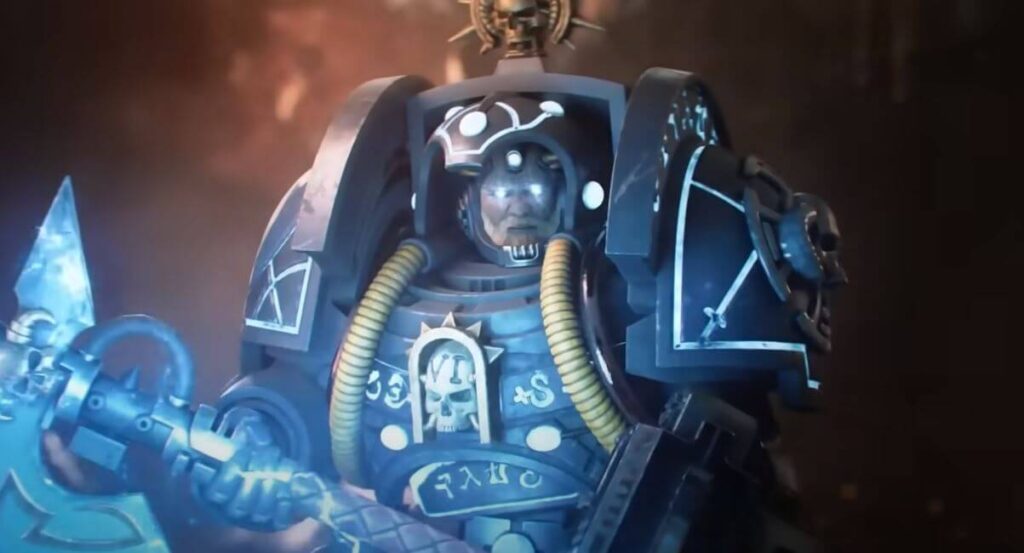
The Librarius is a specialized division within a Space Marine Chapter that harnesses the psychic abilities of certain Astartes, known as Librarians.
These psykers are a rare and powerful asset, capable of wielding the warp’s energies to cast devastating spells, reinforce the minds of their brothers, and protect against the psychic assaults of the enemy.
The presence of psykers within the ranks of the Astartes is a matter of some controversy within the Imperium, given the inherent dangers of the warp and the potential for corruption by Chaos. However, the benefits provided by the Librarians are deemed essential to the strategic and tactical supremacy of the Space Marines.
Librarians undergo rigorous training and scrutiny, far beyond that of their battle-brothers, to ensure their psychic powers do not lead them astray. They are warriors as much as they are seers, combining their psychic might with the martial prowess of a Space Marine.
The Librarius itself is often a brotherhood within the brotherhood, with its own traditions, hierarchies, and rituals designed to strengthen the minds and spirits of its members against the perils they face.
The Chief Librarian, often a member of the Chapter’s command, oversees the Librarius and is responsible for the training and deployment of Librarians in the field.
He is also the guardian of the Chapter’s accumulated psychic lore, which is stored within the Librarium, a repository of forbidden knowledge, arcane tomes, and prophetic texts.
Librarians are identifiable by their distinctive blue armor and the psychic hoods they wear, which serve to amplify their powers and protect them from hostile psykers.
They are equipped with force weapons — such as swords, axes, or staves — that channel their psychic energy into lethal blows capable of cutting through the toughest armor or disrupting the life force of their foes.
The role of the Librarius is multifaceted; Librarians serve as advisors to their Chapter Masters, using their foresight to guide the Chapter’s destiny. They are also the vanguard against the Immaterium’s threats, countering the dark sorceries of Chaos and the psychic entities of the warp.
The existence of the Librarius within a Chapter is a delicate balance of power and peril. The Librarians must constantly guard against the lure of the warp, for even the mightiest psyker can fall victim to its seductions. The Librarius, therefore, is not just a military unit but a sacred brotherhood, charged with safeguarding the souls of its members while unleashing their psychic might in defense of the Imperium.
The Apothecarion: Medicine and Genetics
The Apothecarion is the medical and genetic wing of a Space Marine Chapter, a crucial component in the maintenance of the Astartes’ superhuman physiology and the preservation of their precious gene-seed. It is here that the Chapter’s Apothecaries, the bio-engineers and medics of the Adeptus Astartes, ply their trade, combining the roles of surgeon, geneticist, and battlefield medic.
Apothecaries are responsible for monitoring the health and well-being of their fellow Space Marines, treating injuries that would be fatal to lesser men, and ensuring that the gene-seed of each Astartes is pure and viable for future generations.
They carry out their sacred duty with a mixture of advanced medical technology, psychic healing techniques, and an intimate knowledge of the Astartes’ enhanced anatomy.
The Apothecarion is also where the gene-seed is harvested from fallen Space Marines. This is perhaps the most vital role of the Apothecaries, as the gene-seed is the very essence of a Space Marine, containing the zygotes necessary to create new organs for neophytes. The gene-seed must be extracted from the progenoid glands of a Space Marine before his death or shortly thereafter, a task often carried out in the midst of battle.
In addition to their medical duties, Apothecaries are charged with conducting the genetic screening of potential recruits to ensure their compatibility with the gene-seed. They oversee the implantation process, carefully monitoring the neophytes’ development and making any necessary adjustments to ensure the successful integration of the new organs.
The Apothecarion itself is a sterile environment, filled with advanced medical equipment, gene-culturing vats, and stasis chambers for the most critically injured. It is a place of quiet compared to the clamor of the Chapter’s barracks and training grounds, yet it is no less vital to the Chapter’s martial prowess.
The Apothecaries themselves are marked by their white armor and the red crosses that signify their role as healers. They carry nartheciums, sophisticated medical kits that include tools for surgery, gene-seed extraction, and the administration of the Emperor’s Peace — a mercy killing for those Astartes who are beyond even their ability to save.
Brotherhood of the Stars
The concept of the “Brotherhood of the Stars” encapsulates the spiritual and fraternal bond that unites all Space Marines across the vastness of the Imperium. Despite the immense distances that separate their fortress-monasteries and the myriad battlefields upon which they fight, the Astartes share a common purpose and brotherhood that transcends planets, systems, and even the vast gulfs of space between the stars.
This brotherhood is forged through shared trials and the rigors of the transformation process that all Space Marines undergo. From the grueling recruitment and implantation of the gene-seed organs to the indoctrination of the Chapter’s culture and the Primarch’s legacy, the Space Marines are molded to be more than just soldiers; they are brothers-in-arms, united in a cause greater than any individual.
The Brotherhood of the Stars is also a reflection of the Space Marines’ role as the protectors of humanity’s scattered empire.
They are the Emperor’s chosen, the Angels of Death, and they carry the weight of this sacred duty together. Their shared sense of purpose is a bond stronger than steel, a commitment to each other and to the Imperium that they defend with their lives.
In battle, this brotherhood is a tangible force, as Space Marines fight not just for victory, but for the survival and honor of their brothers. The loss of a single Astartes is mourned by the entire Chapter, and the deeds of the fallen are remembered for centuries.
The brotherhood extends beyond death, with the gene-seed of the fallen being carefully harvested and returned to the Apothecarion, ensuring that the legacy of each brother lives on in the warriors of the future.
The Brotherhood of the Stars also has a spiritual dimension, as the Space Marines see themselves as part of a divine mission ordained by the Emperor Himself
. They are the guardians of His realm, and their faith in the Emperor and in each other is unshakeable. This spiritual connection is reinforced by the Chaplains, who minister to the Space Marines’ souls and ensure that their faith remains strong.
Despite the differences between Chapters, such as divergent customs, tactics, and interpretations of the Codex Astartes, the Brotherhood of the Stars remains a unifying force. In times of great need, Chapters will come to each other’s aid, standing shoulder to shoulder against the enemies of mankind. This inter-Chapter fellowship is exemplified in the gatherings of the High Lords of Terra and in the councils of war where Chapter Masters convene.
The Brotherhood of the Stars is, therefore, not just a military alliance but a fundamental aspect of what it means to be a Space Marine. It is a cosmic fraternity that spans the galaxy, a commitment to a shared destiny, and a constant reminder that no Space Marine fights alone.
Chapter Organization
Chapter organization within the Adeptus Astartes is a complex and highly structured system that ensures the effectiveness and doctrinal purity of each Space Marine Chapter.
While there can be significant variations in the organization, traditions, and combat doctrine from one Chapter to another, most follow the Codex Astartes — the great tome penned by Roboute Guilliman, the Primarch of the Ultramarines, in the aftermath of the Horus Heresy. The Codex serves as a guideline for the structure, tactics, heraldry, and other aspects of Space Marine Chapters.
A Standard Space Marines Chapter Structure:
- Chapter Command: At the top of the hierarchy is the Chapter Master, who holds command over the entire Chapter. He is often a veteran of countless battles and is supported by a retinue of officers including the Chapter’s Chief Librarian, Master of the Forge, Master of the Sanctity (head Chaplain), Master of the Apothecarion, and the Chapter Champion.
- Companies: A standard Codex-compliant Chapter is divided into ten companies, each with its own specialization and role within the Chapter.
- 1st Company: Comprised of the elite Veterans, often equipped with Terminator armour and tasked with the most dangerous missions.
- 2nd-5th Companies: These are Battle Companies, each a balanced force of Tactical, Assault, and Devastator squads.
- 6th-7th Companies: Reserve Companies filled with Tactical squads, ready to reinforce the Battle Companies as needed.
- 8th Company: Comprised of Assault squads, specializing in close-quarters combat and rapid assaults.
- 9th Company: Made up of Devastator squads, the heavy fire support of the Chapter.
- 10th Company: The Scout Company, where neophytes are trained and prove their worth before becoming full Battle-Brothers.
- Specialist Ranks and Formations:
- Techmarines: Trained by the Adeptus Mechanicus to maintain the Chapter’s war gear.
- Apothecaries: Responsible for the medical care of the Chapter and the preservation of the gene-seed.
- Chaplains: Spiritual leaders who maintain the faith and morale of the Chapter.
- Librarians: Psykers who use their powers for the benefit of their brothers and to combat the enemies of mankind.
- Support Staff: A Chapter also includes a vast number of non-combat personnel, such as serfs, servitors, and Chapter serfs (often failed aspirants or those who serve the Chapter in a civilian capacity).
- Fleet Assets: Space Marine Chapters maintain their own fleets, including Battle Barges, Strike Cruisers, and various support vessels, enabling them to project their power across the galaxy.
- Armoury: The Armoury is responsible for the Chapter’s stockpile of weapons, armour, and vehicles. It is overseen by the Master of the Forge and staffed by Techmarines and servitors.
- Chapter Serfs: Non-Astartes personnel who perform various functions within the Chapter, from maintenance to administration.
Non-Codex Chapters:
Some Chapters, such as the Space Wolves and the Black Templars, do not adhere strictly to the Codex Astartes. These Chapters often have unique structures that reflect their particular traditions and combat doctrines. For example, the Space Wolves are organized into Packs, which are analogous to squads but follow the cultural practices of the Fenrisian warriors.
The organization of a Chapter is more than just a military hierarchy; it is a sacred order that reflects the Chapter’s history, beliefs, and the vision of its Primarch. It ensures that the Chapter functions as a cohesive and effective force, whether defending the Imperium’s borders or prosecuting a full-scale war in the Emperor’s name.
The Codex Astartes: Rules of Engagement
The Codex Astartes, authored by the Primarch Roboute Guilliman, is the doctrinal guidebook of the Space Marines, detailing everything from organizational charts to company heraldry.
Among its many teachings, the Codex provides comprehensive rules of engagement, which dictate how a Chapter should conduct itself in war. These rules are not just tactical and strategic doctrines but also encompass the moral and ethical standards expected of a Space Marine.
Strategic Deployment:
- Force Distribution: The Codex advises on the optimal distribution of Astartes forces, emphasizing the importance of flexibility and the ability to respond to multiple threats simultaneously.
- Reserve Forces: It dictates maintaining reserve forces to exploit enemy weaknesses or reinforce engaged units.
- Theoreticals and Practicals: A method of planning and executing operations, where all possible scenarios (“theoreticals”) are considered and the most appropriate responses (“practicals”) are applied.
Tactical Doctrines:
- Combat Formations: The Codex outlines specific formations for various types of warfare, from siege assaults to defensive stands.
- Target Prioritization: Guidelines for identifying and neutralizing key enemy assets to disrupt their command and control.
- Flexibility in Command: While the Codex provides a framework, it also emphasizes the need for commanders to adapt to the fluid nature of battle.
Psychological Warfare:
- Fear and Morale: The Codex includes strategies for undermining enemy morale and using fear as a weapon, while also detailing how to maintain the morale of Space Marine forces.
- Propaganda: Guidelines for the use of propaganda to demoralize the enemy and rally support among Imperial citizens.
Rules of Engagement:
- Discipline: Space Marines are expected to maintain discipline at all times, following orders without question.
- Civilians: The Codex includes provisions for minimizing civilian casualties and protecting the innocent, reflecting the Space Marines’ role as protectors of humanity.
- Prisoners of War: While the treatment of captives is rarely detailed, the Codex likely includes protocols for dealing with enemy combatants who surrender.
Ethical Conduct:
- Honour: The Codex upholds the concept of honor in warfare, promoting fair combat and the respect of foes.
- Compliance with the Imperial Creed: Space Marines are expected to adhere to the tenets of the Imperial Creed, upholding the spiritual and cultural laws of the Imperium.
Adaptation and Interpretation:
- Chapter Variations: While the Codex is revered, Chapters may interpret its rules differently, leading to variations in their rules of engagement.
- Non-Codex Chapters: Some Chapters, like the Space Wolves, do not follow the Codex strictly and have their own codes of conduct in battle.
The Codex Astartes’ rules of engagement are not just tactical guidelines but a philosophy that shapes the very identity of a Space Marine. It is a comprehensive system that seeks to balance the need for ruthless efficiency in war with the moral imperative to protect the Imperium and its citizens. In the hands of a capable commander, the Codex is a powerful tool, one that has guided the Space Marines through ten thousand years of conflict.
Notable Space Marines Chapters
The Space Marines, also known as the Adeptus Astartes, are divided into numerous Chapters, each with its own history, traditions, and battlefield specializations.
While there are over a thousand such Chapters, some have earned particular renown through their actions and their storied histories.
Here are several of the most notable:
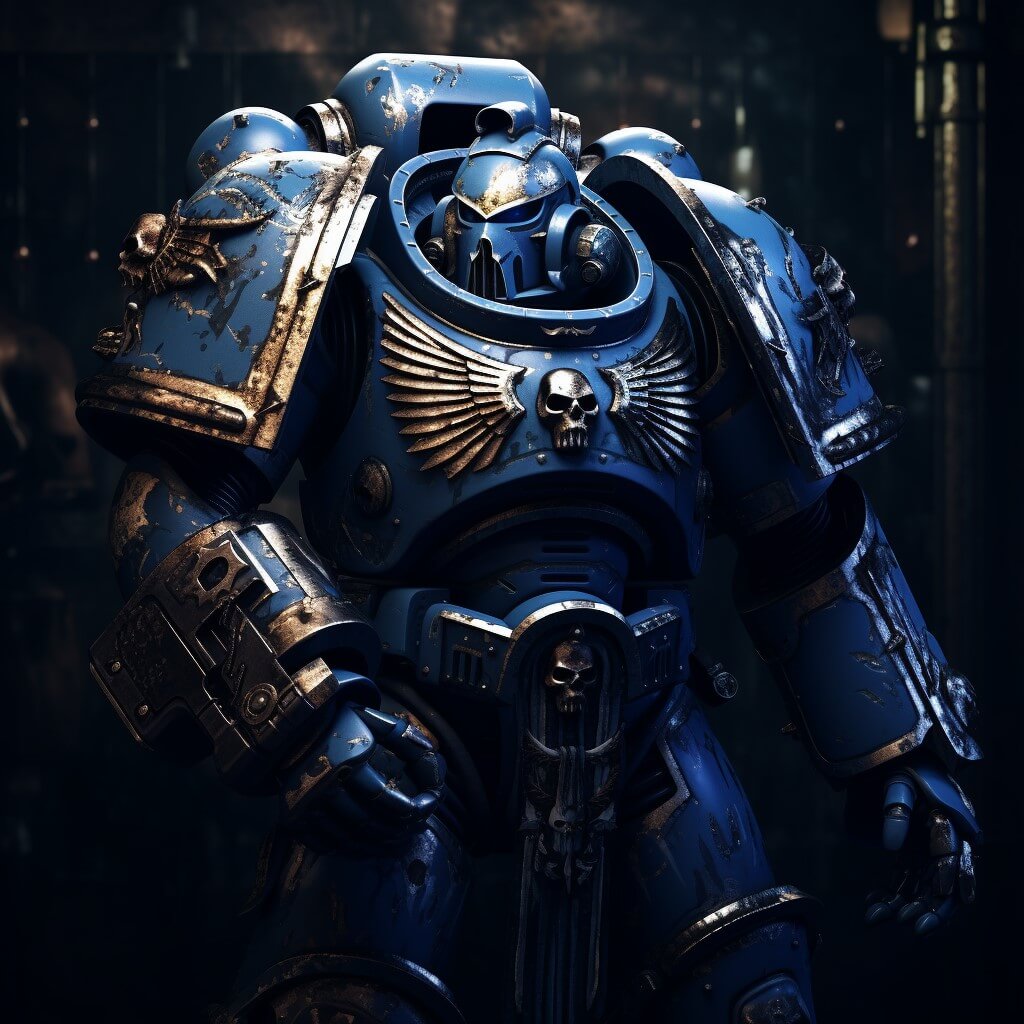
Ultramarines
Primarch: Roboute Guilliman
Homeworld: Macragge
Notable for: Being the exemplars of the Codex Astartes, the Ultramarines are known for their tactical versatility and strict adherence to their Primarch’s teachings. They are one of the largest and most heroic Chapters, having played a pivotal role in the defense of the Imperium throughout its history.
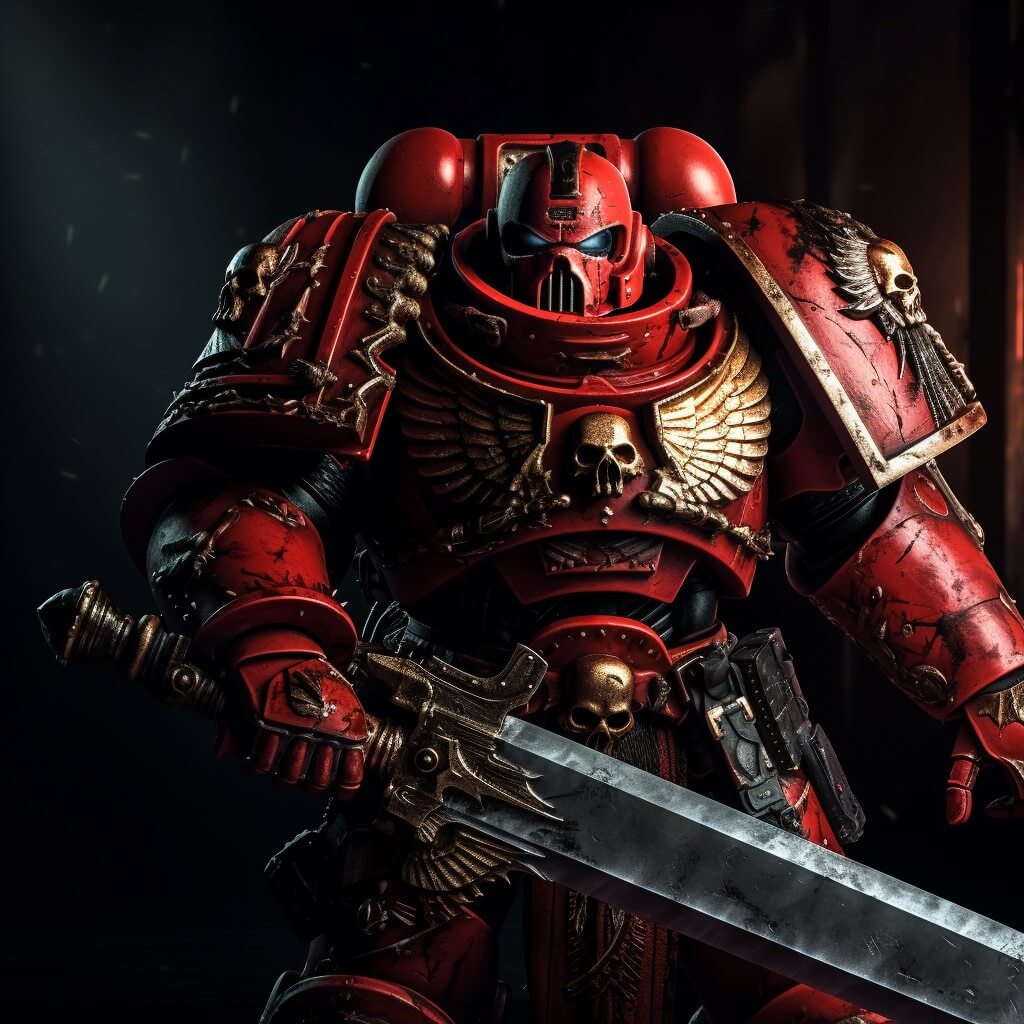
Blood Angels
Primarch: Sanguinius
Homeworld: Baal
Notable for: The Blood Angels are both noble and tragic. They are known for their artistic and architectural contributions to the Imperium, as well as their ferociousness in combat, particularly in close-quarters battle. They suffer from the genetic flaw known as the Red Thirst and the Black Rage, which can drive them into a berserk fury.
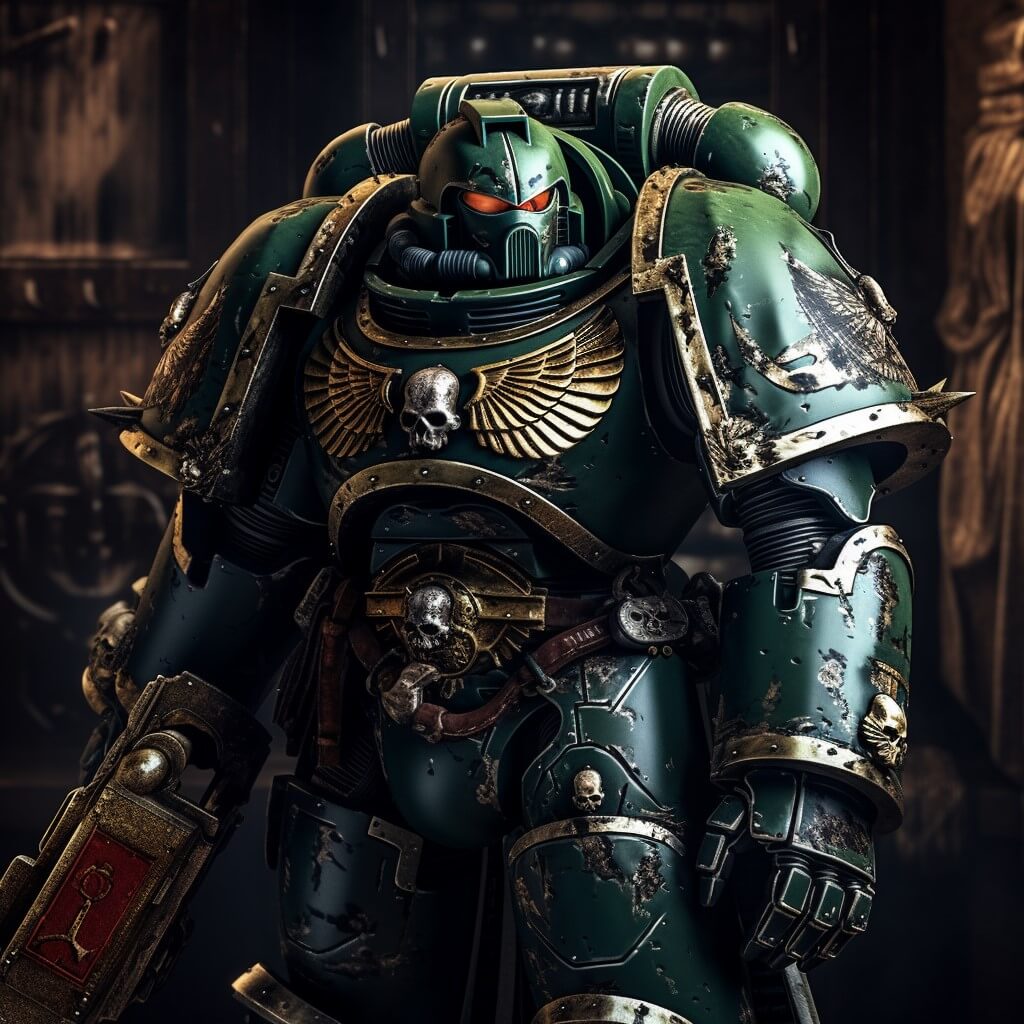
Dark Angels
Primarch: Lion El’Jonson
Homeworld: Caliban (destroyed)
Notable for: The Dark Angels are shrouded in mystery and are relentless in their hunt for the Fallen – those members of their Chapter who turned traitor ten millennia ago. They are known for their secrecy and for having some of the best-equipped companies in the Imperium, including the elite Deathwing and Ravenwing formations.
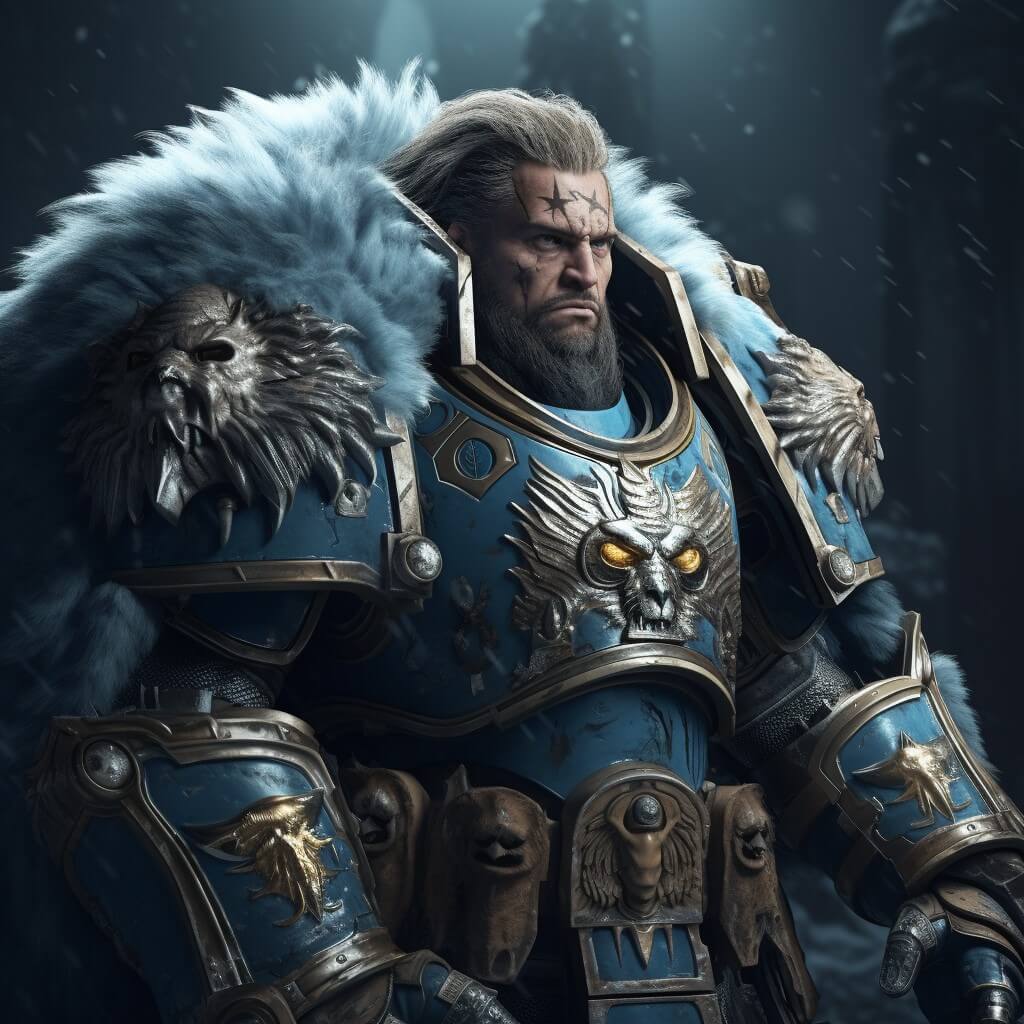
Space Wolves
Primarch: Leman Russ
Homeworld: Fenris
Notable for: The Space Wolves are fierce warriors with a strong sense of honor and brotherhood, drawing heavily from the Viking culture of their icy homeworld. They are known for their ferocity in battle, their resistance to the Codex Astartes’ structure, and their unique organization into Packs.
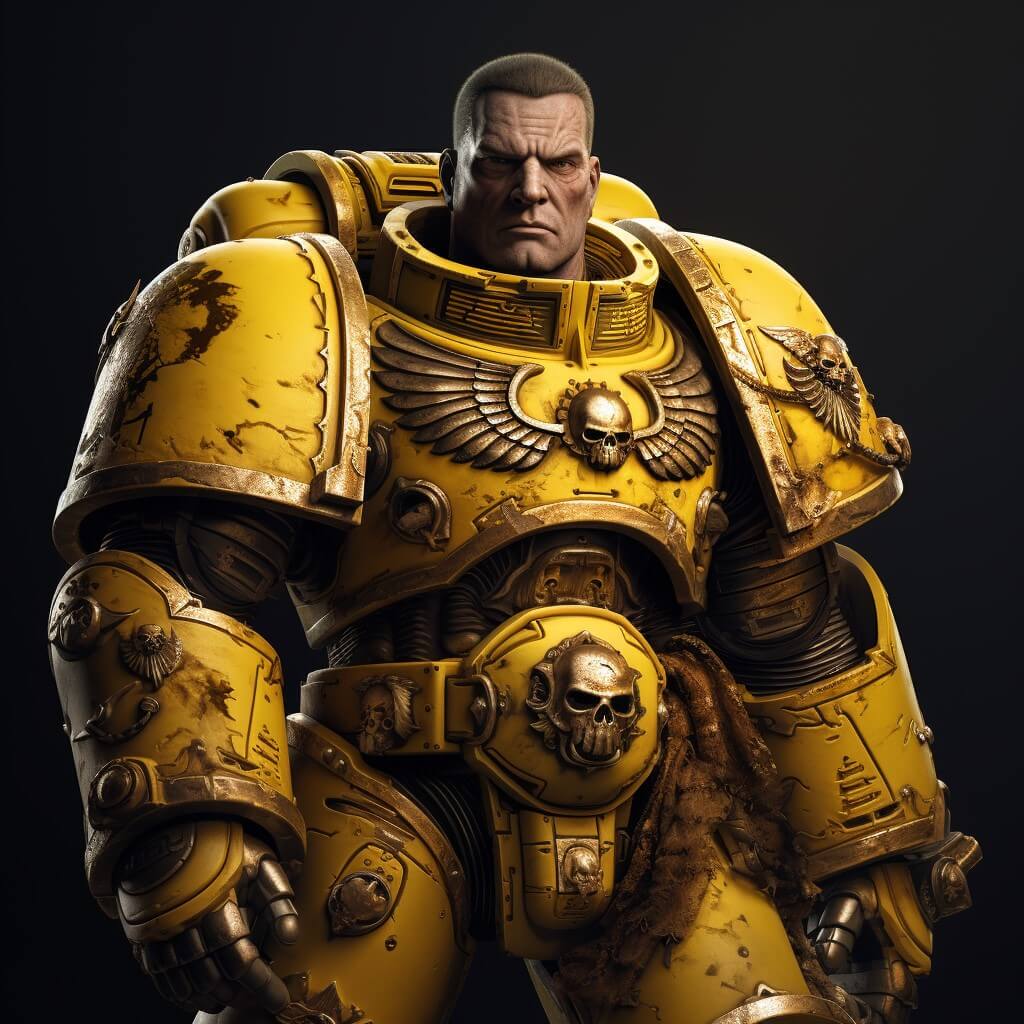
Imperial Fists
Primarch: Rogal Dorn
Homeworld: Terra (originally), Phalanx (mobile fortress-monastery)
Notable for: The Imperial Fists are siege masters and unparalleled defensive strategists. They are stoic, resilient, and have a close relationship with the Adeptus Terra and the Inquisition. Their ancestral home is the Phalanx, a massive star fortress.
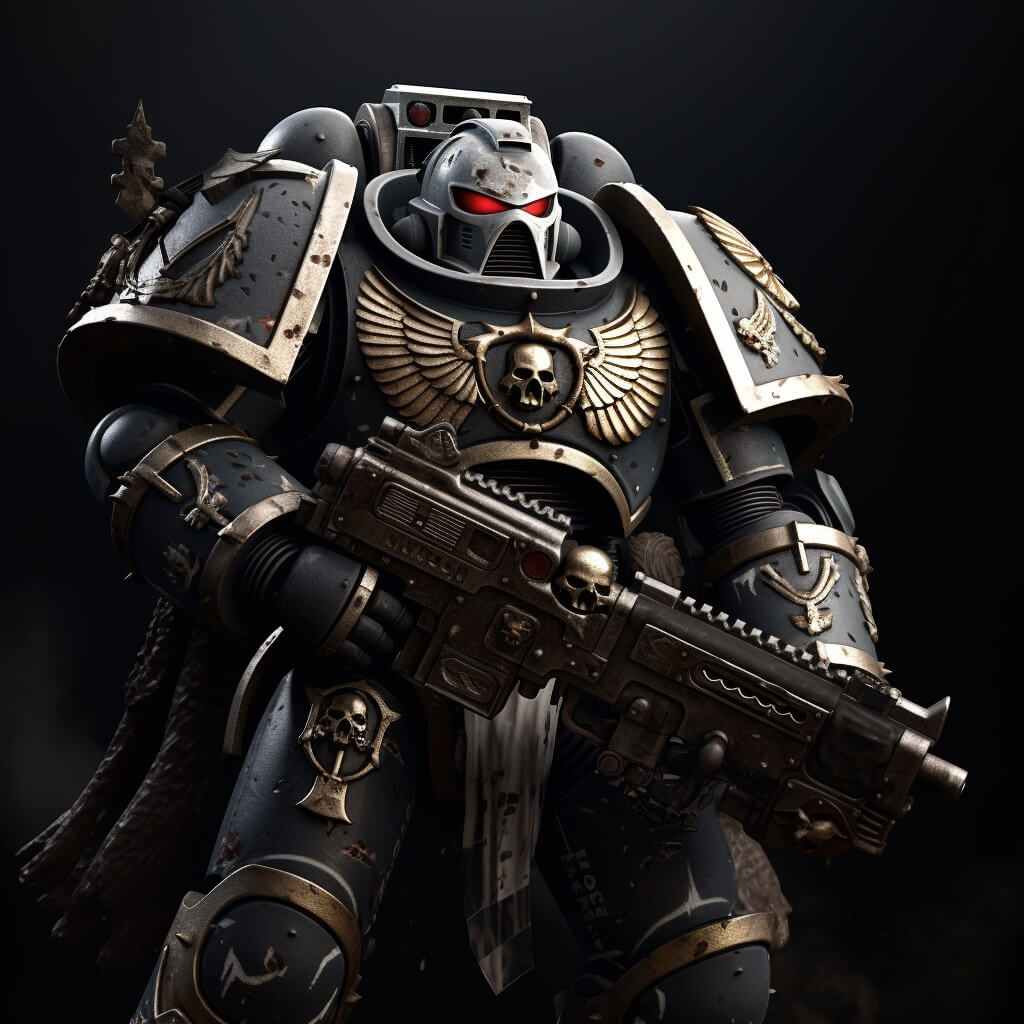
Black Templars
Primarch: Rogal Dorn (shared lineage with the Imperial Fists)
Homeworld: Fleet-based
Notable for: The Black Templars are zealous crusaders, known for their fervent worship of the Emperor and their eternal Crusade to defend the Imperium from its enemies. They do not adhere to the Codex Astartes, instead organizing their forces into Crusades.
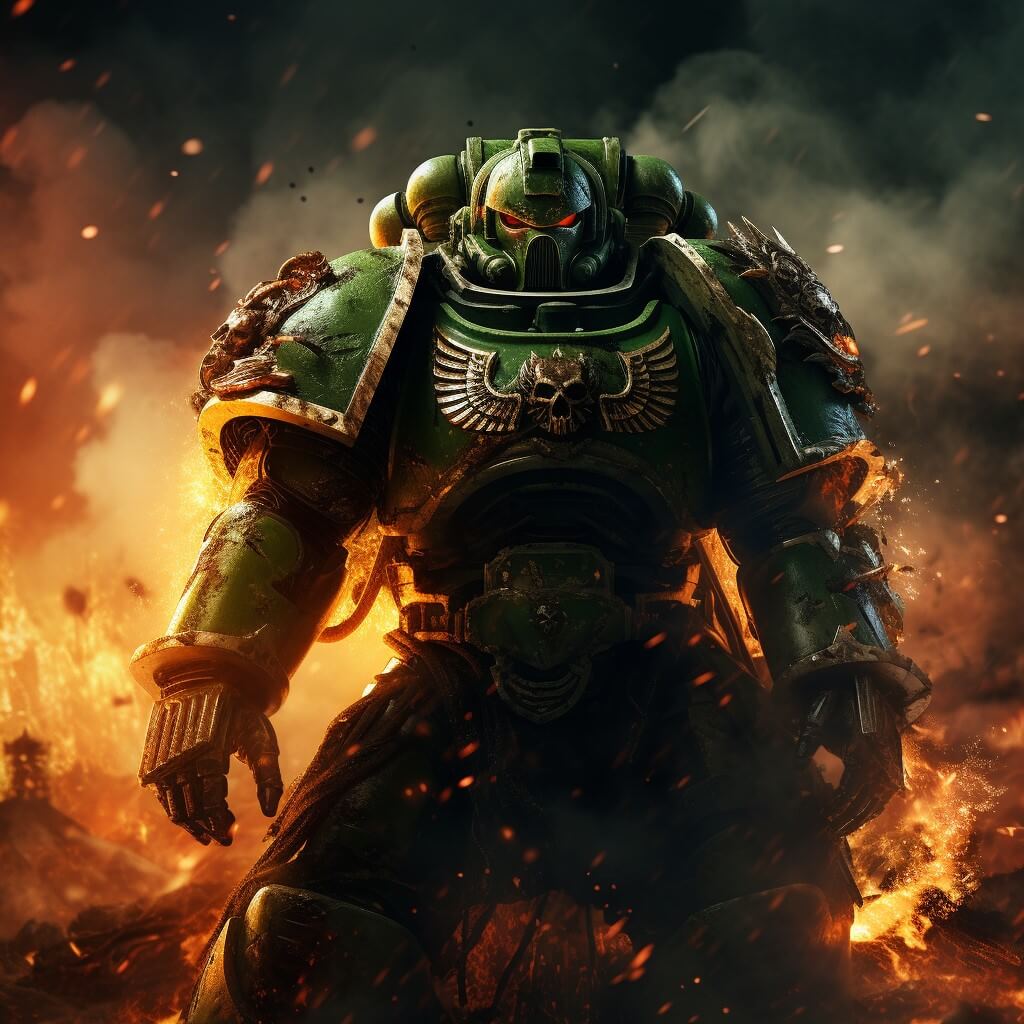
Salamanders:
Primarch: Vulkan
Homeworld: Nocturne
Notable for: The Salamanders are known for their craftsmanship, creating some of the finest weapons and wargear in the Imperium. They have a strong sense of kinship and are renowned for their concern for civilian lives, often going to great lengths to protect the innocent.
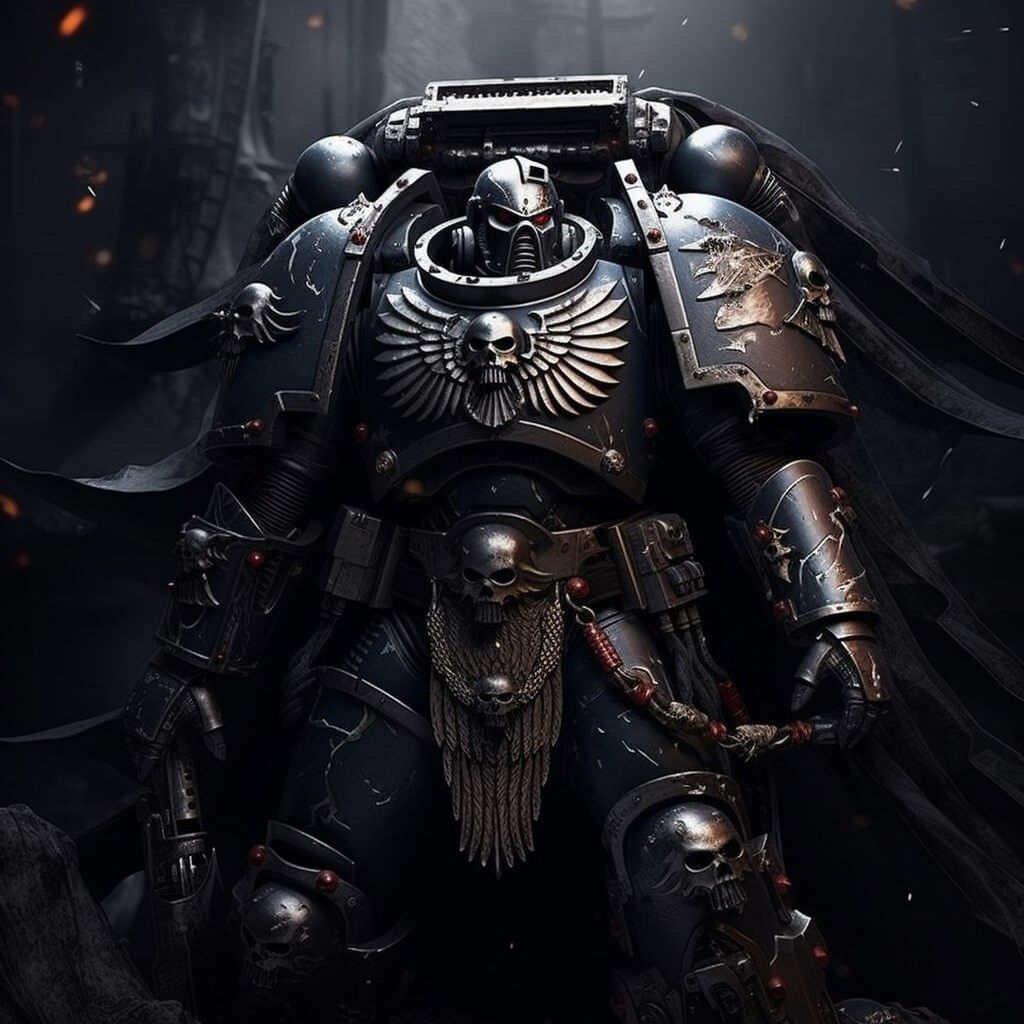
Raven Guard
Primarch: Corax
Homeworld: Deliverance (originally Kiavahr)
Notable for: The Raven Guard are masters of stealth, guerrilla warfare, and rapid strikes. They prefer to strike from the shadows, sowing confusion and disarray among their enemies before disappearing into the darkness.
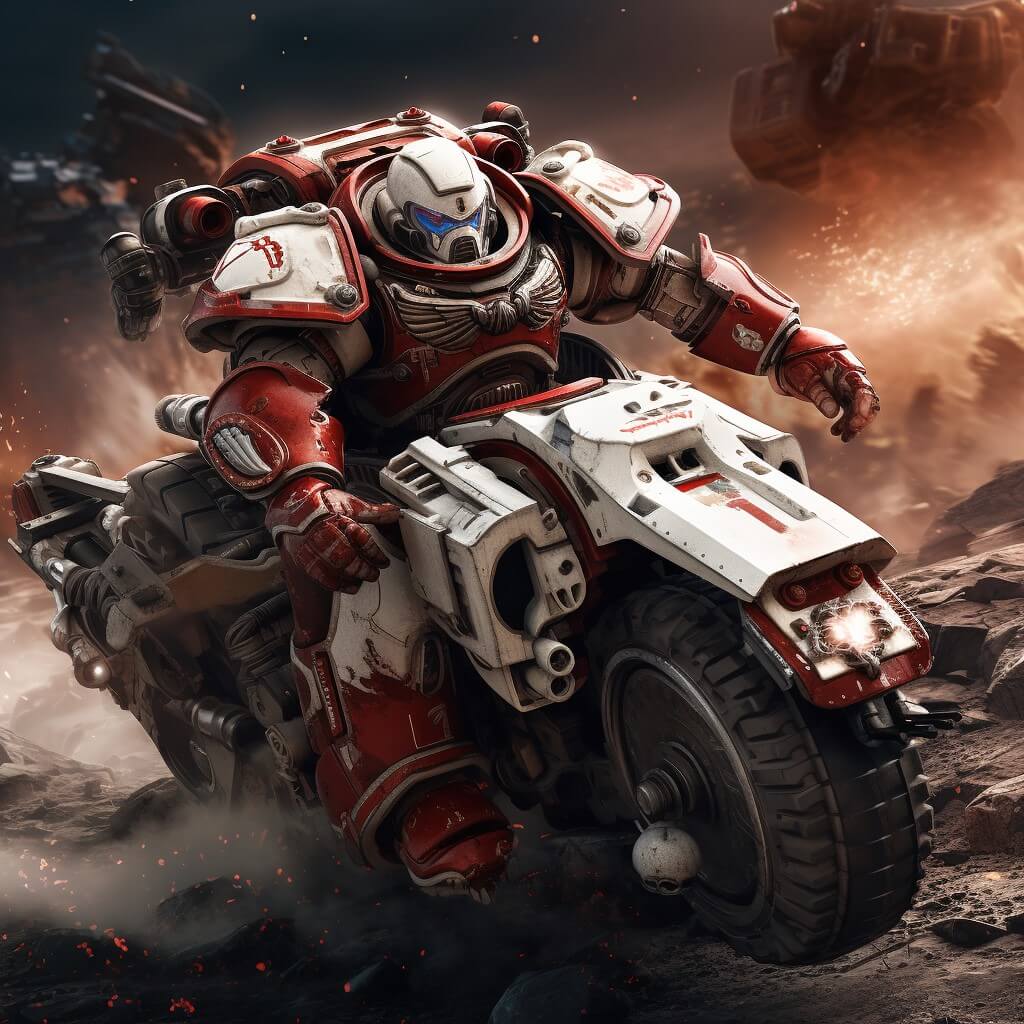
White Scars
Primarch: Jaghatai Khan
Homeworld: Chogoris
Notable for: The White Scars are fast-attack specialists, favoring hit-and-run tactics and lightning strikes. They draw heavily from the Mongol culture of their homeworld, with a focus on mobility and horsemanship (translated into their use of bikes and land speeders).
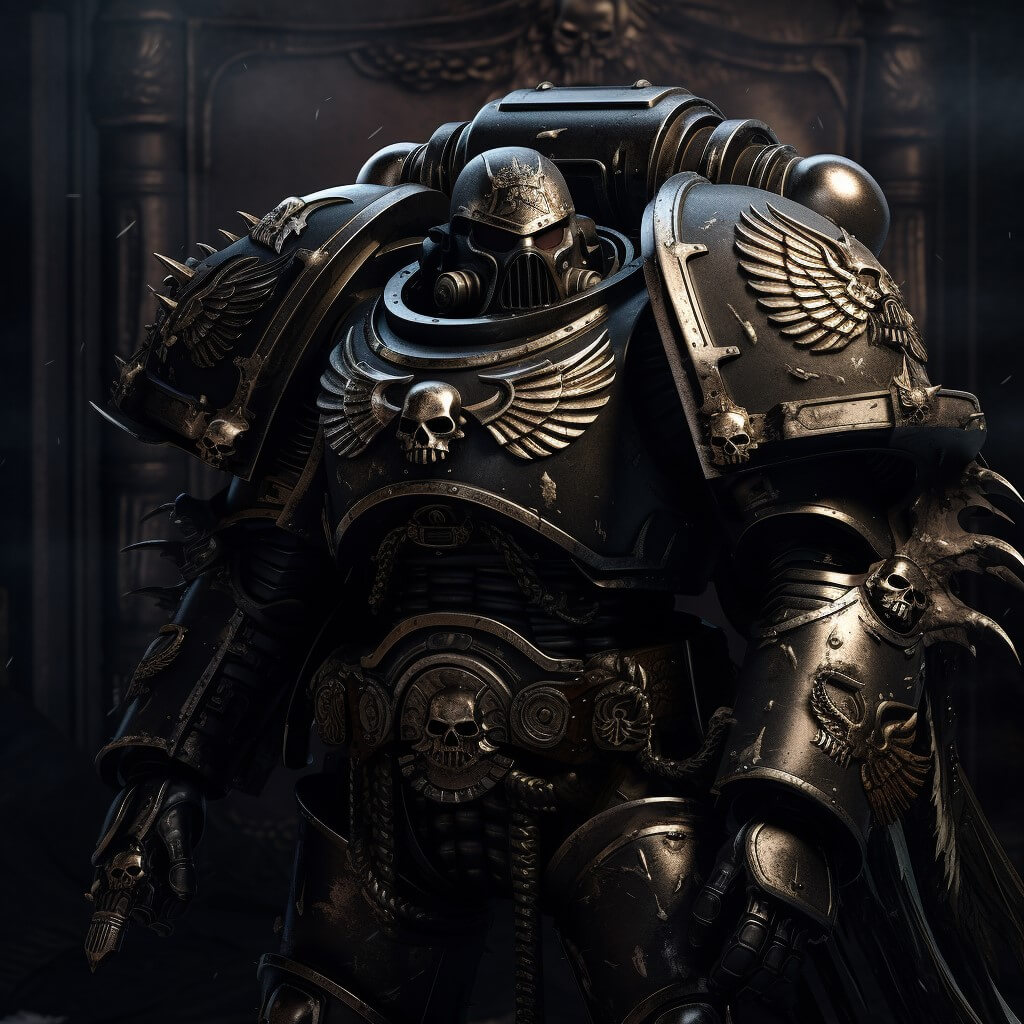
Deathwatch
Primarch: Various
Homeworld: Watch Fortress Erioch (among others)
Notable for: The Deathwatch is not a Chapter per se but a special organization drawn from all Chapters. They are the Ordo Xenos’ Chamber Militant, specializing in fighting the alien menace wherever it may arise
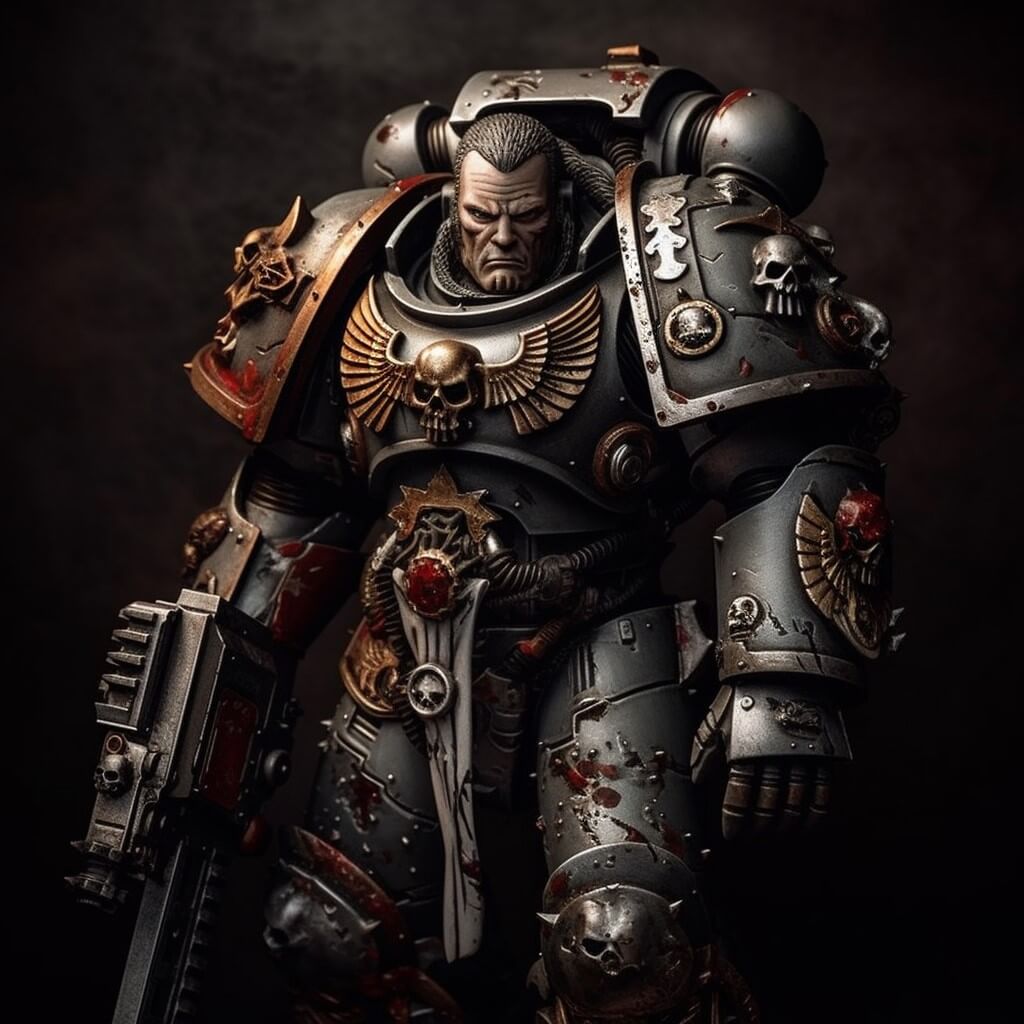
The Grey Knights: Daemon Slayers
Homeworld: Titan
Notable for: The Grey Knights are the Imperium’s most formidable and secretive Chapter of Space Marines, specifically created to combat the daemonic and the warp-touched. They are the Chamber Militant of the Ordo Malleus, the branch of the Inquisition charged with hunting down and eradicating the daemonic wherever it may manifest.
Each of these Chapters has a storied past and a distinct culture that sets them apart from their brethren. Their deeds are legendary, their names inspire awe and fear, and their heroes are celebrated across the Imperium.
Whether they strictly adhere to the Codex Astartes or follow their own ancient traditions, each Chapter contributes to the Imperium’s defense in its unique way.
The Arsenal of the Adeptus Astartes
The Arsenal of the Adeptus Astartes is a vast and varied collection of weaponry, armor, vehicles, and relics that the Space Marines employ to wage war across the galaxy.
This arsenal is not only a testament to the technological might of the Imperium but also to the adaptability and tactical diversity of the Space Marines. Here is an overview of the key elements that comprise the armory of the Emperor’s finest warriors.
Power Armour:
- Variants: From the ancient and revered Mark I “Thunder” armor to the state-of-the-art Mark X used by the Primaris Marines, each suit of power armor is a masterwork of defense and utility.
- Features: Power armor is environmentally sealed, capable of withstanding the vacuum of space and the most toxic atmospheres. It enhances the strength and resilience of its wearer and is equipped with life support and auto-senses.
Weapons:
- Bolters: The iconic boltgun, or bolter, is a high-velocity, gyrojet weapon that fires self-propelled explosive rounds capable of penetrating most enemy armor.
- Special Weapons: This category includes plasma guns, which fire superheated matter, meltaguns that emit intense heat capable of breaching the thickest armor, and flamers for clearing out entrenched foes.
- Heavy Weapons: Devastator Squads often wield heavy weapons such as lascannons, missile launchers, heavy bolters, and multi-meltas to engage enemy armor and fortifications.
- Melee Weapons: Chainswords, power swords, power fists, and thunder hammers are among the close-combat weapons that allow Space Marines to be as lethal in melee as they are at range.
Vehicles:
- Rhinos: The Rhino APC is the mainstay transport of the Space Marines, capable of rapidly deploying a squad across the battlefield.
- Predators: Based on the Rhino chassis, the Predator is a tank that can be outfitted with autocannons and lascannons for anti-armor roles or heavy bolters for anti-infantry support.
- Land Raiders: The most heavily armored and potent of the Space Marine vehicles, the Land Raider can transport Terminator squads and is equipped with lascannons and heavy bolters.
- Bikes and Land Speeders: For rapid assault and hit-and-run tactics, Space Marines utilize bikes and Land Speeders, which offer swift and agile options for flanking and harassment.
Aircraft:
- Thunderhawk Gunships: Capable of both atmospheric and space flight, Thunderhawks serve as transports and gunships, able to deliver Space Marines into the heart of battle and provide close air support.
- Stormravens and Stormtalons: These versatile aircraft are used for air superiority, close air support, and rapid insertion of troops.
Dreadnoughts:
- Venerable Machines: Dreadnoughts are walking tanks that house the mortally wounded heroes of the Chapter, allowing them to continue fighting for the Emperor even after their bodies have failed.
- Variants: There are several types of Dreadnoughts, including the traditional Castraferrum pattern, the more ancient and revered Contemptor pattern, and the Redemptor pattern used by Primaris Marines.
Relics and Artifacts:
- Chapter Relics: Many Chapters have unique weapons and items of power that are steeped in history and tradition, such as the Ultramarines’ Gauntlets of Ultramar or the Salamanders’ Vulkan’s Sigil.
- Standard of the Emperor Ascendant: The sacred banners and standards carried into battle are not only symbols of the Chapter’s honor but also provide spiritual and combat bonuses to the Space Marines.
Wargear and Equipment:
- Combat Shields and Storm Shields: These protective devices range from the smaller combat shields to the larger storm shields, which are capable of deflecting even the most potent of enemy attacks.
- Grenades and Explosives: Space Marines have access to a variety of grenades, including frag, krak, and specialized variants like melta bombs for use against heavily armored targets.
The arsenal of the Adeptus Astartes is a key factor in their ability to act as the Imperium’s elite rapid response force. Each weapon and piece of equipment is maintained with religious fervor, treated not just as tools of war but as sacred relics of the Chapter. With this arsenal, the Space Marines stand ready to face any threat to humanity, whether it be from traitors, xenos, or the powers of the warp.
Power Armour: Suits of the Ancients
Power Armour is the quintessential garb of the Space Marines in Warhammer 40K, a combination of superlative defense systems, life support, and mobile weapons platform. These suits are not merely armor but a fusion of the most advanced technologies the Imperium of Man can produce, each piece an heirloom passed down through the ages, steeped in history and the glory of past deeds.
Historical Significance:
- Ancient Lineage: Power Armour suits are often centuries old, with some dating back to the time of the Great Crusade and the Horus Heresy. They are maintained by the Chapter’s Techmarines and treated with almost religious reverence.
- Marks of Distinction: The evolution of Power Armour through different Marks tells the story of the Imperium’s technological progression and the shifting tides of war.
Design and Functionality:
- Ceramite Plating: The primary material in Power Armour is ceramite, a composite ceramic material that is incredibly resistant to heat and energy-based weapons, making it ideal for the rigors of space combat and alien environments.
- Exoskeleton: The suit includes an internal exoskeleton that augments the Space Marine’s already considerable strength and speed, allowing them to operate heavy weapons with ease and survive blows that would destroy lesser beings.
- Auto-senses: Incorporated into the helmet are advanced sensor suites that provide full-spectrum scanning, target acquisition, and threat identification, enhancing a Space Marine’s natural senses.
Spiritual and Ritualistic Aspects:
- Blessed Armaments: Each suit is often consecrated and blessed by the Chapter’s Chaplains, embedding them with spiritual significance and making them anathema to the forces of Chaos and the Warp.
- Heraldry: Power Armour is typically adorned with the iconography of the Space Marine’s Chapter, personal heraldry, and purity seals, each marking the Marine’s vows and the blessings of the armour.
Specialized Variants:
- Terminator Armour: Reserved for the most veteran of Space Marines, Terminator Armour provides unparalleled protection and is typically used in the most hazardous of combat zones, such as boarding actions and teleportation assaults.
- Scout Armour: Less encumbering than full Power Armour, Scout Armour allows neophyte Space Marines better mobility and the ability to learn the arts of stealth and reconnaissance.
Integration with the Marine:
- The Black Carapace: The last and one of the most critical implants a Space Marine receives is the Black Carapace, which lies beneath the skin and interfaces directly with the Power Armour, effectively making the suit a second skin that responds instantly to the Marine’s movements.
Customization for Roles:
- Command Variants: Higher-ranking Space Marines, such as Captains and Chapter Masters, often wear uniquely crafted suits that are both a status symbol and a repository of the Chapter’s greatest technological relics.
- Specialist Loadouts: Certain roles within a Chapter, like Techmarines or Apothecaries, have their Power Armour modified to suit their specific battlefield functions.
Primaris Upgrades:
- Mark X Armour: The advent of the Primaris Marines brought with it a new generation of Power Armour. The Mark X combines the best features of its predecessors with new technology, providing greater protection and flexibility, and is modular in design, allowing for rapid reconfiguration to suit any combat role.
Power Armour is more than just a Space Marine’s battle gear; it is a symbol of their unyielding duty, a vessel for their honor, and a testament to the technological might of the Imperium. Each suit is a legacy, a piece of history, and a sacred relic that embodies the spirit of the Adeptus Astartes.
Weapons of War: Bolters, Chainswords, and More
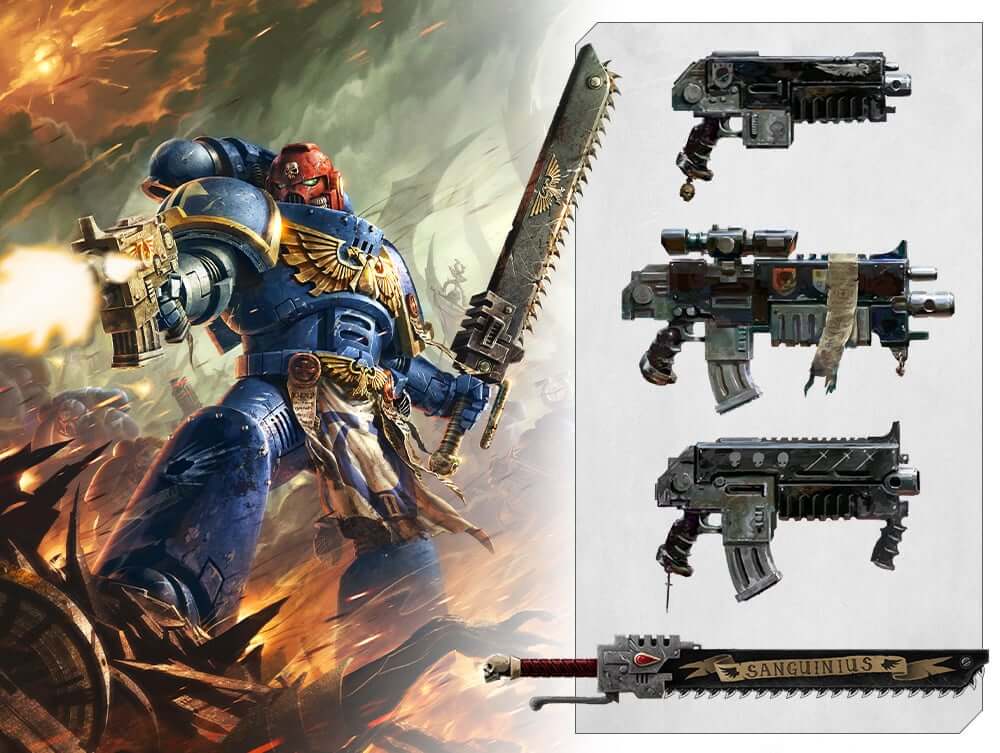
The Space Marines of Warhammer 40K are equipped with a vast array of weapons, each designed for a specific purpose and all iconic in their destructive capacity. The most common and emblematic of these are the bolter and chainsword, but the arsenal of the Adeptus Astartes extends far beyond these storied weapons.
Bolters:
- Godwyn Pattern Bolter: The standard-issue bolter for Space Marines, firing .75 caliber self-propelled rounds called bolts, which explode with devastating effect inside the target.
- Bolt Pistol: A sidearm version of the bolter, offering the same explosive firepower in a more compact form, suitable for close-quarters combat.
- Storm Bolter: A double-barreled bolter capable of unleashing a torrent of bolts, often used by Terminator squads and during boarding actions.
Chainswords:
- Standard Chainsword: A sword with motorized, monomolecular teeth capable of tearing through flesh and bone with ease, it is as much a symbol of a Space Marine’s role as a warrior as it is a weapon.
- Eviscerator: A larger, two-handed version of the chainsword, capable of cutting through armor and even light vehicles.
Special Weapons:
- Plasma Guns: High-risk, high-reward weapons that can unleash searing blasts of superheated plasma, capable of melting through the toughest armor.
- Meltaguns: Short-ranged but incredibly powerful, meltaguns emit a concentrated blast of heat that can vaporize armored foes and breach the hulls of tanks.
- Flamers: Projecting ignited promethium, flamers are ideal for clearing out trenches, bunkers, and any enemy in cover.
Heavy Weapons:
- Heavy Bolter: A larger, tripod- or vehicle-mounted version of the bolter, designed for sustained fire to suppress and eliminate enemy infantry.
- Lascannon: A laser weapon that delivers a focused and highly energetic beam, capable of penetrating the heaviest of vehicle armors.
- Missile Launcher: Versatile and powerful, missile launchers can fire a variety of munitions, from anti-personnel frag missiles to tank-busting krak missiles.
Melee Weapons:
- Power Weapons: Including power swords, axes, and mauls, these weapons are sheathed in a disruptive energy field that allows them to cut through armor as if it were cloth.
- Thunder Hammer: A massive hammer that releases a concussive blast of energy upon impact, capable of stunning enemies and crushing the strongest defenses.
- Lightning Claws: Gauntlets fitted with powered talons that can shred through armor and tear enemies apart with swift strikes.
Support Weapons:
- Grenades: Space Marines carry a variety of grenades, including fragmentation, krak (anti-tank), and specialized variants like psyk-out grenades (against psykers).
- Grav-Weapons: Utilizing gravity-contorting technology, grav-weapons can crush enemies within their armor and are especially effective against heavily armored targets.
Relic Weapons:
- Frost Weapons: Unique to the Space Wolves, these are master-crafted melee weapons imbued with a freezing effect, making them even deadlier.
- Crozius Arcanum: A symbol of office for Chaplains, this power maul is both a badge of rank and a potent weapon against the Emperor’s foes.
Ranged Precision Weapons:
- Sniper Rifles: Used by Scout Marines and other specialized units for taking out enemy commanders, psykers, and other high-value targets from a distance.
Exotic and Rare Weapons:
- Conversion Beamers: High-powered weapons that convert mass into energy, resulting in explosive blasts at long ranges.
- Volkite Weapons: Ancient technology that incinerates targets with thermal rays, these are rare and highly prized by the Adeptus Mechanicus.
The Space Marines’ weapons are not mere tools of destruction; they are symbols of their holy war against the enemies of mankind. Each bolter, each chainsword, carries with it the weight of the Emperor’s divine wrath, and in the hands of a Space Marine, they are the instruments of salvation for humanity and the scourge of its foes.
Vehicles of Vengeance: Land Raiders to Bikes
The Space Marines of the Warhammer 40K universe also deploy a wide array of vehicles, each designed to fulfill specific battlefield roles. From the hulking Land Raiders to the swift and deadly attack bikes, the Adeptus Astartes’ vehicular arsenal is as diverse as it is formidable.
Land Raiders:
- Land Raider: The most iconic of the Space Marine armored vehicles, the Land Raider is a heavily armored transport that can carry a full squad of Space Marines (or Terminators) into the heart of battle. It is armed with lascannons and heavy bolters, making it a threat to both infantry and armor.
- Land Raider Crusader: Modified for close support, the Crusader variant boasts a higher transport capacity and is armed with hurricane bolters and a multi-melta, excelling in anti-infantry roles.
- Land Raider Redeemer: Similar to the Crusader, the Redeemer variant is equipped with flamestorm cannons, designed to clear out fortified positions and trench networks.
Rhino Transport:
- Rhino: The Rhino APC is the backbone of Space Marine logistics, capable of rapidly deploying a squad across the battlefield. Its robust design and reliability make it a mainstay in any Space Marine force.
- Razorback: A variant of the Rhino, the Razorback trades some transport capacity for increased firepower, typically mounting a heavy bolter or lascannon turret.
Predator Battle Tanks:
- Predator Destructor: Focused on anti-infantry, the Destructor variant is armed with an autocannon and can be outfitted with heavy bolter side sponsons.
- Predator Annihilator: The Annihilator is designed for anti-tank warfare, replacing the autocannon with twin lascannons and often sporting lascannon sponsons as well.
Bikes and Speeders:
- Space Marine Bike: Fast and maneuverable, Space Marine bikes allow for rapid flanking maneuvers and can harry enemy lines, armed with twin-linked bolters.
- Attack Bike: A heavier version of the standard bike, it adds a sidecar with a heavy weapon, such as a multi-melta or heavy bolter, for additional firepower.
- Land Speeder: Utilizing anti-grav technology, Land Speeders can skim over the battlefield, providing rapid response fire support. They can be equipped with a variety of weapons, from heavy bolters to anti-tank missiles.
Artillery and Support Vehicles:
- Whirlwind: A mobile artillery platform, the Whirlwind can lay down barrages of rockets, providing indirect fire support to suppress enemy troops or break up formations.
- Vindicator: A siege tank armed with a demolisher cannon, the Vindicator is capable of leveling fortifications and is particularly effective in urban combat environments.
Flyers:
- Stormtalon Gunship: A versatile aircraft providing close air support, capable of engaging both ground and aerial targets with its array of weapons.
- Stormraven Gunship: Larger than the Stormtalon, the Stormraven can transport troops and even Dreadnoughts into battle, while providing heavy fire support with its missiles and guns.
- Stormhawk Interceptor: Designed for air superiority, the Stormhawk is armed to take down enemy flyers and provide a protective screen against aerial assaults.
Dreadnoughts:
- Dreadnought: More a walking tank than a vehicle, Dreadnoughts are piloted by grievously wounded Space Marines who continue to serve the Emperor in armored sarcophagi. They are armed with a mix of close-combat and ranged weaponry.
- Contemptor Dreadnought: An ancient and revered pattern of Dreadnought, the Contemptor boasts improved armor and mobility, along with more powerful weapon systems.
Specialized Vehicles:
- Land Speeder Storm: A scout vehicle that is lightly armed and armored, used for reconnaissance and rapid strikes behind enemy lines.
- Thunderfire Cannon: A techmarine-manned artillery piece, the Thunderfire Cannon can lay down a sustained barrage, and its Techmarine operator can also repair other vehicles.
The Space Marine vehicle doctrine emphasizes mobility, protection, and firepower, allowing them to respond to threats across a wide variety of war zones. Whether deploying rapidly via bikes and Land Speeders, crushing defenses with the brute force of Land Raiders and Vindicators, or providing precision strikes with their array of flyers, the Space Marine fleet is equipped to bring the Emperor’s fury to any corner of the galaxy.
The Dreadnought: Coffin and Rebirth
The Dreadnought is an iconic and revered war machine within the ranks of the Adeptus Astartes, a fusion of technology and heroism that encapsulates the grim determination of the Space Marines. These towering exoskeletons serve both as a second life for grievously wounded warriors and as a potent instrument of war.
The Dual Nature of Dreadnoughts:
- Coffin: For a Space Marine, to be interred within a Dreadnought is to be granted a second life beyond the mortal injuries that would have otherwise claimed them. The sarcophagus of a Dreadnought is often referred to as a coffin, as it is the final resting place for the body of the Space Marine.
- Rebirth: However, this ‘coffin’ is also a rebirth into a new form of existence. The interred Marine becomes a living relic, continuing to serve the Emperor and the Imperium with every ounce of their remaining life force.
The Sarcophagus:
- Life Support: The sarcophagus is a marvel of life-sustaining technology, capable of keeping a Space Marine alive even when their body is broken and their organs are failing.
- Neural Interface: The Marine is neurally linked to the Dreadnought’s systems, allowing them to control its limbs and weapons as if they were their own body.
Armaments and Capabilities:
- Firepower: Dreadnoughts are typically armed with a combination of ranged and close-combat weapons, such as assault cannons, heavy plasma cannons, lascannons, power fists, and thunder hammers.
- Armor: The armored shell of a Dreadnought is nearly impervious to all but the heaviest of enemy fire, making them ideal for breaching fortifications and leading assaults.
Types of Dreadnoughts:
- Castraferrum Pattern: The most common type of Dreadnought, recognizable by its boxy silhouette and versatile weapon loadouts.
- Contemptor Pattern: An ancient and more advanced form of Dreadnought, with a more humanoid shape and improved agility and firepower.
- Redemptor Pattern: The latest development, utilized by Primaris Space Marines, larger and more powerful than its predecessors.
The Role of Dreadnoughts in Warfare:
- Shock and Awe: The presence of a Dreadnought on the battlefield is both a tactical asset and a psychological weapon, inspiring allies and terrifying enemies.
- Ancient Wisdom: Dreadnoughts often carry the knowledge and experience of centuries, making them not only warriors but also advisors to their Chapter’s leaders.
Spiritual Significance:
- Venerated Heroes: The Marines interred within Dreadnoughts are often heroes of the Chapter, their names and deeds remembered and honored through the ages.
- Living Monuments: Dreadnoughts are a tangible link to the past glories of the Chapter and serve as a moving monument to the sacrifices made by its greatest champions.
The Experience of the Interred Marine:
- Isolation: Life inside a Dreadnought can be a lonely existence, with long stretches of time spent in stasis between battles.
- Duty Beyond Death: The interred Marine continues their service to the Imperium, holding onto their duty and purpose beyond the usual span of a human life.
The Dreadnought, therefore, represents both the end and the continuation of a Space Marine’s service to the Emperor. It is a symbol of the sacrifices made by the Adeptus Astartes and their unyielding resolve to fight on against all odds. In the form of a Dreadnought, a Space Marine may fall countless times, yet they will rise again, a relentless guardian of humanity until the end of time.
Relics and Artifacts: Weapons of Legend
In the grim darkness of the far future, where war is eternal, the Space Marines venerate not only their duty and the Emperor but also the very weapons and artifacts they wield in battle. These relics and artifacts are not mere tools of war; they are legends made manifest, embodiments of the Chapter’s history and the valor of its heroes.
Relics of the Adeptus Astartes:
- Weapons of the Primarchs: Each Primarch had their own unique weapon, such as the Burning Blade of Sanguinius or the Spear of Russ. These weapons carry immense power and are often the subject of legend and prophecy.
- Chapter Master’s Wargear: The leaders of each Chapter may possess unique items like Dorn’s Arrow or Marneus Calgar’s Gauntlets of Ultramar, which are symbols of their authority and might.
- Ancient Armour: Sets of armor like the Armor of Fates or the Armor of Azrael are revered for their storied pasts and the protection they have provided to their wearers.
Artifacts with Special Powers:
- The Black Sword: The weapon of the High Marshal of the Black Templars, said to be a shard of the Emperor’s own sword, capable of cutting through any armor or enchantment.
- The Axe Morkai: Wielded by the Wolf Guard of the Space Wolves, this axe is said to be anathema to psykers and can cleave through psychic shields with ease.
- The Shield Eternal: A master-crafted storm shield that is said to be unbreakable, often carried by the champions of the Chapters into the thickest of fights.
Blessed Wargear:
- Purity Seals: Inscribed with litanies and prayers, these seals are believed to protect the bearer from the corrupting influence of Chaos.
- Rosarius: A protective amulet that projects a powerful energy field, often worn by Chaplains and other high-ranking officials within the Chapter.
Venerated Vehicle Relics:
- The Rock: The mobile fortress-monastery of the Dark Angels, which contains within it relics from the time of the Great Crusade.
- Battle Barges and Strike Cruisers: Some of these mighty vessels have served for millennia and are as much a part of a Chapter’s legend as their greatest heroes.
Psykers’ Relics:
- The Staff of Tigurius: Held by the Chief Librarian of the Ultramarines, it is said to boost psychic abilities and protect against the perils of the Warp.
- The Hood of Hellfire: Worn by Librarians of the Blood Angels, it is reputed to amplify their psychic screams to devastating effect.
Relics of the Armourium:
- Hellfire Rounds: Rare and sacred ammunition that is particularly effective against daemons and the denizens of the Warp.
- Vortex Grenades: These grenades create a temporary rift in reality, utterly consuming anything caught within its grasp.
Artifacts of the Apothecarion:
- The Reductor: A tool and weapon of the Apothecaries, used to extract the gene-seed from fallen Space Marines. Some are ancient and intricately decorated, carrying the blessings of the Chapter’s Primarch.
- The Narthecium: A device used by Apothecaries to heal and preserve the lives of their battle-brothers, some of which are relics dating back to the days of the Legion Astartes.
Legends and Myths:
- The Banner of Macragge: A standard that has flown in the most dire of battles and is said to inspire those who fight under it to acts of greater valor.
- The Hand of Dominion: A cybernetic gauntlet worn by Roboute Guilliman, the Primarch of the Ultramarines, capable of crushing the life from his foes.
These relics and artifacts are more than mere possessions; they are the heart of a Chapter’s identity, each one a story, a victory, or a sacrifice. They are treated with a mix of awe and reverence, and to be entrusted with one is among the highest honors a Space Marine can receive. In battle, they serve as a rallying point, a beacon of hope and a declaration that as long as the Space Marines stand vigilant, the Imperium shall never fall.
The Culture of War
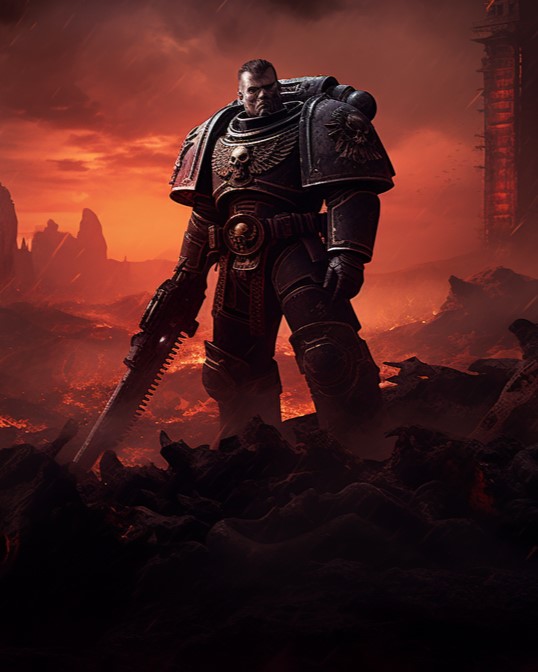
The Space Marines of Warhammer 40K are not merely soldiers; they are the embodiment of the Imperium’s Culture of War. This culture permeates every aspect of their existence, from their creation to their daily rituals, their art of combat, and their place within the Imperium.
The Warrior Ethos:
- Indoctrination: From the moment of their recruitment, Space Marines are indoctrinated into a life of unceasing warfare. Their training is as much about instilling a warrior ethos as it is about combat skills.
- Honor and Glory: Personal honor and the glory of the Chapter are paramount. Every battle is an opportunity to earn honor in the eyes of the Chapter and the Emperor.
Social Structure:
- Rigid Hierarchy: The Chapter’s organization enforces a strict hierarchy, from neophytes to the Chapter Master. Each rank has its own roles and responsibilities, steeped in tradition.
- Brotherhood: Despite the hierarchy, there is a deep sense of brotherhood among all Space Marines. They are united by shared experience, common purpose, and the gene-seed that makes them superhuman.
Rituals and Rites:
- Daily Rites: Space Marines partake in daily rituals that reinforce their purpose and readiness for war, including maintenance of their weapons and armor, prayers to the Emperor, and battle drills.
- Rites of Initiation and Promotion: These rites mark the milestones in a Space Marine’s life, such as the implantation of gene-seed organs or ascension to a command position.
Language and Communication:
- Battle Cant: Space Marines use a specialized form of communication in battle, a mix of high Gothic, coded language, and chapter-specific cant that is incomprehensible to outsiders.
- Iconography: The use of symbols and heraldry conveys rank, role, and honors. This visual language is as important as spoken words among the Astartes.
Art and Aesthetics:
- Monastic Austerity: The living quarters and spaces of a Space Marine are typically austere, reflecting their monastic lifestyle.
- Battle as Art: Space Marines view war itself as a form of art. The planning and execution of strategies and tactics are appreciated similarly to how an artist might regard a masterpiece.
Education and Knowledge:
- Tactical Acumen: A Space Marine’s education is heavily focused on tactics, strategy, and the art of war. They are scholars of battle, learning from historical campaigns and their own experiences.
- Selective Knowledge: While Space Marines are educated, their knowledge is curated to ensure loyalty and focus on their role as warriors. They know what they need to know to fight the enemies of the Imperium.
Religion and Belief:
- The Emperor: The Emperor is the central figure of Space Marine worship, revered as the pinnacle of humanity and the divine ruler of the Imperium.
- The Cult of the Primarch: Many Chapters also venerate their founding Primarch, incorporating aspects of this adoration into their religious practices.
The Imperium and Humanity:
- Protectors of Humanity: Space Marines see themselves as the ultimate protectors of humanity, a role that justifies and necessitates their existence.
- Separation from the Masses: Despite their role as protectors, Space Marines are separate from the populace they defend, elevated and isolated by their status.
The Eternal War:
- Conflict Without End: Space Marines are raised to believe in and prepare for an eternal war against the Imperium’s countless enemies.
- Martyrdom and Sacrifice: Death in battle is the expected and honored end for a Space Marine. They are taught to embrace this fate and to find joy only in the fulfillment of their duty.
The Culture of War for the Space Marines is all-encompassing, defining not just their purpose but their very identity. It is a culture that has been refined and codified over ten thousand years of constant conflict, a culture that ensures the Adeptus Astartes remain the most feared and respected warriors in the galaxy.
The Language of the Astartes
The Language of the Astartes, also known as High Gothic, is a complex and ancient form of speech used by the Space Marines of the Warhammer 40K universe. This language is not just a means of communication but a reflection of the Space Marines’ heritage, their rituals, and the complexity of their existence as the Emperor’s chosen warriors.
High Gothic:
- Sacred Tongue: High Gothic serves as the liturgical and formal language of the Imperium, used in rituals, ceremonies, and official decrees. It is akin to Latin in the modern-day real world, a language of the educated and the elite.
- Complexity: The language is characterized by its complexity, with a vast vocabulary that encompasses terms for the many facets of warfare, theology, and the esoteric knowledge of the Adeptus Astartes.
Battle Cant:
- Tactical Communication: Space Marines use a battlefield variant of High Gothic, known as battle cant, which is a shorthand form of communication designed for clarity and speed. It includes coded phrases, hand signals, and encrypted vox transmissions.
- Chapter Variants: Each Chapter may have its own dialect of battle cant, incorporating local linguistic elements and specialized terminology relevant to their specific tactics and traditions.
Ritual Chants:
- Litany and Prayer: The Space Marines’ daily rituals involve chants and prayers in High Gothic, which reinforce their spiritual connection to the Emperor and their mental preparation for battle.
- Psychological Effect: These chants often have a profound psychological effect, both on the Space Marines themselves and on those who hear them, inspiring awe and terror in equal measure.
Iconography and Symbolism:
- Visual Language: The Space Marines also communicate through iconography, which includes the heraldry on their armor, banners, and the environment of their ships and fortresses. This visual language is as important as spoken words and is understood across the Imperium.
- Symbolic Gestures: Gestures and salutes often accompany or replace verbal communication, especially when silence is required or in the presence of the sacred.
Language as a Weapon:
- Psychological Warfare: The use of High Gothic in war chants and battle cries can demoralize the enemy and is considered a weapon in its own right.
- Arcane Knowledge: Some words in High Gothic are believed to hold power, particularly in the case of daemon names and sacred texts, which can be used in banishment and exorcism rituals.
Language of Command:
- Authority: Commands given in High Gothic carry the weight of centuries of tradition and the authority of the Adeptus Astartes. They are expected to be obeyed without question.
- Precision: The precision of High Gothic allows for complex orders to be conveyed succinctly, which is crucial in the chaos of battle.
Language Preservation:
- Scholastic Tradition: The Space Marines are among the few in the Imperium who are taught to read and write High Gothic fluently, preserving the language within their ranks.
- Librarius: The Librarians of each Chapter are the keepers of their lore and language, often fluent in several dialects of High Gothic and responsible for teaching it to their brethren.
Language Evolution:
- Adaptation: Over the millennia, High Gothic has evolved, with Chapters adapting it to their needs and the changing nature of the Imperium.
- Dead and Living Language: While High Gothic is considered a dead language by some, for the Space Marines, it is very much alive and an integral part of their culture.
The Language of the Astartes is thus a multifaceted tool, serving as a means of communication, a method of indoctrination, a weapon of war, and a bastion of the Space Marines’ identity. It is a language steeped in history and power, a language that is both a shield and a sword for the Emperor’s finest warriors.
Rites and Rituals
The Space Marines of the Warhammer 40K universe are steeped in a culture of tradition and ceremony. Their rites and rituals are as integral to their identity as their power armor and bolters. These practices serve to reinforce the Space Marines’ spiritual fortitude, to honor the Emperor and the Primarchs, and to maintain the martial prowess and discipline that are the hallmarks of the Adeptus Astartes.
Daily Rites:
- Prayers of Maintenance: Each day begins with ritualistic prayers and blessings over weapons and armor, believed to appease the machine spirits (artificial intelligences) within their wargear.
- Meditations of Purity: Space Marines meditate on the teachings of the Emperor and their Primarch, often reciting catechisms of hate against the enemies of mankind to steel their minds for battle.
Rites of Initiation:
- The Aspirant’s Trials: Potential recruits must pass grueling physical, mental, and spiritual trials to prove their worthiness. These often include tests of strength, endurance, combat skill, and faith.
- The Implantation: The successful aspirants undergo the ritual implantation of the gene-seed organs, each accompanied by its own rite to ensure the recruit’s body accepts the sacred enhancements.
Rites of Battle:
- Litany of War: Before engaging in combat, Space Marines chant litanies of war to invoke the Emperor’s protection and to psych themselves up for the fight.
- Blessing of the Weapons: Chaplains bless the Marines’ weapons, anointing them with sacred oils and reciting prayers to guide their strikes.
Rites of Remembrance:
- Feasts of Victory: After a successful campaign, Chapters may hold feasts where sagas of heroism are recited, honoring those who fell and those who achieved great deeds.
- Ceremonies of the Fallen: For those who die in service, there are solemn ceremonies where the names of the fallen are added to the Chapter’s roll of honor, ensuring their memory will live on.
Rites of Ascension:
- The Taking of the Oath: When a Space Marine is promoted, they take oaths of office that bind them to their new duties. These oaths are often witnessed by the entire Chapter and are considered sacred.
- The Ritual of Command: Chapter Masters and other high-ranking officers may undergo complex rituals that symbolize their burden of command, such as the donning of the Mantle of the Master or the wielding of the Chapter’s relic weapon.
Rites of Penance:
- The Ritual of Atonement: Marines who fail or fall short of their duties must perform rites of penance, which can range from fasting and prayer to undertaking a Death Oath, a dangerous mission likely to result in death or redemption.
- The Walk of Shame: In some Chapters, a Marine who has dishonored himself must walk through the ranks of his brothers, who turn their backs on him until he redeems himself.
Rites of the Psyker:
- The Binding: Librarians undergo rituals to bind their psychic powers, protecting them from the dangers of the Warp and the predations of daemons.
- The Scourging: Psykers within the Chapter periodically undergo the Scourging, a ritual purification to cleanse their minds and spirits of any taint from the Warp.
Rites of the Machine:
- The Canticles of the Omnissiah: Techmarines chant the Canticles of the Omnissiah as they tend to the Chapter’s machinery, a practice that combines elements of ritual with practical maintenance.
- The Anointing of the Machine Spirit: Before a battle, vehicles and other machines of war are anointed and blessed in elaborate ceremonies to appease their machine spirits.
Rites of the Chaplaincy:
- The Liturgy of Faith: Chaplains lead their brothers in the Liturgy of Faith, reinforcing their belief in the Emperor and steeling their souls against heresy and fear.
- The Absolution: Before a battle, Chaplains offer absolution to the Marines, ensuring that should they fall, their souls will be clean before the Emperor.
These rites and rituals are not mere superstition; they are the spiritual armor of the Space Marines, as vital to their survival as their ceramite plating. They bind the Space Marines to their past, guide them in the present, and prepare them for the future, serving as a constant reminder of their duties and the eternal war they fight for the salvation of mankind.
The Cult of the Emperor
The Cult of the Emperor, also known as the Imperial Cult, is the predominant religion within the Imperium of Man, venerating the God-Emperor of Mankind. For the Space Marines, the Emperor is not only the founder of their order and the creator of their gene-seed but also a divine figure deserving of their unwavering worship and absolute loyalty.
The God-Emperor:
- Divine Ruler: The Emperor is worshipped as a living god, the immortal ruler of humanity, who sits eternally upon the Golden Throne on Terra.
- Savior of Mankind: He is seen as the savior of humanity, who united the warring factions of Terra and launched the Great Crusade to reclaim the galaxy in the name of mankind.
The Ecclesiarchy:
- The Adeptus Ministorum: The Ecclesiarchy, or the Adeptus Ministorum, is the state church of the Imperium, responsible for spreading the worship of the Emperor throughout the galaxy.
- Missionaries and Confessors: These zealous priests ensure the Emperor’s word is kept and his worship maintained, often accompanying Imperial forces to provide spiritual guidance.
Space Marine Chaplains:
- Spiritual Leaders: Within each Chapter, Chaplains uphold the Cult of the Emperor, leading their battle-brothers in prayer and ensuring their faith remains strong.
- Warrior-Priests: Chaplains are not only spiritual leaders but also warriors in their own right, embodying the martial might of the Emperor.
The Temple of the Emperor Ascendant:
- Shrines and Temples: Across the Imperium, shrines and temples dedicated to the Emperor can be found on almost every world, from grand cathedrals to simple battlefield shrines.
- Pilgrimages: Many faithful undertake pilgrimages to Terra or other holy sites where the Emperor’s presence was felt, seeking blessings or forgiveness.
Rituals and Ceremonies:
- Feasts of the Emperor’s Ascension: Celebrations marking the day the Emperor was interred upon the Golden Throne, a time of great feasting and solemnity.
- The Rites of Initiation: Space Marine recruits are often initiated into the Chapter with religious ceremonies, swearing oaths upon the relics of the Emperor.
The Emperor’s Tarot:
- Divination Tool: The Emperor’s Tarot is a set of psychic cards used by the faithful to divine the Emperor’s will and the future of the Imperium.
- Guidance in War: Space Marine Librarians and Chaplains may use the Tarot to seek guidance in their campaigns, interpreting the Emperor’s will in the ebb and flow of battle.
The Litany of Faith:
- Chants and Prayers: The Space Marines recite litanies and prayers to the Emperor before, during, and after combat, believing their words strengthen their resolve and protect their souls.
- Inscriptions and Tattoos: Many Space Marines bear inscriptions of prayers or the Emperor’s visage on their armor and bodies, a constant reminder of their duty to the divine ruler.
The Emperor’s Psykers:
- The Astronomican: The Emperor, even in his near-death state, projects the Astronomican, a psychic beacon that allows for safe warp travel across the Imperium.
- The Grey Knights: The Grey Knights, a Chapter of Space Marines, are psykers sworn to the Emperor, using their powers to combat the daemonic and the warp-tainted.
The Imperial Creed:
- Articles of Faith: The Imperial Creed outlines the tenets of the Cult, including the divinity of the Emperor, the sanctity of the human form, and the abhorrence of the alien, the heretic, and the mutant.
- The Emperor’s Justice: Those who defy the Creed are subject to the Emperor’s justice, often meted out by the Inquisition or the Adeptus Astartes themselves.
The Cult of the Emperor is a cornerstone of the Space Marines’ existence. It is a source of spiritual strength, a justification for their endless war, and a bond that unites the disparate Chapters of the Adeptus Astartes. In the Emperor, they find the ultimate expression of their duty and the final arbiter of their fate in the war-torn galaxy of the 41st millennium.
The Role of Chaplains
In the ranks of the Space Marines, Chaplains serve a vital role that transcends the boundaries of mere spiritual guidance. They are the keepers of their Chapter’s faith, the spiritual warriors who embody the values of the Cult of the Emperor, and the upholders of the Chapter’s traditions and moral purity.
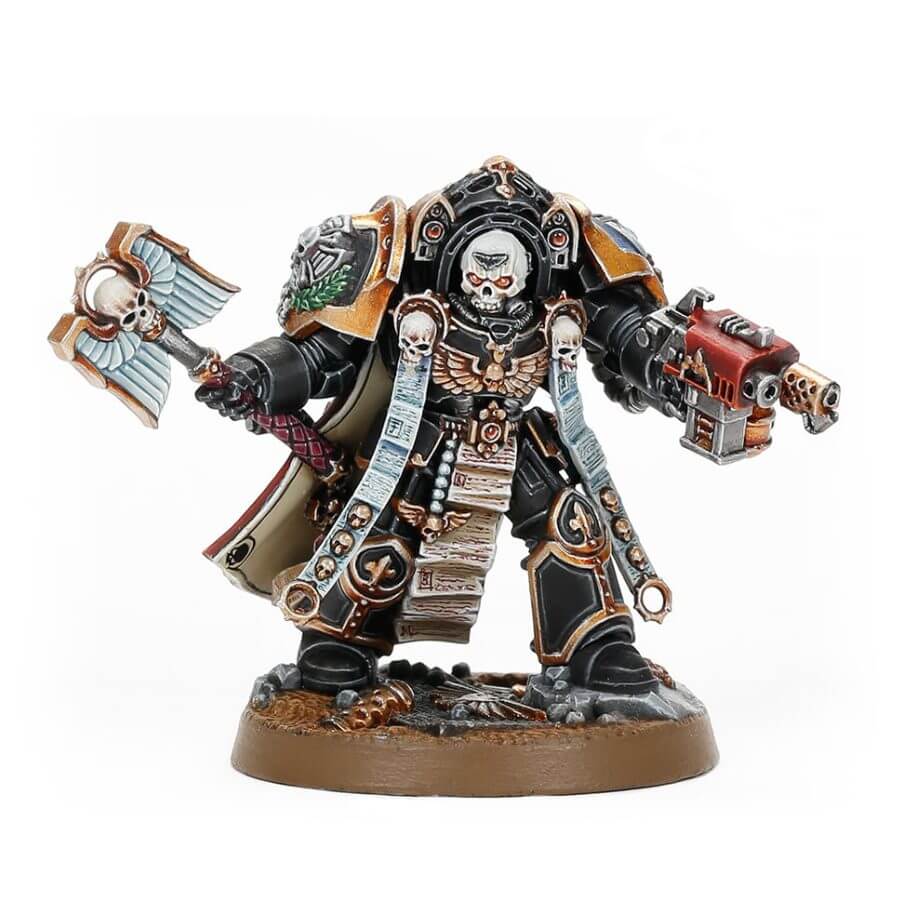
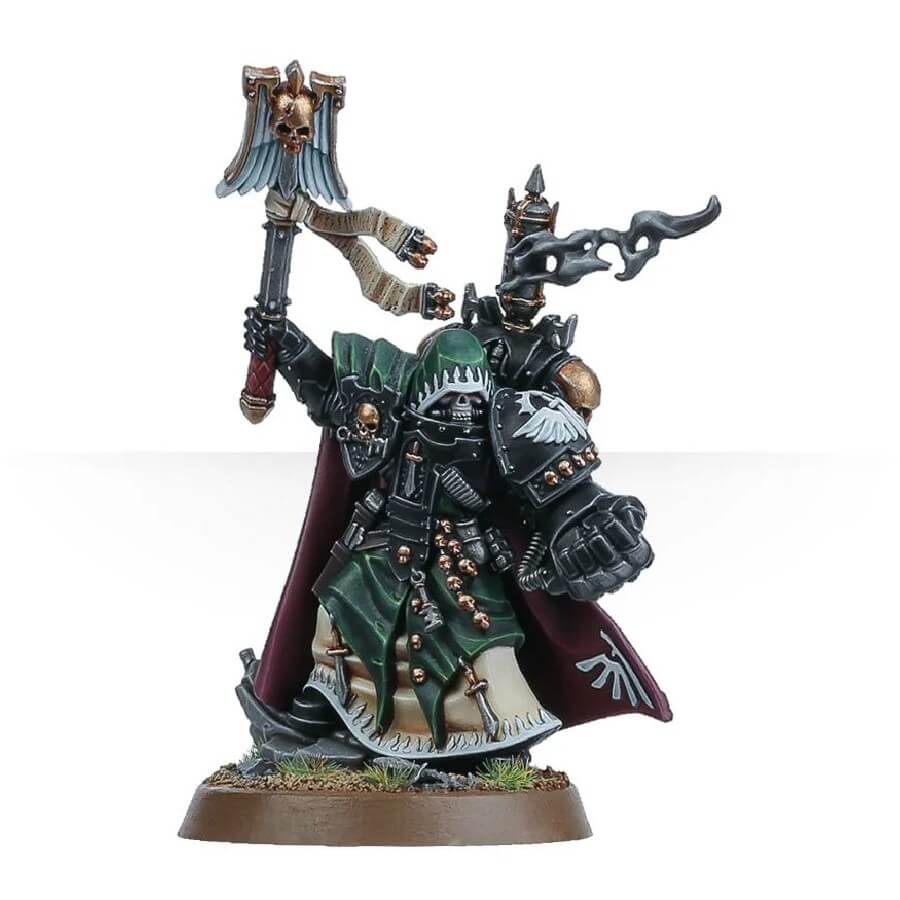
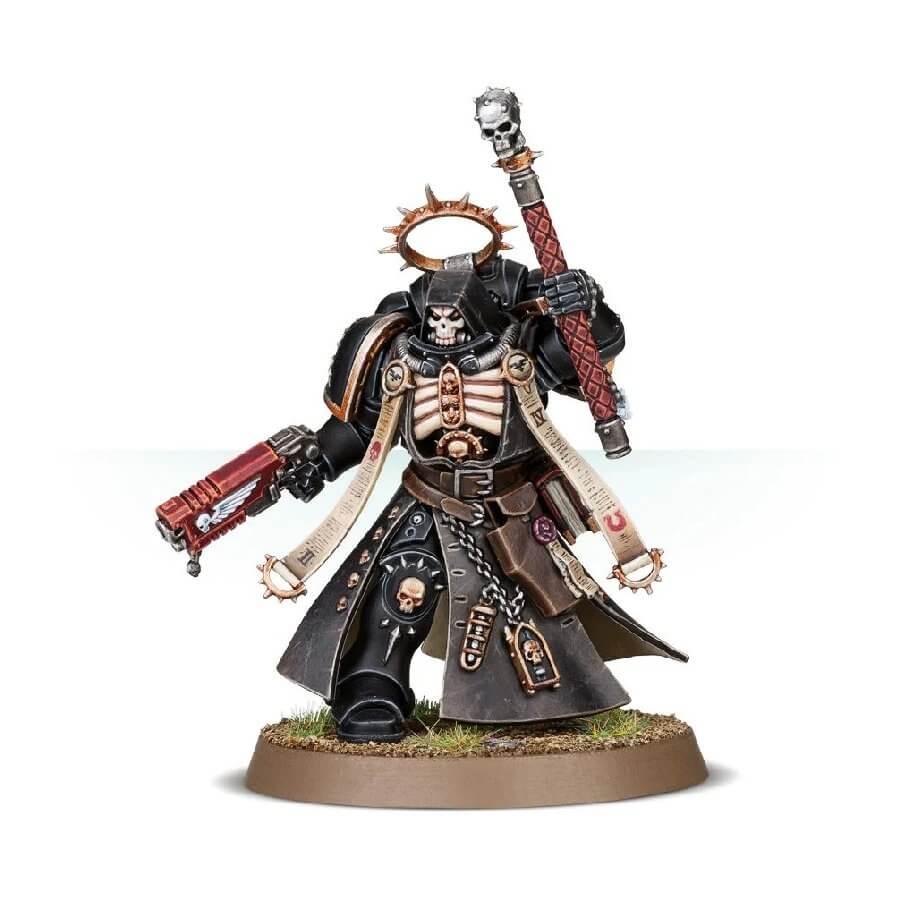
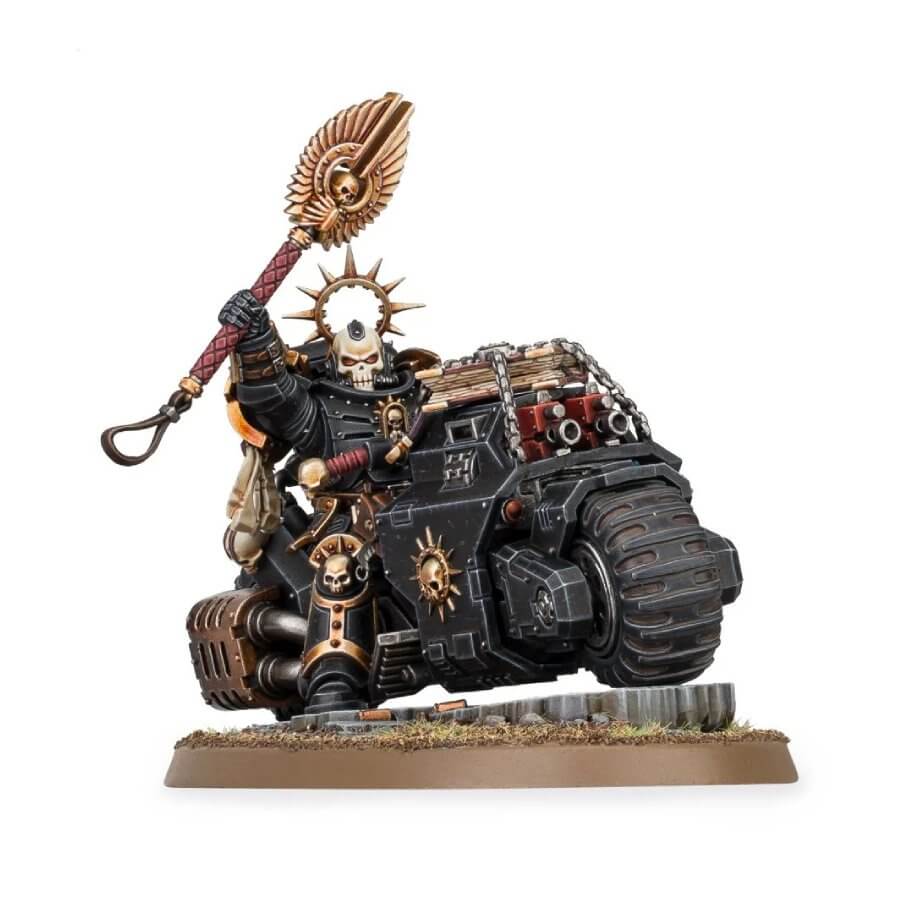
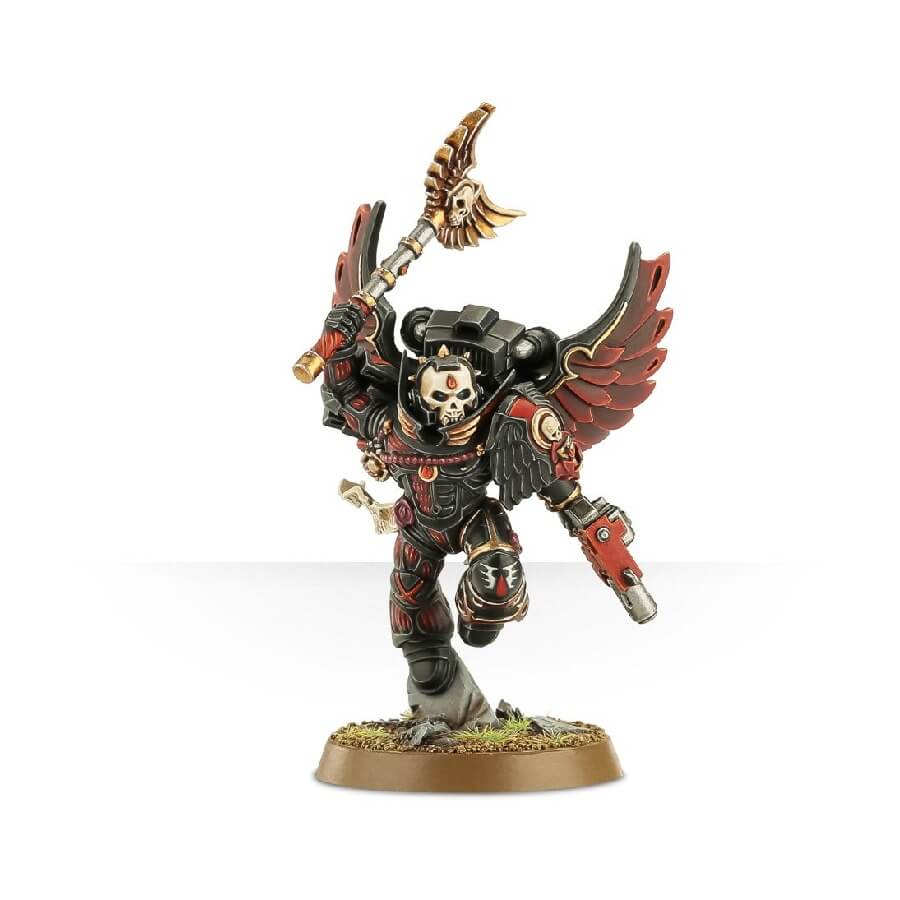
Spiritual Leaders:
- Moral Compass: Chaplains are the moral compass for their brothers, ensuring that each Space Marine upholds the values and spiritual discipline expected of the Emperor’s finest.
- Guardians of Doctrine: They guard and interpret the Chapter’s religious doctrine, adapting the teachings of the Imperial Cult to fit the unique culture and beliefs of their Chapter.
Warrior-Priests:
- Combat Role: On the battlefield, Chaplains are fearsome warriors, often leading from the front to inspire their brethren. They wear distinctive skull helmets and carry the Crozius Arcanum, a symbol of their office and a potent weapon.
- Rallying Presence: Their presence rallies Space Marines in the heat of battle, their battle-cries and litanies echoing over the din of war to steel the hearts of their comrades.
Caretakers of the Fallen:
- Rites for the Dead: Chaplains perform the funerary rites for fallen Space Marines, ensuring their souls are commended to the Emperor and their sacrifice honored.
- Gene-Seed Retrieval: They often oversee the retrieval of the gene-seed from the fallen, a sacred task that ensures the future of the Chapter.
Recruitment and Initiation:
- Testing Aspirants: Chaplains are involved in the testing and initiation of neophytes, assessing their spiritual purity and suitability for becoming a Space Marine.
- Indoctrination: They lead the indoctrination of new recruits, instilling in them the beliefs and values of the Chapter and the Imperium.
Confessors and Counselors:
- Spiritual Counsel: Chaplains provide spiritual counsel to their brothers, helping them to overcome doubts, fears, and the psychological scars of war.
- Confession and Absolution: They hear the confessions of their brethren, offering absolution and penance to cleanse their souls of any perceived weakness or impurity.
Bearers of Relics:
- Custodians of Relics: Chaplains are often the custodians of the Chapter’s relics and sacred artifacts, which they bear into battle to inspire their brothers.
- Conduits of Faith: Through these relics, Chaplains are seen as conduits of the Emperor’s will, channeling His divine presence on the battlefield.
Enforcers of Discipline:
- Disciplinary Actions: While the Company Captains are responsible for the tactical discipline of their troops, Chaplains enforce spiritual and moral discipline.
- Judges of Heresy: In cases of heresy or a lapse in faith, Chaplains serve as judges, determining the guilt and meting out punishment, which can range from penitential missions to execution.
Teachers and Historians:
- Keepers of History: Chaplains maintain the oral history of their Chapter, recounting tales of heroism and sacrifice to ensure they are never forgotten.
- Educators: They educate the Space Marines in the history of the Imperium, the significance of the Emperor, and the lore of their own Chapter.
The Role in the Chapter’s Hierarchy:
- Advisors to Command: Chaplains also serve as advisors to the Chapter Master and other senior officers, providing spiritual insight and guidance on matters of faith and morale.
- Independent Authority: While they hold no direct command in the Chapter’s chain of command, their authority on spiritual matters is absolute, and their counsel is highly valued.
Chaplains are thus a central pillar in the structure of a Space Marine Chapter, integral to its spiritual health and martial prowess. They are the embodiment of the Emperor’s divine will, ensuring that every Space Marine fights not just with physical strength but with the unshakeable conviction that comes from absolute faith.
The Art of War: Strategies and Tactics
The Space Marines of Warhammer 40K are renowned not only for their superhuman abilities and advanced wargear but also for their masterful application of the art of war. Their strategies and tactics are honed over centuries of warfare, making them the most feared and efficient fighting force in the Imperium.
Strategic Doctrine:
- Adaptability: Space Marines are trained to be highly adaptable, capable of responding to any threat with a variety of strategic approaches. They can wage war across diverse environments, from the vacuum of space to the dense jungles of death worlds.
- Strike Hard and Fast: A core tenet of Space Marine strategy is to strike hard and fast, targeting the enemy’s command structure, supply lines, and communication networks to disrupt and demoralize before a full engagement begins.
Tactical Maneuvers:
- Drop Pod Assaults: Space Marines often deploy via drop pods, entering the battlefield from orbit with such speed and surprise that they can overwhelm an unprepared enemy.
- Deep Strike Operations: Teleportation and jump pack-equipped units are used for deep strike operations, bypassing enemy defenses to hit critical targets.
Combat Formations:
- Battle Companies: Space Marines are organized into battle companies, each with a mix of tactical, assault, and devastator squads to provide a balanced force capable of both offense and defense.
- Squad Tactics: Squads operate with a high degree of autonomy, each capable of independent action or supporting other units in a coordinated fashion.
Siege Warfare:
- Breaching Actions: When faced with fortifications, Space Marines employ breaching strategies, using specialized equipment and tactics to break through walls and defensive lines.
- Sustained Assault: They can maintain a sustained assault, utilizing their resilience and firepower to wear down the enemy’s defenses over time.
Guerrilla Warfare:
- Hit-and-Run Attacks: In situations where they are outnumbered or outgunned, Space Marines may employ guerrilla tactics, conducting hit-and-run attacks to harass and weaken the enemy.
- Ambushes: They are adept at setting ambushes, using the element of surprise to their advantage to eliminate key targets or to create openings for a larger offensive.
Psychological Warfare:
- Fear as a Weapon: The mere presence of Space Marines can be a psychological weapon, as their reputation often precedes them, sowing fear and doubt among their adversaries.
- Propaganda and Misinformation: They may also use propaganda and misinformation to undermine enemy morale and to manipulate the battlefield without direct engagement.
Naval Engagements:
- Space Superiority: Space Marine fleets are designed for rapid response and space superiority, able to deploy forces quickly to any theater of war.
- Boarding Actions: They excel at boarding actions, using their ships to deliver Space Marines directly into the heart of enemy vessels for close-quarters combat.
Special Operations:
- Reconnaissance and Infiltration: Scout Marines conduct reconnaissance and infiltration missions, gathering intelligence and sowing chaos behind enemy lines.
- Targeted Elimination: Specialized units like the Deathwatch focus on targeted elimination of key xenos threats, using precision strikes to take out leaders and disrupt alien operations.
Combined Arms Warfare:
- Integration of Assets: Space Marines effectively integrate various assets, from infantry and armor to air support and orbital bombardments, to create a cohesive and devastating force.
- Supporting Elements: They utilize supporting elements such as the Adeptus Mechanicus and the Imperial Guard to secure broader strategic objectives while the Astartes focus on the critical points of engagement.
Defensive Strategies:
- Fortifications: When on the defensive, Space Marines fortify positions with expert precision, creating strongholds that can withstand overwhelming odds.
- Counter-Attack: They remain ever ready to transition from defense to offense, using counter-attacks to turn the tide of battle.
The Art of War for the Space Marines is a blend of ancient wisdom and modern tactics, a balance of physical might and strategic acumen. It is a continuously evolving doctrine, shaped by the experiences of countless battles across the galaxy, ensuring that the Adeptus Astartes remain the ultimate warriors in an age of endless war.
The Theatre of the Galaxy
The Theatre of the Galaxy in the Warhammer 40K universe is a vast and tumultuous stage where the Space Marines enact their eternal war. It is a cosmic arena of conflict that spans millions of worlds across the breadth of the Milky Way. Each theater of war presents its own challenges and requires the Adeptus Astartes to adapt their strategies and tactics accordingly.
Segmentum Solar:
- Heart of the Imperium: The Segmentum Solar is the central hub of the Imperium, containing Terra, Mars, and many other vital systems. The defense of this segment is paramount, as it represents the political and spiritual heart of humanity.
- Holy Wars: Battles here are often fought not just in space or on the ground, but in the hearts and minds of the Imperium’s citizens, as the Space Marines also combat heresy and protect the faith.
Segmentum Obscurus:
- The Eye of Terror: This segment is infamous for containing the Eye of Terror, a massive warp rift from which Chaos forces spill forth. Space Marines here are constantly battling the forces of Chaos, both in realspace and in the immaterial realm of the warp.
- Cadia and the Cadian Gate: Before its fall, Cadia was a fortress world that stood as the first line of defense against Chaos incursions. Its loss has made the Segmentum Obscurus an even more volatile theater.
Segmentum Ultima:
- Varied Conflicts: The Segmentum Ultima is a diverse theater with many alien empires and unexplored regions. Space Marines must contend with the full spectrum of the Imperium’s enemies, from Ork Waaaghs! to Tyranid Hive Fleets.
- Ultramar: The realm of Ultramar, governed by the Ultramarines, is a beacon of relative stability and order in this segment. It is often used as a staging ground for campaigns to reclaim or defend Imperial worlds.
Segmentum Tempestus:
- Pirate Havens and Alien Dominions: This segment is rife with piracy and is the home of several xenos-held domains. Space Marines often conduct punitive expeditions or crusades to cleanse these threats.
- The Damocles Gulf: The site of significant conflict with the Tau Empire, where Space Marines have been engaged in a series of brutal campaigns to counter the expansion of the Tau.
Segmentum Pacificus:
- Rebellions and Insurgency: A segment known for its rebellious streak and the presence of secessionist movements. Space Marines are frequently deployed to quell uprisings and restore Imperial rule.
- The Sabbat Worlds: A notable campaign here is the Sabbat Worlds Crusade, where Space Marines fought alongside the Imperial Guard to reclaim worlds from Chaos control.
The Eastern Fringe:
- The Unknown and the Uncharted: The Eastern Fringe is on the edge of the known galaxy, where Space Marines explore and claim new worlds for the Imperium, encountering unknown threats and alien species.
- The Tyrannic Wars: The Eastern Fringe has been heavily affected by the Tyranid invasions, with Chapters like the Ultramarines playing pivotal roles in defending against the Great Devourer.
The Halo Stars:
- Ancient Mysteries: The Halo Stars are a region of ancient and often dead civilizations. Space Marines here face not only xenos threats but also the dangers of ancient technology and dark archaeology.
- The Halo Zone: This area is less controlled by the Imperium and more prone to exploration and rogue traders, with Space Marines sometimes accompanying expeditions to ensure they do not fall afoul of hidden dangers.
The Ghoul Stars:
- Eldritch Horrors: On the very edge of the galaxy, the Ghoul Stars are home to eldritch horrors and ancient menaces. Space Marines here are the Imperium’s bulwark against threats that defy understanding.
- The Cursed Founding: Some Chapters created during the Cursed Founding operate in this region, facing constant suspicion due to the ill fate that befell many of their number.
In every theater across the galaxy, the Space Marines must be ever-vigilant and ready to deploy at a moment’s notice. They are the Emperor’s wrath made manifest, bringing death to His foes across the stars. The galaxy is a place of endless war, and the Space Marines are its eternal warriors, fighting not just for the survival of humanity but for the destiny of the Imperium itself.
Famous Campaigns and Battles
Throughout the grim darkness of the far future in the Warhammer 40K universe, the Space Marines have fought in countless campaigns and battles, many of which have become legendary. These engagements showcase their valor, their strategic genius, and their indomitable will to overcome any odds. Here are some of the most famous campaigns and battles involving the Adeptus Astartes:
The Horus Heresy:
- Siege of Terra: The climactic end of the Horus Heresy, where the traitor legions of Horus assaulted Terra itself. The loyalist Space Marines fought desperately to defend the Imperial Palace and the Golden Throne.
- Drop Site Massacre of Istvaan V: A brutal betrayal where Horus revealed the extent of his treachery, leading to the near annihilation of several loyalist legions.
The First Tyrannic War:
- Battle for Macragge: The Ultramarines, under Marneus Calgar, defended their homeworld of Macragge against the first major Tyranid incursion into the galaxy by Hive Fleet Behemoth.
The Second War for Armageddon:
- Armageddon: The Space Marines, alongside the Imperial Guard and the forces of the Adeptus Mechanicus, fought against the Ork Warlord Ghazghkull Mag Uruk Thraka in a brutal war of attrition on the hive world of Armageddon.
The Third War for Armageddon:
- Armageddon (Reprise): Ghazghkull returned to Armageddon with an even larger Waaagh!, leading to another devastating conflict. The Black Templars were notably active in this war.
The Badab War:
- Siege of Badab: A civil war within the Imperium, where the Astral Claws turned renegade. The Space Marines were sent to bring them to justice, resulting in a protracted and bloody conflict.
The Damocles Gulf Crusade:
- Damocles Gulf: The Imperium’s first major conflict with the Tau Empire. Space Marine Chapters like the Ultramarines and the White Scars fought to halt the expansion of the Tau.
The Sabbat Worlds Crusade:
- Sabbat Worlds: A series of campaigns to reclaim the Sabbat Worlds from Chaos control, with the Imperial Guard and several Space Marine Chapters participating in the grueling campaigns.
The Plague Wars:
- Ultramar: The Death Guard, led by the Daemon Primarch Mortarion, launched a devastating campaign against the Ultramarines’ realm of Ultramar, spreading Nurgle’s plagues across the region.
The Indomitus Crusade:
- Rebirth of the Imperium: Launched by the resurrected Primarch Roboute Guilliman after the opening of the Great Rift, the Indomitus Crusade aimed to stabilize the Imperium and push back against the encroaching darkness.
The Black Crusades:
- Cadiz and the Blackstone Fortresses: Abaddon the Despoiler led multiple Black Crusades against the Imperium, culminating in the fall of Cadia and the creation of the Great Rift that split the galaxy in half.
The Defense of Baal:
- Devastation of Baal: The Blood Angels and their successor Chapters defended their homeworld of Baal against the Tyranid Hive Fleet Leviathan in a battle that nearly saw the extinction of the entire Blood Angels lineage.
The War of Beasts:
- Vigilus: A war on the strategically vital world of Vigilus, which saw conflict between the Imperium, Orks, Chaos, and Genestealer Cults. The Space Marines fought to keep control of this crucial nexus point.
These campaigns and battles are but a few examples of the Space Marines’ eternal war. Each is a saga of heroism and sacrifice, a testament to the Space Marines’ role as the Imperium’s greatest defenders. They are immortalized in the annals of the Imperium, taught to recruits, and recited as litanies to inspire courage in the face of overwhelming darkness.
The Xenos Threat: Orks, Eldar, Tyranids and more
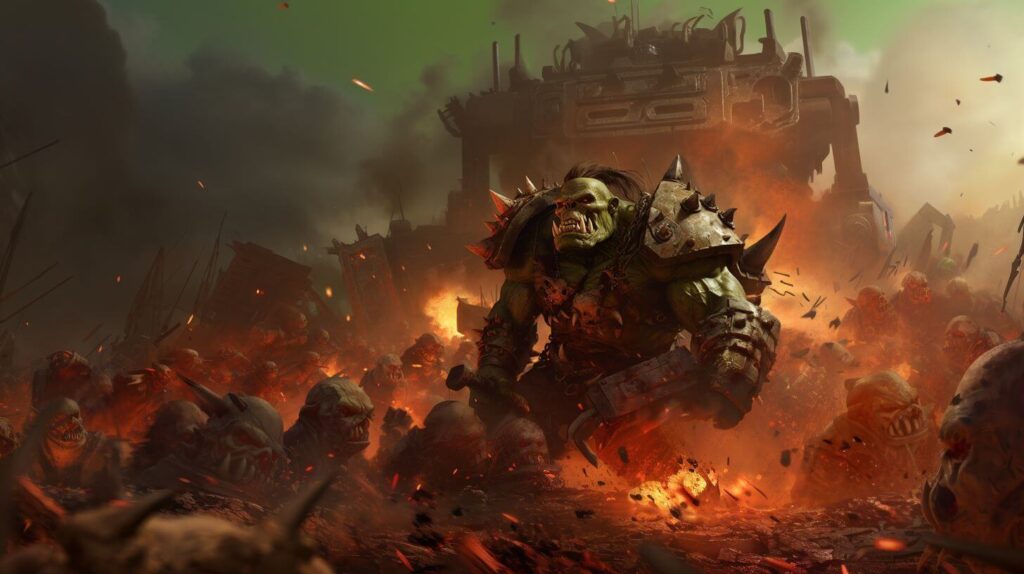
The galaxy of Warhammer 40K is rife with innumerable dangers, but among the most persistent and widespread threats to the Imperium of Man are the various xenos species.
The Space Marines stand as the Imperium’s bulwark against these alien menaces, each requiring different strategies and tactics to combat effectively.
Orks
- The Green Tide: Orks are a warlike, barbaric species, living only for combat. They are a seemingly endless horde, known colloquially as the “Green Tide” due to their vast numbers and propensity for swarming tactics.
- Waaagh! Energy: Ork psychic energy, known as Waaagh! energy, grows stronger as they fight, making them a unique and unpredictable enemy that can surge in power if not quickly contained.
- Warbosses and Warlords: Ork armies are led by the biggest and strongest among them, Warbosses, who can unite tribes into a Waaagh!, a campaign of conquest that can ravage entire sectors.
- Space Marine Response: To combat Orks, Space Marines focus on decapitation strikes, aiming to kill Ork leaders and fragment their unity. They also engage in large-scale battles to stem the tide of Ork invasions, often at great cost.
Eldar:
- Craftworld and Drukhari: The Eldar are divided into various factions, with the Craftworld Eldar being enigmatic and highly advanced, while the Drukhari (Dark Eldar) are sadistic raiders who revel in pain and suffering.
- Guerrilla Warfare: Eldar forces often engage in hit-and-run tactics and guerrilla warfare, using their advanced technology and psychic abilities to outmaneuver more cumbersome forces.
- Farseers and Warlocks: Eldar psykers, such as Farseers and Warlocks, can foresee potential futures, making them strategic adversaries who can anticipate and counter the Imperium’s moves.
- Space Marine Response: Against Eldar, Space Marines must rely on their discipline to avoid ambushes and traps. They also attempt to counter the Eldar’s mobility with rapid deployment and overwhelming firepower.
Tyranids
- The Great Devourer: Tyranids are a bio-engineered, hive-mind-controlled race of xenos that consume all organic matter in their path, earning them the moniker “The Great Devourer.”
- Hive Fleets: They attack in Hive Fleets, each a massive swarm of bio-ships and creatures that adapt in real-time to counter the defenses of their prey.
- Synapse Creatures: The Tyranid swarm is directed by Synapse Creatures, which act as relay points for the Hive Mind’s will, coordinating their forces with terrifying efficiency.
- Space Marine Response: Space Marines combat Tyranids by targeting these Synapse Creatures to disrupt the hive fleet’s cohesion. They also engage in extermination campaigns, often resorting to the use of Exterminatus (total planetary destruction) to deny the Tyranids biomass.
Tau Empire
- The Greater Good: The Tau are a relatively young race in the galaxy, known for their rapid technological advancement and the philosophy of the “Greater Good,” which they seek to spread across the galaxy, sometimes by force.
- Advanced Ranged Warfare: The Tau favor highly advanced ranged weaponry and are known for their powerful battlesuits and devastating long-range firepower.
- Kroot and Vespid Allies: The Tau Empire also incorporates many different species into their ranks, such as the Kroot and Vespid, using them as auxiliaries to supplement their own combat styles.
- Space Marine Response: To counter the Tau’s technological edge, Space Marines often engage in close-quarters combat, where the Tau are weaker. They also employ stealth and subterfuge to disrupt Tau command structures and to negate the advantages of the Tau’s long-range weaponry.
Leagues of Votann
- A Reemerging Race: The Leagues of Votann, once known as the Squats, are a race of sturdy, human-like beings who inhabit the galactic core. They are a technologically advanced and resilient species, emerging from their strongholds to stake their claim in the galaxy.
- Industrial Might: The Leagues of Votann are characterized by their industrial prowess, fielding heavily armored infantry and robust machinery in battle.
- Kinhost Warfare: Their military forces, known as Kinhosts, are well-coordinated and heavily fortified, often employing a mix of advanced weaponry and hardy warriors in their engagements.
- Space Marine Response: Facing the Leagues of Votann requires the Space Marines to overcome formidable defenses. Siege tactics and the use of heavy weaponry are often necessary to break through the Votann’s fortifications. Precision strikes to disable their industrial capabilities can also be effective in reducing their ability to sustain prolonged conflicts.
Necrons
- Ancient and Undying: The Necrons are an ancient race of skeletal warriors made of living metal, having risen from eons of slumber to reclaim the galaxy they once dominated. They are virtually immortal, capable of self-repairing after taking damage, and are led by their undying rulers, the Phaerons and their Overlords.
- Advanced Necrodermis Technology: Necron technology is based on the manipulation of living metal, or necrodermis, which gives them a significant advantage in both durability and firepower. Their weapons are designed to disassemble matter at the molecular level, making them a threat to even the most heavily armored Space Marine.
- Reanimation Protocols: One of the most formidable aspects of the Necrons is their ability to reanimate after being slain. Unless completely destroyed, their bodies can repair themselves, allowing them to rise again and continue fighting.
- Dolmen Gates and FTL Travel: Necrons possess Dolmen Gates, which allow them to traverse the galaxy by breaching into the Webway, an ancient network of faster-than-light transit paths. This gives them the ability to strike without warning across the galaxy.
- Space Marine Response: To combat the Necrons, Space Marines must focus on complete annihilation of their forces to prevent them from reanimating. This often involves targeting the energy cores of their warriors and monoliths, or employing specialized weaponry capable of disrupting their necrodermis. Space Marines must also be prepared for sudden Necron incursions due to their ability to teleport directly into battle.
- Psychological Warfare Ineffective: Unlike other foes, the Necrons are immune to psychological warfare and fear tactics due to their robotic nature. Space Marines must rely purely on martial prowess and strategic acumen when facing these ancient adversaries.
- C’tan Shards: The Necrons also occasionally make use of the C’tan Shards, fragments of their former star-god masters, which are immensely powerful and can turn the tide of any battle. Engaging these entities requires the utmost caution and often the intervention of a Chapter’s most potent relics and weaponry.
In facing these xenos threats, the Space Marines are the Imperium’s sword and shield. They must constantly adapt and evolve their tactics to match the cunning, brutality, and ravenous hunger of their foes. Each victory against the xenos is hard-won, often at the cost of countless Space Marine lives, but it is a price the Adeptus Astartes are always prepared to pay to ensure the survival of humanity.
The Warp: Chaos Space Marines
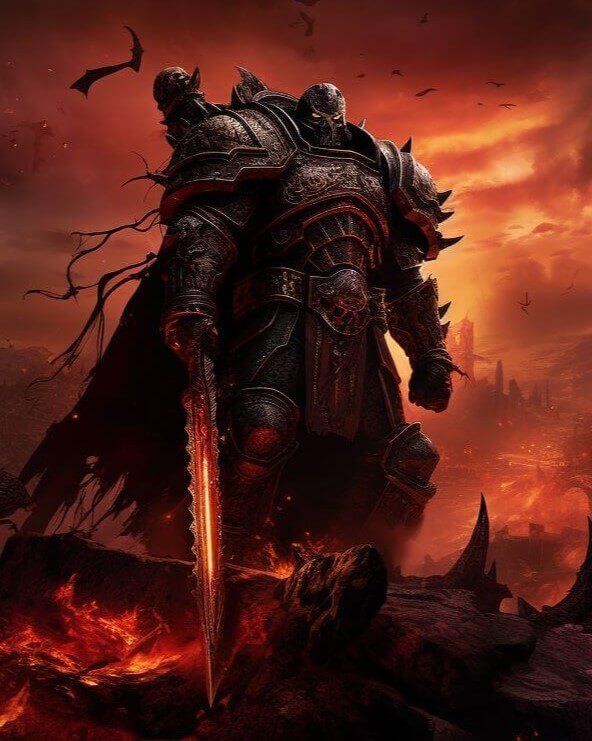
The Warp, also known as the Immaterium, is the dimension of pure psychic energy that echoes and underpins the physical universe. It is the source of all psychic power and the realm of the Chaos Gods. Within this tumultuous and hellish sea reside the Chaos Space Marines, traitors to the Imperium who have sworn themselves to the Dark Gods.
Chaos Space Marines
- Traitors to the Emperor: Once loyal warriors of the Imperium, these Space Marines turned against the Emperor during the Horus Heresy, becoming twisted reflections of their former selves.
- Warp Entities: They are often accompanied by daemons and other warp entities, making them unpredictable and incredibly dangerous adversaries.
- Legions and Warbands: Chaos Space Marines are organized into a variety of legions and warbands, each dedicated to a particular Chaos God or pursuing their own agendas of power and destruction.
The Nature of the Warp
- A Realm of Chaos: The Warp is a place of nightmares, where reality conforms to the whims of the Chaos Gods and the collective emotions of sentient beings.
- Psychic Phenomena: Travel through the Warp is necessary for faster-than-light travel in the physical universe, but it is fraught with peril, from psychic storms to daemonic incursions.
Chaos Gods:
- Khorne: The Blood God, who craves violence and offers power to those who bring slaughter in his name.
- Nurgle: The Plague Lord, who embodies decay and revels in pestilence and despair.
- Tzeentch: The Changer of Ways, a god of change, schemes, and sorcery.
- Slaanesh: The Prince of Pleasure, who represents excess, pleasure, and pain.
Space Marine Response:
- Psychic Defenses: Space Marines must fortify their minds and souls against the corrupting influence of the Warp and the insidious temptations of Chaos.
- Purging and Cleansing: They engage in campaigns of purging and cleansing, seeking to destroy the heretics and their daemonic allies wherever they can be found.
- Grey Knights and Deathwatch: Specialist chapters like the Grey Knights and the Deathwatch are specifically trained and equipped to deal with the threats of Chaos and the Warp.
Chaos Tactics:
- Corruption and Subversion: Chaos Space Marines often use corruption and subversion to weaken their enemies from within before striking.
- Sorcery and Daemonic Pacts: They employ dark sorcery and make pacts with daemons to enhance their power on the battlefield.
- Relics of the Dark Gods: Chaos Space Marines may possess ancient and forbidden relics imbued with the power of the Warp, making them formidable opponents.
The Long War
- Eternal Conflict: The battle between the Space Marines and their Chaos counterparts is known as the Long War, an eternal conflict with the fate of the galaxy at stake.
- Black Crusades: From time to time, the Chaos Space Marines launch Black Crusades, massive campaigns led by powerful champions like Abaddon the Despoiler, aimed at spreading destruction and heresy across the Imperium.
The Warp and the Chaos Space Marines represent a fundamental threat to the very soul of the Imperium. It is a battle not only for territory but for the essence of reality itself. The Space Marines, as the Emperor’s chosen warriors, stand as the only shield against the encroaching darkness that seeks to engulf the galaxy and drag it into the madness of the Warp.
The Imperium’s Edge: Defending Humanity
At the farthest reaches of the Imperium of Man, where the light of the Astronomican dims and the authority of Terra is but a whisper, lie the borderlands known as the Imperium’s Edge. Here, the Space Marines stand as the stalwart defenders of humanity, guarding against the encroaching darkness and the myriad threats that seek to tear the galaxy asunder.
The Fringes of Imperial Space:
- The Frontier Worlds: These worlds are often isolated, underdeveloped, and vulnerable to attack from xenos races, Chaos insurgents, and other predatory entities.
- The Halo Zones: Beyond the established sectors, these largely uncharted regions are rife with unknown dangers and ancient mysteries, often attracting the attention of adventurous or desperate Space Marine Chapters.
The Role of the Adeptus Astartes:
- Vigilant Protectors: Space Marines act as the Emperor’s wrathful sentinels, often being the first—and sometimes the only—line of defense against invasions.
- Rapid Response Forces: Due to their mobility and self-sufficiency, Space Marine Chapters are able to respond to threats that are beyond the reach of the more numerous Imperial Guard.
Challenges at the Edge:
- Xenos Incursions: Alien races such as the Orks, Tyranids, and Drukhari frequently raid and invade the sparsely defended frontier worlds.
- Chaos Raids: The taint of Chaos festers in the dark corners of the galaxy, with cults and renegade warbands launching sudden, brutal raids into Imperial space.
- Piracy and Lawlessness: The lack of a strong Imperial presence leads to rampant piracy and lawlessness, requiring Space Marines to conduct not only military campaigns but also to uphold Imperial law.
Notable Defense Campaigns:
- The Shield Worlds: These are strategically placed fortress worlds that serve as bulwarks against invasion routes into the Imperium’s core territories.
- The Sentinel Worlds: Planets that are heavily monitored for any signs of xenos activity or warp disturbances, often featuring a permanent Space Marine garrison.
The Role of the Imperial Navy:
- Patrol Fleets: The Imperial Navy works in conjunction with the Space Marines to patrol the vast voids of space, engaging enemy fleets and providing transportation for the Astartes.
- Battlefleet Obscurus and Others: Specific fleets, such as Battlefleet Obscurus, are charged with the defense of entire segments of Imperial space, often stretched thin across countless light-years.
The Importance of the Imperium’s Edge:
- Early Warning System: The worlds and outposts at the Imperium’s Edge serve as an early warning system for threats approaching the more central and populous regions of the Imperium.
- Testing Ground: These frontiers are where many Space Marines earn their reputation, facing the horrors of the galaxy in conditions that test their mettle to the utmost.
The Eternal Vigil:
- The Watchers in the Dark: Space Marine Chapters such as the Dark Angels and their successors maintain a constant vigil, ever watchful for signs of the Fallen and other threats.
- The Unknown and the Unseen: Space Marines must also contend with threats that are not yet fully understood, including the enigmatic Necrons and the newly emerged forces like the Leagues of Votann.
Defending the Imperium’s Edge is a never-ending task, one that is as crucial as it is perilous. The Space Marines who undertake this duty do so knowing that they are the thin ceramite-clad line between the Imperium and the void. Their vigilance ensures that humanity can thrive, even in the most remote and hostile corners of the galaxy.
The Endless War: Living for Conflict
The Space Marines of the Warhammer 40K universe are the ultimate warriors, engineered for combat and conditioned to live for the sole purpose of waging war. Their entire existence is centered around the concept of the “Endless War” — a perpetual state of conflict that defines the grim future of the 41st millennium.
The Adeptus Astartes:
- Warriors Without Peer: Space Marines are bred for battle, their bodies and minds honed into lethal instruments of war through rigorous training and genetic enhancement.
- Monastic Warfare: Their lives are monastic in nature, with every moment not spent in battle dedicated to the preparation for it, whether through training, meditation, or the maintenance of their wargear.
The Imperium’s Need:
- Constant Vigilance: The Imperium of Man is beset on all sides by enemies. The Space Marines are its protectors, standing guard against the ceaseless tide of threats.
- The Emperor’s Will: They are the Emperor’s wrath made manifest, tasked with carrying out His will across the galaxy, which often means engaging in unending combat.
The Nature of Conflict:
- Varied Theatres of War: Space Marines must be adaptable, as they are called upon to fight in every conceivable environment, from the vacuum of space to the depths of toxic death worlds.
- Diverse Enemies: They face a wide array of foes, including the insidious forces of Chaos, the relentless Ork hordes, the ravenous Tyranid swarms, and the enigmatic Eldar, among others.
The Psychology of the Space Marine:
- Conditioned for War: Space Marines are psychologically conditioned to cope with the stresses of continuous combat, their indoctrination rendering them immune to fear and doubt.
- Zeal and Devotion: Their fanatical devotion to the Emperor and the Imperium serves as a shield against the mental and emotional toll that endless war might otherwise exact.
The Role of Command:
- Tactical Genius: Space Marine officers are not only fearsome warriors but also brilliant tacticians, capable of leading their brothers in complex and dynamic warfare.
- Strategic Foresight: The long-term planning and strategic foresight of the Chapter Masters and their councils ensure that the Space Marines are always where they are most needed.
The Cost of Endless War:
- Sacrifice: The Space Marines are no strangers to sacrifice, and they are willing to lay down their lives for the Imperium without hesitation.
- Renewal and Recruitment: Despite their superhuman abilities, Space Marines do fall in battle, necessitating a constant cycle of recruitment and training to replenish their ranks.
The Spiritual Aspect:
- The Cult of the Emperor: The spiritual beliefs of the Space Marines, centered around the worship of the Emperor as a god, provide them with a higher purpose and the conviction that their struggle is righteous.
- Rituals and Rites: Rituals and rites reinforce their sense of identity and camaraderie, binding them together as brothers in a shared, sacred mission.
Living for the Fight:
- Combat as Purpose: For a Space Marine, combat is not just a duty; it is the very essence of their being, the purpose for which they were created.
- Glory in Battle: They find glory in the crucible of battle, seeking to emulate the heroic deeds of their Primarchs and the Emperor Himself.
In the universe of Warhammer 40K, the concept of peace is anathema, a fleeting dream long since shattered. For the Space Marines, the Endless War is not a curse but a calling — they are the shield and sword of humanity, forever ready to fight and die in the Emperor’s name.
Their entire existence is a testament to the Imperium’s will to endure, a never-ending cycle of war that they embrace with every fiber of their enhanced beings.
Heroes and Legends
In the grim darkness of the far future, where war is eternal and peace is forgotten, heroes and legends are the beacons that the warriors of the Imperium of Man look to for inspiration.
The Space Marines, the Adeptus Astartes, are a brotherhood forged in the fires of countless battles, and among their ranks walk figures of mythic stature, whose deeds are recorded in the annals of history and recited in the liturgies of the Ecclesiarchy.
Legendary Figures: Space Marine Heroes
- Roboute Guilliman: The Primarch of the Ultramarines, Guilliman is a figure of strategic genius and martial prowess. After being grievously wounded in the aftermath of the Horus Heresy, he was resurrected in the 41st Millennium to lead the Imperium once more.
- Leman Russ: The Primarch of the Space Wolves, known as the Wolf King, led his Legion in countless battles across the galaxy. His disappearance into the Warp is a source of many sagas, and his return is eagerly awaited by his feral sons.
- Lion El’Jonson: The enigmatic Primarch of the Dark Angels, Lion El’Jonson is a master tactician whose whereabouts are currently unknown. He lies in a hidden chamber within the Rock, the fortress-monastery of the Dark Angels, awaiting the time of his prophesied return.
- Sanguinius: The angelic Primarch of the Blood Angels, Sanguinius is revered for his nobility and self-sacrifice. He met his end at the hands of Horus during the Siege of Terra, but his legacy continues to inspire his sons.
- Dante: Lord Commander Dante of the Blood Angels is one of the oldest living Space Marines. He has led his Chapter with distinction for over a millennium and is renowned for his leadership in the defense against the Tyranid Hive Fleets.
- Sigismund: The first Emperor’s Champion and the founder of the Black Templars, Sigismund was a peerless warrior whose name became synonymous with loyalty and martial skill.
- Bjorn the Fell-Handed: The oldest living Space Marine, Bjorn was a warrior of the Space Wolves who fought alongside Leman Russ. Now interred within the sarcophagus of a Dreadnought, he continues to serve his Chapter in battle.
- Mephiston: Once Brother Calistarius, Mephiston is the Lord of Death, the Chief Librarian of the Blood Angels. He is the only known Space Marine to have overcome the Black Rage, emerging with strength and psychic powers that are almost unparalleled.
- Gabriel Angelos: The Chapter Master of the Blood Ravens, known for his tactical acumen and the dramatic events surrounding the Kaurava Campaign and the battle for the planet Tartarus.
- Marneus Calgar: The Chapter Master of the Ultramarines, Calgar is a living legend, having defended the Realm of Ultramar against many of its greatest threats and serving as a paragon of what it means to be an Ultramarine.
The Impact of Heroes:
- Standards of Excellence: These heroes set the standard for all Space Marines, serving as exemplars of the Adeptus Astartes’ ideals.
- Inspirational Figures: Their stories are a source of inspiration for their brothers, who aspire to emulate their deeds and carry on their legacies.
- Living Myths: In a galaxy filled with darkness and despair, the legendary heroes of the Space Marines are like the stars themselves, distant yet constant, reminders of the Emperor’s vision and the promise of mankind’s greatness.
The heroes of the Space Marines are more than just warriors; they are symbols of the Imperium’s indomitable will. Their legends are not merely tales of the past but are ongoing sagas that continue to unfold on the battlefields of the 41st Millennium. Each victory and sacrifice adds to their mythos, ensuring that as long as there is conflict in the galaxy, the legends of the Space Marine heroes will never die.
The Primarchs: Where Are They Now
The Primarchs, the Emperor’s own sons, are among the most powerful and storied individuals in the Warhammer 40K universe.
Created to lead the Emperor’s Great Crusade, they were as diverse in personality as they were in appearance and tactics.
However, after the cataclysmic events of the Horus Heresy, their fates diverged wildly, and many have become the stuff of legend. Here’s an overview of the known whereabouts and statuses of the Primarchs:
Loyalist Primarchs
- Lion El’Jonson: Returned to battle in the latest edition of Warhammer 40k, he’s now helping against the destruction of Angron.
- Jaghatai Khan: After chasing Dark Eldar raiders into a webway portal, the Khan’s whereabouts have remained unknown.
- Leman Russ: He vanished into the Eye of Terror, leaving behind only his promise to return for the Wolftime, a prophesied final battle.
- Rogal Dorn: Presumed dead following the 1st Black Crusade, only his hand was found aboard a derelict ship.
- Sanguinius: He was killed by Horus during the Siege of Terra, his sacrifice immortalized in the Imperium’s history.
- Ferrus Manus: Slain by his traitor brother Fulgrim during the Drop Site Massacre on Isstvan V, his soul is rumored to reside within the warp-forged necrodermis that once formed his hands.
- Roboute Guilliman: Once grievously wounded and placed in stasis, he was resurrected in the 41st Millennium and now serves as the Lord Commander of the Imperium and the Regent of Terra.
- Vulkan: His current status is unknown. He was last seen during the War of the Beast, and while he is believed to be a Perpetual (capable of resurrecting from death), his return is uncertain.
- Corvus Corax: Following the Heresy, he entered the Eye of Terror to wage an eternal war against the forces of Chaos. His current status is unknown, but there are rumors of a shadowy avenger striking at traitor legions.
Traitor Primarchs (Daemon Princes of Chaos)
- Horus: Killed by the Emperor during the Siege of Terra, his soul utterly annihilated.
- Lorgar: After the Heresy, he went into seclusion within the Warp, meditating on the nature of Chaos within his daemon world.
- Magnus the Red: Rules the Planet of the Sorcerers in the Eye of Terror, leading his Thousand Sons in sorcerous campaigns against the Imperium.
- Fulgrim: He resides within his pleasure world in the Eye of Terror, a Daemon Prince of Slaanesh.
- Angron: Occasionally unleashed by the forces of Chaos to wreak havoc, he remains a Daemon Prince of Khorne.
- Mortarion: He rules over the Plague Planet as a Daemon Prince of Nurgle, ever plotting against the realm of the living.
- Perturabo: As a Daemon Prince of Chaos Undivided, he fortifies his daemon world within the Eye of Terror, eternally crafting war machines and defenses.
- Alpharius/Omegon: The twin Primarchs of the Alpha Legion have always been shrouded in mystery. Alpharius was reportedly killed by Rogal Dorn, while Omegon’s fate remains a closely guarded secret, with some believing he still operates in the galaxy, hidden in plain sight.
The fates of the Primarchs are as epic and varied as their lives were. Some are dead, others are missing, a few have ascended to daemonhood, and one has been reborn to lead the Imperium once more. Their legacies continue to shape the fate of the galaxy, with their sons, the Space Marines, still fighting the wars they began over ten thousand years ago.
Martyrs and Saints: The Fallen Astartes
The line between martyrdom and sainthood is often blurred, especially when it comes to the fallen Astartes. These Space Marines have laid down their lives for the Imperium, and their deaths are not merely a loss but a symbol of ultimate sacrifice. They are venerated for their valor and, in some cases, are believed to intercede on behalf of the faithful, ascending to a status akin to sainthood within the Cult of the Emperor.
Martyrs of the Adeptus Astartes:
- Sanguinius: Perhaps the most renowned martyr is Sanguinius, the Primarch of the Blood Angels, who was slain by Horus during the Siege of Terra. His sacrifice is celebrated throughout the Imperium, and his death is said to have weakened Horus, allowing the Emperor to ultimately triumph.
- The Fallen of the Death Company: The Blood Angels and their successor Chapters venerate the members of the Death Company, who fall in battle succumbing to the Black Rage, reliving Sanguinius’s final moments.
- The Sacrificed of the Last Wall Protocol: The Imperial Fists and their successors honor those who fell during the activation of the Last Wall Protocol, particularly in the defense against the Ork Warlord known as The Beast.
Saints Among the Space Marines:
- Saint Celestine: While not an Astartes, Saint Celestine is a revered figure whose miraculous interventions have often turned the tide in favor of the Imperium’s forces, including those of the Adeptus Astartes.
- Saint Sabbat: Another non-Astartes, Saint Sabbat is a figure of worship within the Imperial Creed whose martial prowess and leadership are inspirational to the Space Marines.
The Process of Canonization:
- The Ecclesiarchy: The Adeptus Ministorum, or the Ecclesiarchy, is responsible for the canonization of saints within the Imperium. While Space Marines are not typically part of this process, their deeds can be recognized by the Ecclesiarchy, leading to a form of sainthood.
- Miracles and Deeds: For a fallen Astartes to be considered for sainthood, their life and death must be accompanied by miracles or deeds that significantly further the cause of the Imperium and the Cult of the Emperor.
The Role of Chaplains:
- Keepers of the Faith: Space Marine Chaplains play a key role in maintaining the spiritual well-being of their brothers, often leading the veneration of martyrs and saints within the Chapter.
- Liturgies of Battle: Chaplains recite the sagas of the fallen in the liturgies of battle, invoking their names and deeds to inspire their brethren to greater acts of heroism.
The Influence of Martyrdom and Sainthood:
- Inspiration for the Living: The tales of martyrs and saints serve to inspire the living Space Marines, providing them with exemplars of the Chapter’s ideals and the Imperium’s cause.
- Pilgrimages and Relics: Shrines dedicated to the fallen Astartes become sites of pilgrimage, and relics associated with them are highly revered, believed to carry a portion of their strength and spirit.
The Fallen Astartes in Imperial Culture:
- Icons of Propaganda: The Imperium often uses the images and stories of martyred Space Marines as propaganda to bolster the morale of its citizens and soldiers.
- Myth and Legend: Over time, the stories of the fallen Astartes can become mythologized, their true histories interwoven with legend, further elevating their status within the Imperium.
Sagas and Epics: Stories That Inspire
In the vast and war-torn galaxy of Warhammer 40K, the Space Marines are not just warriors but the subjects of sagas and epics that resonate throughout the Imperium. These stories, rich with heroism, sacrifice, and the grim determination of the Adeptus Astartes, serve as powerful narratives that inspire every rank of the Imperium’s vast military and citizenry.
The sagas of the Space Marines often begin with their legendary founding. Each Chapter has its own creation myth, woven into the fabric of its identity — tales of the Emperor’s divine foresight, the genetic mastery that birthed the Primarchs, and the subsequent creation of the Space Marines from these demigod-like figures. These foundational stories set the stage for the countless acts of valor to come, imbuing each Chapter with a sense of destiny and purpose.
The epics continue with the Great Crusade, where the Primarchs and their Space Marine Legions carved out the Imperium’s borders with blade, bolter, and blood. Each campaign, from the compliance of world after world to the monumental battles that saw entire species brought to heel or extinction, is recorded with a sense of grandeur and awe.
Then comes the tragedy of the Horus Heresy, an epic in its own right, filled with betrayal, the clash of gods and their offspring, and the ultimate sacrifice. The fall of Horus and the grievous wounding of the Emperor are the dark heart of Space Marine lore, a constant reminder of both glory and the peril of hubris.
Following the Heresy, the sagas branch out into the myriad deeds of the Chapters. There are tales like the defense of Macragge by the Ultramarines against the Tyranid hive fleets, where Marneus Calgar stood firm at the very doors of the Chapter’s fortress-monastery. Or the saga of the Blood Angels’ Sanguinary Guard, whose golden armor is said to be anointed with the blood of Sanguinius himself, and who fight with a grace and fury befitting their angelic progenitor.
The Space Wolves have their sagas sung by skalds, recounting the deeds of heroes like Leman Russ, Bjorn the Fell-Handed, and Ragnar Blackmane, whose feral might and cunning are as much a part of their arsenal as their frost axes and bolt pistols.
The Dark Angels pursue their eternal quest to find and redeem or destroy the Fallen, their secret crusade a saga of penitence and shadowy honor that is as compelling as it is clandestine.
And then there are the countless untold stories: the lone Terminator holding a breach against impossible odds, the Scout sacrificing himself to plant a crucial melta bomb, the Chaplain lifting the siege of a beleaguered Imperial world with a fiery oration and a charge that breaks the enemy’s back.
These sagas and epics are not mere stories; they are the lifeblood of the Space Marines’ culture. They are the lessons of the Chaplains, the battle-cries of the Sergeants, and the last thoughts of the dying Astartes. They are told and retold, each time inspiring those who hear them to strive for the same heights of heroism, to hold the line against the darkness, and to fight on when all seems lost.
The Living Myths: Space Marines in Imperial Culture
The Space Marines, or Adeptus Astartes, are more than the Emperor’s wrath, more than his shield and sword against the darkness; they are the living myths of the Imperium, embodiments of the highest ideals of Man. In the eyes of the common Imperial citizen, they are legends incarnate, the very pinnacle of human potential and divine intervention. Their existence is a constant throughout Imperial culture, from the highest spires of Terra to the most distant frontier world.
- Space Marines as Paragons: In the Imperium, the Space Marines are venerated as the ultimate champions of humanity. Their images adorn stained glass windows in cathedrals, their statues stand sentinel in the halls of power, and their deeds are the subject of countless tales and sermons. They are the heroes of a harsh universe, the protagonists of a narrative that portrays them as the saviors of mankind, each victory a chapter in a never-ending epic of sacrifice and valor.
- Propaganda and Worship: The Imperium’s propaganda machine ensures that the Astartes are revered, their presence a cause for awe and celebration. They are the Emperor’s angels, his divine will made manifest. This reverence is carefully cultivated by the Ecclesiarchy and the state, ensuring that the Space Marines remain figures of mythic proportion within the collective consciousness of the Imperium’s citizens.
- Cultural Impact: The cultural impact of the Space Marines is profound. They are the subject of children’s stories, teaching the young about loyalty, bravery, and purity. They are the focus of festivals, where effigies and icons parade through the streets, reminding all of the Emperor’s might and mercy. In art and literature, they are the noble knights of a grimdark Arthurian legend, battling not just aliens and heretics, but also the moral failings that beset lesser men.
- Fear and Awe: Yet, the reverence for the Adeptus Astartes is twinned with a deep-seated fear. They are the Emperor’s fury, and to stand against them is to court annihilation. Their judgments are beyond reproach, their actions beyond question. They are the arbiters of a harsh and often merciless creed, and their loyalty is to the Emperor before any other.
- Space Marines in Daily Life: In daily life, the Space Marines are a distant, almost abstract presence for the average Imperial citizen, more often heard of than seen. Their iconography serves as a ward against evil, with the symbols of the Chapters acting as talismans that adorn homes and public spaces, offering a sense of protection and a reminder of the Emperor’s vigilance.
- The Price of Heroism: The myth of the Space Marine also serves as a stark reminder of the price of heroism. Each Space Marine is a son of the Emperor, but also a son of humanity, taken from his family and forged into a weapon of war. Their sacrifice is the standard against which all other sacrifices are measured, a constant challenge to the people of the Imperium to give their all in service to the Emperor.
- The Living Myths: As living myths, the Space Marines occupy a unique place in the Imperial psyche. They are at once the most human and the most divine of the Emperor’s servants. They are the subject of endless fascination, the embodiment of the Imperium’s might, and the eternal guardians of its people. In a galaxy filled with horrors and endless war, the Space Marines are the stalwart heroes of humanity, a beacon of hope and strength in a universe that offers little of either.
The Future of the Adeptus Astartes
The future of the Adeptus Astartes is a subject of great speculation and profound uncertainty in the Warhammer 40K universe. As the Imperium of Man faces ever-escalating threats on all fronts, the Space Marines stand as its bulwark against the encroaching darkness.
The introduction of the Primaris Marines, genetically enhanced warriors created by the Archmagos Dominus Belisarius Cawl under the direct order of Primarch Roboute Guilliman, marks a new chapter in the long history of the Adeptus Astartes.
These warriors are the next step in the evolution of the Emperor’s Angels of Death, equipped with advanced weaponry and armor that surpass the capabilities of their Firstborn brethren.
The Primaris Project: The New Breed

The Primaris Project represents one of the most significant developments in the history of the Adeptus Astartes since their inception.
Unveiled in the wake of the galaxy-splitting Cicatrix Maledictum, the Primaris Space Marines are the result of ten millennia of genetic research conducted by Archmagos Dominus Belisarius Cawl, under the orders of Primarch Roboute Guilliman.
These warriors were created to be more physically powerful, more resilient, and more technologically advanced than their Firstborn counterparts.
- Genetic Enhancements: The Primaris Marines benefit from additional genetic enhancements that build upon the original work of the Emperor. They possess three new organs and larger frames, granting them greater strength and endurance. Their creation was not without controversy, as it raised questions about the purity of their gene-seed and the intentions behind their inception.
- Advanced Wargear: Equipped with Mark X Tacticus armor, which combines the most effective elements of ancestral power armor patterns, the Primaris Marines are also armed with a new generation of bolt weapons, such as the Bolt Rifle, which has longer range and greater armor penetration than the traditional Bolter. Their arsenal includes new vehicles and aircraft designed to complement their enhanced capabilities.
- Integration with Traditional Chapters: The integration of Primaris Marines into existing Chapters has not been seamless. Some Chapters have welcomed the new warriors, while others view them with suspicion or outright hostility, seeing them as a departure from their traditional ways and the sanctity of their gene-seed lineage. However, the dire need for reinforcements in the wake of the galaxy’s increasing threats has forced many to accept these new brothers-in-arms.
- Impact on Chapter Culture: The introduction of Primaris Marines has also had a profound impact on the culture and identity of the Chapters. The new breed often struggles to fit into the established customs and brotherhoods that have been centuries in the making. This cultural clash has the potential to create internal conflict but also offers an opportunity for the evolution and strengthening of the Chapters’ legacies.
- The Future Role of Primaris Marines: As the Indomitus Crusade continues to push back against the darkness, the Primaris Marines are at the forefront of this new phase of the eternal war. Their presence is a beacon of the Imperium’s resilience and its capacity for innovation in the face of adversity. The Primaris Project may well be the deciding factor in whether the Imperium can withstand the current age of upheaval and emerge victorious.
In summary, the Primaris Project represents a new era for the Adeptus Astartes, a beacon of progress and a subject of division. As the galaxy burns, these new warriors are both the hope for the future and a reminder of the Imperium’s desperate struggle for survival.
The Indomitus Crusade: A New Era
The Indomitus Crusade marks the dawn of a new era in the Imperium‘s history, a monumental effort led by the resurrected Primarch Roboute Guilliman to push back the forces of Chaos that surged forth following the Great Rift’s creation. This cataclysmic event, also known as the Cicatrix Maledictum, tore the galaxy asunder, leaving worlds isolated and entire sectors at the mercy of the Warp’s malevolence.
A Beacon of Hope: Launched in the wake of these dark times, the Indomitus Crusade represents the greatest military campaign since the Emperor’s own Great Crusade, a beacon of hope amidst the encroaching shadow. It is not just a military endeavor but a symbol of the Imperium’s unyielding defiance against the tide of darkness.
Deployment of the Primaris: Central to this crusade is the deployment of the new breed of warriors, the Primaris Space Marines. These enhanced Astartes, products of the Primaris Project, have been distributed among the existing Chapters and have also formed new ones. Their arrival has bolstered the beleaguered forces of the Imperium, providing much-needed reinforcements to the front lines.
Guilliman’s Leadership: Under Guilliman’s strategic genius, the Crusade has achieved numerous victories, reclaiming lost territories and fortifying key worlds. The Primarch’s return has also led to reforms within the Imperium’s bureaucratic and military structures, aiming to address the inefficiencies and corruption that have plagued it for millennia.
Technological Advancements: The Crusade has also been marked by technological advancements, with the Adeptus Mechanicus unveiling new weapons and war machines to support the effort. The synergy of Cawl’s inventions and Guilliman’s ancient tactics has created a formidable force capable of confronting the myriad threats facing the Imperium.
Challenges and Controversies: Despite its successes, the Indomitus Crusade faces numerous challenges. The rift in the galaxy has not only spawned new threats but has also reignited old feuds and heresies. Moreover, the introduction of the Primaris Marines has caused tension within the ranks of the Adeptus Astartes, with some viewing them as upstarts who threaten the traditional ways of the Space Marine Chapters.
A Symbolic Journey: The Crusade’s path is as much a symbolic journey as it is a series of military campaigns. It represents the Imperium’s journey from the brink of despair to a new chapter of hope and determination. It is a testament to humanity’s resilience and its refusal to yield to the darkness that seeks to engulf it.
Challenges Ahead: Predictions and Prophecies
The future of the Imperium, and indeed the Adeptus Astartes, is shrouded in both prophecy and uncertainty. The galaxy of Warhammer 40K is a place where the very fabric of reality is under constant threat, and the line between survival and annihilation is perilously thin. The challenges ahead for the Space Marines are as daunting as they are unpredictable.
- Predictions of the Imperium’s Fate: Astropaths and seers within the Imperium whisper of visions filled with blood and darkness, of worlds consumed by the Warp, and of a war that could eclipse even the Horus Heresy in its devastation. The Emperor’s Tarot is consulted with trepidation, as its enigmatic messages often speak of trials and tribulations that could lead to either salvation or doom.
- The Role of Prophecy: Prophecy plays a significant role in the Imperium, with figures like the Eldar Farseers and the mysterious Saint Celestine offering cryptic glimpses of what may come to pass. The return of Roboute Guilliman was foretold by some, and his actions now seem to be guided by both strategic necessity and the weight of destiny.
- The Threat of Chaos: The forces of Chaos, ever the arch-nemesis of the Space Marines, are predicted to surge with renewed vigor, their demonic legions spilling into realspace with increasing frequency and ferocity. The Daemon Primarchs, once brothers to the loyalist Astartes, are prophesied to play pivotal roles in the coming conflicts, leading their twisted legions in a renewed push against the realms of Man.
- The Xenos Menace: Predictions also point to the Xenos races capitalizing on the Imperium’s preoccupation with Chaos. The Tyranids, with their insatiable hunger, are a tide of living death that could overwhelm entire sectors. The Orks, united under a powerful Warboss, could ignite a Waaagh! of unprecedented scale. The enigmatic Necrons continue to awaken from their aeons-long slumber, their ancient technology a dire portent for even the most well-defended of worlds.
- The Unknown and the Unforeseen: Perhaps the most unsettling predictions are those that speak of unknown threats, of horrors yet to reveal themselves, and of the Imperium’s internal strife leading to civil war and rebellion. The Adeptus Astartes must not only face external enemies but also guard against decay from within, as heresy and sedition can fester even among the most faithful.
- The Primaris Variable: The integration of the Primaris Marines into the Adeptus Astartes is a variable that could shift the balance of power. Predictions and prophecies regarding their impact vary wildly, from being the saviors of the Imperium to the harbingers of its final downfall, should their enhanced abilities and new technology prove to be a double-edged sword.
The Everlasting Duty: Space Marines in the Far Future
The Space Marines, the Adeptus Astartes, stand as the eternal guardians of the Imperium of Man, their duty stretching into the far future as a constant amidst the chaos of an ever-hostile galaxy. In the grim darkness that defines the Warhammer 40K universe, their role is unwavering, their purpose unending: to defend humanity against all threats, to be the bulwark upon which the waves of enemies break.
- Unyielding Vigilance: As the centuries pass, the Space Marines must remain ever vigilant. The far future promises no respite from the myriad dangers that beset the Imperium. Whether it is the ceaseless threat of Chaos, the ravenous hordes of the Tyranids, or the inscrutable machinations of the Necrons, the Adeptus Astartes must adapt, endure, and overcome.
- Adaptation and Evolution: The Space Marines themselves may evolve. The introduction of the Primaris Marines has set a precedent for change within the Astartes’ ranks. As new threats emerge and old ones evolve, so too must the warriors of the Emperor. Their armor, weapons, and even their sacred gene-seed may undergo transformations to better serve their undying purpose.
- The Mantle of Heroes: In the far future, the legends of past heroes will serve as the guiding light for new generations of Space Marines. The sagas of figures like the Primarchs, the heroes of the Horus Heresy, and the saints of the Ecclesiarchy will continue to inspire acts of valor and sacrifice. The Space Marines will forever be the exemplars of the Emperor’s vision, the embodiment of human strength and resilience.
- The Eternal Crusade: The Space Marines’ crusade is an eternal one. There will always be worlds to reclaim, heresies to purge, and xenos to vanquish. The Imperium’s borders may ebb and flow, but the commitment of the Adeptus Astartes to the defense of mankind will never waver. They are the Emperor’s wrath, and their crusade knows no end.
- Guardians of Humanity’s Future: As the far future unfolds, the Space Marines will continue to be the guardians of humanity’s destiny. They will stand as the protectors of the last light of civilization in a galaxy filled with darkness and terror. Theirs is the everlasting duty, a pledge to the Emperor and to every human soul that the Imperium will endure, that the night will never fully descend while a Space Marine draws breath.
In the vast and unknowable future, the Adeptus Astartes will face challenges beyond comprehension, but their resolve will remain as steadfast as the ceramite of their armor and the faith that fuels their holy wrath. They are the Space Marines, and they shall know no fear.
The Role of the Adeptus Astartes in the 42nd Millennium
As the Imperium of Man enters the 42nd Millennium, the role of the Adeptus Astartes is more critical than ever. The galaxy is a place of increased turmoil and danger, with the Cicatrix Maledictum, the great warp rift that has divided the Imperium, causing widespread panic and disorder. In these desperate times, the Space Marines stand as the Emperor’s wrath, a force of order in a universe slipping further into chaos.
- Defenders Against Chaos: The Space Marines are the foremost defenders against the Chaos incursions that have become more frequent and ferocious with the opening of the Great Rift. Their unbreakable will and unmatched martial prowess are essential in countering the daemonic and heretical onslaughts that threaten to consume entire worlds.
- Stalwarts Against Xenos: The myriad Xenos species, emboldened by the Imperium’s struggles, press their advantage. The Adeptus Astartes must confront these alien menaces, from the enigmatic Necrons awakening from their ancient slumber to the relentless Tyranid swarms. The Orks, Tau, and other Xenos races find opportunities in the Imperium’s disarray, necessitating decisive responses from the Space Marines to keep them at bay.
- Upholders of the Imperial Truth: In a time where the Imperial Creed is challenged by despair and the temptation of heresy, the Adeptus Astartes also serve as spiritual exemplars. Their faith in the Emperor and the Imperial Truth bolsters the resolve of Imperial citizens and soldiers alike, reminding them that their sacrifices are not in vain.
- Adaptation and Innovation: The introduction of the Primaris Marines has brought about a new era of adaptation and innovation within the ranks of the Adeptus Astartes. These warriors, with their enhanced abilities and advanced equipment, are pivotal in the Imperium’s efforts to reclaim and secure the galaxy in the name of the Emperor.
- Strategic Leadership: The return of Roboute Guilliman, the Primarch of the Ultramarines, has provided the Space Marines with strategic leadership that was sorely lacking. His guidance is instrumental in coordinating the efforts of the Adeptus Astartes across the fractured Imperium, ensuring that their actions have the greatest impact.
- Beacons of Hope: Perhaps most importantly, the Space Marines are beacons of hope for the beleaguered forces of humanity. Their mere presence inspires awe and courage in the hearts of the Imperium’s defenders. The sight of a Space Marine in battle is enough to rally a faltering line, to push soldiers to fight harder, and to remind them of the might of the Imperium.
- The Everlasting Crusade: The 42nd Millennium sees the Space Marines continuing their eternal crusade against the darkness. Each Chapter, from the stoic Imperial Fists to the zealous Black Templars, plays a vital role in the Imperium’s survival. Their campaigns are not just military engagements but are also symbolic of the ongoing struggle against the entropy that seeks to unravel human civilization.
In the 42nd Millennium, the Adeptus Astartes must navigate a galaxy in flux, facing ancient threats reawakened and new horrors yet to be confronted. Their role is as guardians, warriors, and symbols of the undying spirit of mankind. As long as there are Space Marines, there is a glimmer of light in the grim darkness of the far future.
The Lexicon of the Adeptus Astartes
The Adeptus Astartes, or Space Marines, are not only the Imperium’s mightiest warriors but also custodians of a rich tradition and a complex hierarchy, all reflected in their unique lexicon. This language is a blend of High Gothic, Low Gothic, and specialized terminology that has evolved over the millennia of their existence. Understanding this lexicon is crucial for any scholar of the Imperium or aspirant to the ranks of the Space Marines.
- High Gothic: The formal language of the Imperium, used in rituals, official documents, and to denote ranks and titles within the Adeptus Astartes. It is a language that is more sung than spoken, filled with grandeur and the weight of history.
- Low Gothic: The more commonly spoken language of the Imperium’s vast population, it is the lingua franca of the Space Marines when they communicate with those outside their brotherhood, including other Imperial servants.
- Chapter: A self-sufficient Space Marine brotherhood, consisting of roughly a thousand warriors, each Chapter has its own traditions, culture, and, often, variations of the Astartes lexicon.
- Codex Astartes: The great tome penned by Roboute Guilliman, the Codex Astartes is not only a set of military guidelines but also a source of linguistic conventions that dictate the structure and terminology of the Space Marines.
- Gene-Seed: The genetic material derived from a Primarch, used to create new Space Marines. Each aspect of the gene-seed corresponds to one of the zygotes that grant the Astartes their superhuman abilities.
- Primarch: The demigod progenitors of the Space Marines, each was created by the Emperor and is the genetic template for one of the original Space Marine Legions.
- Chapter Master: The highest rank within a Chapter, the Chapter Master is both a peerless warrior and a wise leader, his title reflecting his dual role.
- Librarium: The collective term for the Librarians of a Chapter, psykers who serve as keepers of knowledge and use their psychic abilities in service of their brethren.
- Apothecarion: The medical and genetic division of a Chapter, responsible for the care of the Astartes’ well-being and the maintenance of the gene-seed.
- Techmarine: A Space Marine who has been trained by the Adeptus Mechanicus in the arts of machine lore and engineering, a bridge between the Chapter and the Cult Mechanicus.
- Neophyte: A Space Marine initiate, often recruited from the ranks of the Chapter’s Scout Company, who has yet to earn his place as a full battle-brother.
- Terminator Armour: Heavily armored suits worn by elite Space Marines, known officially as Tactical Dreadnought Armour, they are a symbol of status and martial prowess.
- Bolter: The iconic firearm of the Space Marines, a bolter is a high-caliber, rocket-propelled grenade weapon that is as much a symbol of the Astartes as it is a tool of war.
- Chaplain: The spiritual leaders of a Chapter, Chaplains minister to the spiritual well-being of their brothers and uphold the Chapter’s faith in the Emperor.
- Battle-Brother: A term of respect and camaraderie, used by Space Marines to refer to their fellow Astartes, signifying their deep bonds of loyalty and brotherhood.
- Honourifics and Curses: The Astartes also have a wealth of honourifics, oaths, and curses that are unique to their culture, often invoking the Emperor, the Primarchs, or significant events from their history.
This lexicon is more than mere words; it is an encapsulation of the Adeptus Astartes’ identity, a reflection of their beliefs, their history, and their place within the Imperium of Man. To speak this language is to invoke the power and the responsibility of the Space Marines, the Emperor’s chosen protectors of humanity.
Heraldry and Insignia
The heraldry and insignia of the Adeptus Astartes are as varied and storied as the Chapters themselves, each symbol and color scheme rich with history and meaning. These visual identifiers are not merely decorative; they serve as a record of honor, a means of identification, and a source of inspiration for the Space Marines.
- Chapter Heraldry: Each Chapter of the Space Marines has its own unique heraldry that distinguishes it from others. This typically includes a Chapter badge, often worn on the left shoulder pauldron, and a color scheme that adorns their power armor. The heraldry is a sacred symbol, often derived from the Chapter’s history, the character of their Primarch, or the culture of their home world.
- Company Colors and Markings: Within a Chapter, different companies may have variations in their heraldry, such as different colored trims on their shoulder pauldrons or unique symbols that denote their company number. For example, the 1st Company, typically the Veteran Company, often wears distinct colors or bears additional heraldic items to signify their elite status.
- Squad Markings: Squad markings further differentiate the warriors within a company. These can include squad numbers, often inscribed on the right knee or shoulder, and squad specialty symbols, such as crossed swords for assault squads or a skull for devastator squads, indicating their battlefield role.
- Personal Heraldry: Veteran Space Marines, particularly those who have achieved the rank of Sergeant or higher, may bear personal heraldry. This can include honorifics, kill markings, and campaign badges that tell the story of the Marine’s personal achievements and experiences.
- Honor Badges and Purity Seals: Honor badges, such as the Crux Terminatus or the Iron Skull, are awarded for acts of bravery and service. Purity seals, featuring parchment inscribed with litanies and blessings, are affixed to a Marine’s armor to ward off corruption and signify the Emperor’s favor.
- Vehicle Insignia: The vehicles and aircraft of the Space Marines also bear the Chapter’s insignia, often prominently displayed on the hull. These markings not only identify the vehicle’s Chapter but may also include additional iconography that denotes the vehicle’s name, honors, and the battles it has participated in.
- Banners and Standards: Each Chapter, and often each company within a Chapter, possesses sacred banners and standards that are carried into battle. These are not only rallying points but also sacred relics, often embroidered with the deeds of the Chapter and blessed by the Chaplains.
- Tactical Insignia: Space Marines utilize a system of tactical insignia to quickly communicate battlefield roles and hierarchy. These symbols are standardized across the Chapters to ensure clarity in the heat of battle.
- The Role of the Apothecaries and Techmarines: Apothecaries and Techmarines may have additional insignia that denotes their specialized roles, such as the red cross of the Apothecarion or the cog and skull of the Adeptus Mechanicus for the Techmarines.
- The Language of Heraldry: The heraldry of the Adeptus Astartes is a language unto itself, conveying a wealth of information to those who know how to read it. It speaks of a Chapter’s history, its heroes, and its place within the grand narrative of the Imperium.
In the Warhammer 40K universe, the heraldry and insignia of the Space Marines are a visual testament to their unyielding duty and their glorious, often tragic, history. To don the armor bearing these symbols is to carry the weight of the past and the hope for the future of humanity.
Notable Quotes and Battle-Cries
The Space Marines of the Warhammer 40K universe are known not only for their valor and martial prowess but also for the powerful words and battle-cries that accompany them into the fray.
These sayings encapsulate their beliefs, their purpose, and their unyielding commitment to their duty. Here are some notable quotes and battle-cries that resonate across the galaxy:
- “For the Emperor!“ – A universal battle-cry among the Adeptus Astartes, signifying their ultimate loyalty to the Emperor of Mankind.
- “In the name of the Emperor, let none survive!” – An expression of the merciless nature of the Space Marines’ prosecution of their enemies.
- “By Bolter and Blade!“ – Denoting the Space Marines’ readiness to engage in both ranged and melee combat.
- “We are the Emperor’s fury!“ – A declaration of the divine wrath that the Space Marines believe they embody.
- “Into the fires of battle, unto the anvil of war!“ – A saying from the Salamanders Chapter, reflecting their relentless courage and their mastery of fire and forging.
- “No pity! No remorse! No fear!“ – A mantra of the Black Templars, emphasizing their zealous and unrelenting nature in combat.
- “For the Lion!“ – The battle-cry of the Dark Angels, referring to their Primarch, Lion El’Jonson, and their quest for redemption.
- “Suffer not the alien to live.“ – A phrase that embodies the xenophobic aspect of the Imperium, often used when facing non-human adversaries.
- “Courage and Honor!“ – The Ultramarines’ motto, which encapsulates the virtues they strive to embody.
- “From the darkness we strike: fast and lethal, and by the time our foes can react… darkness there and nothing more.“ – A quote from the Raven Guard, masters of stealth and surprise attacks.
- “For Russ and the Allfather!” – The battle-cry of the Space Wolves, combining reverence for their Primarch, Leman Russ, and the Emperor.
- “We march for Macragge!“ – A rallying call of the Ultramarines, referring to their home world.
- “The Emperor Protects.“ – A common saying that serves as both a statement of faith and a benediction.
- “Victory or Death!“ – A phrase that signifies the Space Marines’ willingness to achieve victory at any cost or die trying.
- “Cleanse. Purge. Kill.“ – A simple directive that many Space Marines follow, reflecting the uncompromising nature of their missions.
They serve to unite the Space Marines in their common cause and to strike fear into the hearts of those who would oppose them. In the grim darkness of the far future, where war is eternal, such words are as powerful as any weapon in the Adeptus Astartes’ arsenal.
Glossary References
Below is a glossary of key terms and references that are pivotal to understanding the Space Marines and their ongoing crusade against the enemies of humanity.
- Adeptus Astartes: The formal name for the Space Marines, the genetically modified super-soldiers of the Imperium.
- Apothecary: A Space Marine specialist trained in the field of medicine and genetics, responsible for the health of their brethren and the extraction of the gene-seed from fallen Marines.
- Astropath: A sanctioned psyker who serves the Imperium by transmitting messages across the vast distances of space.
- Battle-Barge: A massive spacecraft used as the flagship for a Space Marine Chapter, capable of delivering Astartes into the heart of battle.
- Bolter: A standard-issue Space Marine weapon that fires self-propelled explosive rounds, effective against most types of enemy armor and infantry.
- Chapter: A division of the Space Marines, consisting of approximately 1,000 warriors, each with its own traditions, culture, and heraldry.
- Chaplain: A spiritual leader within a Space Marine Chapter, responsible for the spiritual welfare of their brothers and the maintenance of their morale in battle.
- Codex Astartes: The doctrine that dictates the organization and tactics of a Space Marine Chapter, written by Roboute Guilliman, the Primarch of the Ultramarines.
- Company: A subdivision of a Space Marine Chapter, typically consisting of 100 Marines led by a Captain.
- Dreadnought: A heavily armored walking tank piloted by a grievously wounded Space Marine, who is entombed within to continue fighting for the Imperium.
- Drop Pod: An orbital insertion vehicle used to deploy Space Marines rapidly from a starship to a planet’s surface.
- Gene-Seed: The genetic material used to create Space Marines, derived from the DNA of the Primarchs.
- Heresy: Any belief or action that goes against the doctrines of the Imperial Creed or the Codex Astartes, often associated with the worship of the Chaos Gods.
- Imperator: A title used for the Emperor of Mankind, the god-like ruler of the Imperium.
- Librarian: A Space Marine psyker, responsible for the psychic defense of their Chapter and often serving as a warrior-seer.
- Neophyte: A Space Marine recruit undergoing training and genetic enhancement to become a full-fledged Battle-Brother.
- Omnissiah: The deity of the Adeptus Mechanicus, believed to be the divine aspect of the Machine God.
- Primarch: One of the twenty superhuman sons of the Emperor, each of whom was the progenitor of one of the original Space Marine Legions.
- Psyker: An individual within the Imperium who possesses psychic abilities, capable of harnessing the power of the Warp.
- Rhino: An armored personnel carrier commonly used by Space Marines for troop transport.
- Scout Marine: A Space Marine in the final stages of training, often deployed for reconnaissance and infiltration missions.
- Terminator Armour: A heavily armored suit worn by elite Space Marines, providing near-impenetrable protection and the ability to teleport directly into battle.
- Thunderhawk: A versatile gunship and transport aircraft used by the Space Marines for both atmospheric and space flight.
- Titan: A massive war machine piloted by the Adeptus Mechanicus, akin to a walking fortress, used in the most apocalyptic of battles.
- Warp: An alternate dimension of pure psychic energy that is the source of all psyker powers, as well as the realm of the Chaos Gods and their daemons.
This glossary is not exhaustive but provides a foundational understanding of the key terms associated with the Space Marines and their operations within the Warhammer 40K universe. Each term is a thread in the rich tapestry of lore that makes up the Imperium of Man and its eternal struggle for survival.
Other Useful Resources
As we conclude this comprehensive journey through the lore of the Adeptus Astartes, it is clear that the Space Marines stand as one of the most iconic and enduring facets of the Warhammer 40K universe.
From their gene-forged inception to their indomitable spirit on the battlefield, the Space Marines are a testament to the grim resolve of the Imperium of Man in a galaxy teeming with ceaseless conflict.
We have traversed the origins of these superhuman warriors, delved into the sagas of their Primarchs, and explored the intricate structure of their Chapters. We’ve uncovered the sacred rites that bind them and the relentless wars that define them. Each facet of their existence, from the genetic miracles that forge them to the ancient armor that protects them, contributes to the legend that is the Adeptus Astartes.
For those who wish to bring the Space Marines lore to life on the tabletop, we have also crafted a guide to the detachment rules for this faction. This companion piece allows players to translate the storied history and complex hierarchy of the Adeptus Astartes into strategies and tactics for the game.
Whether you are commanding the stoic Imperial Fists, the mysterious Dark Angels, or the noble Ultramarines, the rules guide will help you navigate the nuances of gameplay, ensuring that the narrative and the action on the table are in perfect synchrony.

